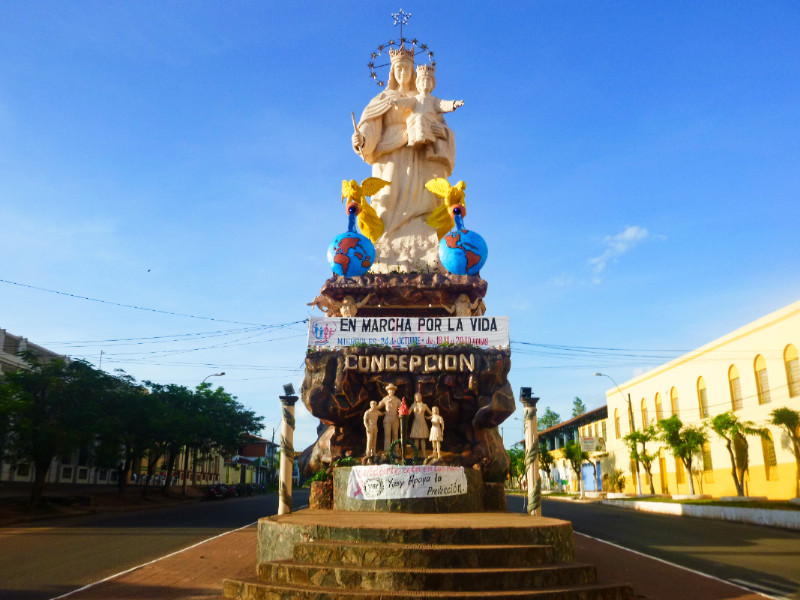 WAKING WELL AFTER dawn at Cerro Cora, nothing had totally dried but felt a little better than last night. The breeze was stirring the luminous sunlit leaves against a backdrop of tropical blue. It was still early, 8am, but already I could feel the heat building. By the time I’d packed away, I was soaking with sweat and sat in the cool
WAKING WELL AFTER dawn at Cerro Cora, nothing had totally dried but felt a little better than last night. The breeze was stirring the luminous sunlit leaves against a backdrop of tropical blue. It was still early, 8am, but already I could feel the heat building. By the time I’d packed away, I was soaking with sweat and sat in the cool 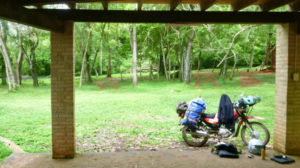 shade of a concrete picnic shelter that seemed to channel the breeze and create its own wind tunnel. Even so, I considered staying another night to bask in the peaceful nature of the place. There was electricity here but the water for the showers was off. The river flowed fast and brown and who knows how deep. It would be hot and what would I do all day apart from hide from mosquitos?
shade of a concrete picnic shelter that seemed to channel the breeze and create its own wind tunnel. Even so, I considered staying another night to bask in the peaceful nature of the place. There was electricity here but the water for the showers was off. The river flowed fast and brown and who knows how deep. It would be hot and what would I do all day apart from hide from mosquitos?
Route 5 continues straight and smooth. Most motorcycles coast down the hard shoulder. Riders without helmets tend to travel slower because the wind around the eyes and ears gets violent with speed. I travel on the main highway glancing in the mirrors to dive out of the way of any speeding traffic. Staying on the main highway also means less of a chance of a puncture from loose debris as the car tyres keep the road swept clean. Deep potholes appear every few kilometres, usually on the nearside wheel track, so vigilance is needed for self-preservation.
Police checkpoints are frequent too. Small squads of military looking personnel stationed around road cones and huts. I slow to a jogging pace and give a gringo wave but none of them bother me. I remind myself to hide the bulk of my cash just in case I get stopped further on by a ‘fishing’ officer.
The Paraguayan air thickens with humidity and comes to the boil. I stop to take off my fleece and ride in t-shirt and jeans but there is little improvement. I start to get hungry and had already passed the disappointing looking town of Yby Yau so pressed on to Horqueta. The sky blackens from the north and the temperature begins to plummet. I don my fleece and zip it up to my neck but it doesn’t stop me shivering. Rain looks and feels imminent as I reach Horqueta and turn right to follow the chaotic flow of motorcycles over the cobbles toward the centre looking for a Cafe and avoiding collisions at the same time.
Passing the central plaza, I hang a U-turn thinking I had spotted the only cafe in Town. Raindrops drive me quickly through the glass doors. Ice cream is all they have and the small saloon is packed with teens.
The vendor didn’t understand “Vanilla” so I settled for Mint. It was OK, I was out of the rain that seemed to stop as soon as I stepped through the door. Concepción was only 40km away but the clouds looked pregnant with storm. Checking the map, Hotel e Camping Quinta del Sol was only 7km away. I decided to head for that as an option and leave the decision whether I continued to Concepcion up to the Paraguayan gods.
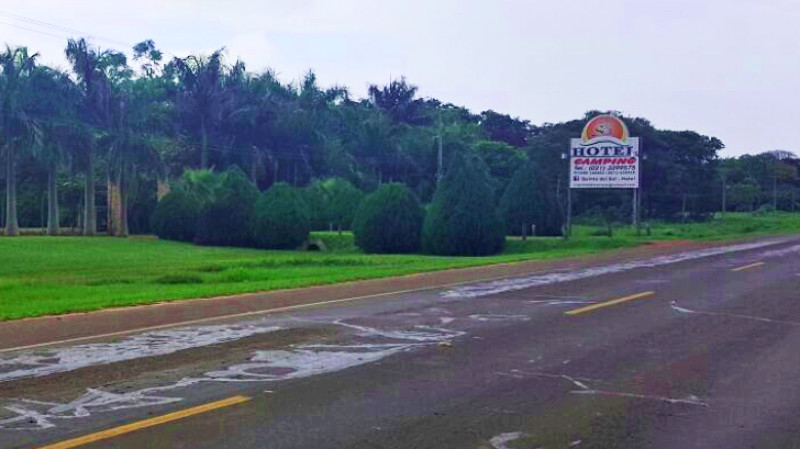 Back on Route 5, the misty drizzle clouded my visor, blew through my fleece and cooled me to my bones as I moved through the watery air. I stopped to check the map and found I’d already missed the giant sign at the entrance to Quinta del Sol by about a kilometre. I never like turning back but felt too cold to plough onto Concepción. I swung the bike around back to Quinta to call it a day. I couldn’t face the cold damp trip and then have to search for somewhere to stay.
Back on Route 5, the misty drizzle clouded my visor, blew through my fleece and cooled me to my bones as I moved through the watery air. I stopped to check the map and found I’d already missed the giant sign at the entrance to Quinta del Sol by about a kilometre. I never like turning back but felt too cold to plough onto Concepción. I swung the bike around back to Quinta to call it a day. I couldn’t face the cold damp trip and then have to search for somewhere to stay.
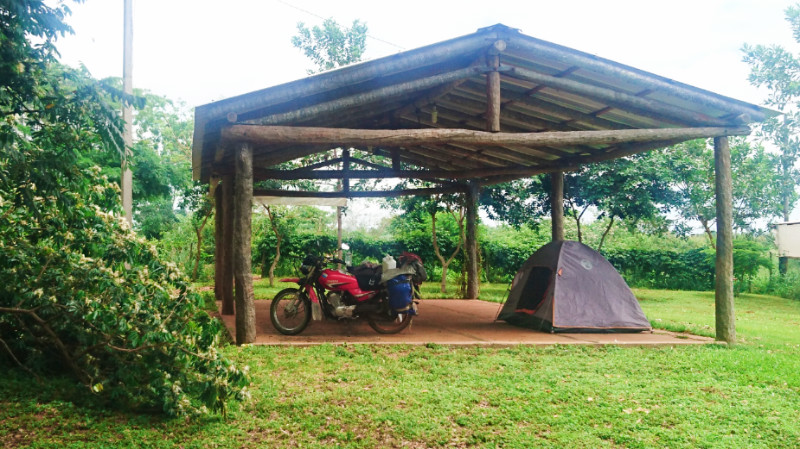 Feliciano showed me around the enormous grounds with well-spaced picnic shelters, a farm, two soccer pitches, pond and woods. I selected the large picnic shelter tucked privately away behind a large tree and pitch my tent inside. The air was still cold and damp. Mizzle drifted in under the shelter necessitating the rain fly over the inner which tends to make the air stuffy inside. even though it’s cold. I skipped the shower and had an early night as soon as it got dark.
Feliciano showed me around the enormous grounds with well-spaced picnic shelters, a farm, two soccer pitches, pond and woods. I selected the large picnic shelter tucked privately away behind a large tree and pitch my tent inside. The air was still cold and damp. Mizzle drifted in under the shelter necessitating the rain fly over the inner which tends to make the air stuffy inside. even though it’s cold. I skipped the shower and had an early night as soon as it got dark.
I stayed for 5 nights, The site was a haven of tranquillity apart from the weekends when football games were followed by party time at the picnic shelter next to me. Quinta seemed a different reality to me. Alien, Planet insect to start with. Feeling them all the time either walking over my skin or flying into me. The small mosquitos would somehow still bite my knees through my jeans. the weather would be high thirties and then plummet within minutes under a stroboscopic electric sky. the sudden wind would cave the tent in, unsecured due to the concrete base being a barrier for using tent pegs. I removed the rain fly to allow the wind to pass through. It turned out a refreshing strategy and although some moisture would find its way in during a storm, not enough to really soak anything.
 Communicating was difficult but Feliciano and Rita were really friendly and generous and brought me food, even if I was hidden away out of sight on my PC. Everyone felt like family and I could hardly tell who were staff and who were guests.
Communicating was difficult but Feliciano and Rita were really friendly and generous and brought me food, even if I was hidden away out of sight on my PC. Everyone felt like family and I could hardly tell who were staff and who were guests.
Leaving on the Saturday was hard only because of the late Friday night music booming out of a car converted into a PA system about 50 feet away. I felt tired already and I’d only just had breakfast.
Route 5 again. Straight and repetitive. Police checkpoints, sporadic houses and trees lining the edges. A conveyor belt of monotonous scenery scrolling past deadened senses.
 An unspectacular low rise town crept out of the horizon. I recognised the roundabout I’d just crossed by the map I’d checked earlier and I expected the place to be much more ‘City Centre’ like. Described as an old colonial town brought disappointment. Like a dilapidated cowboy town now paved over and the horses traded for scooters. There was traffic but not dense and it was frustratingly slow. No competing for position like most cities. The
An unspectacular low rise town crept out of the horizon. I recognised the roundabout I’d just crossed by the map I’d checked earlier and I expected the place to be much more ‘City Centre’ like. Described as an old colonial town brought disappointment. Like a dilapidated cowboy town now paved over and the horses traded for scooters. There was traffic but not dense and it was frustratingly slow. No competing for position like most cities. The 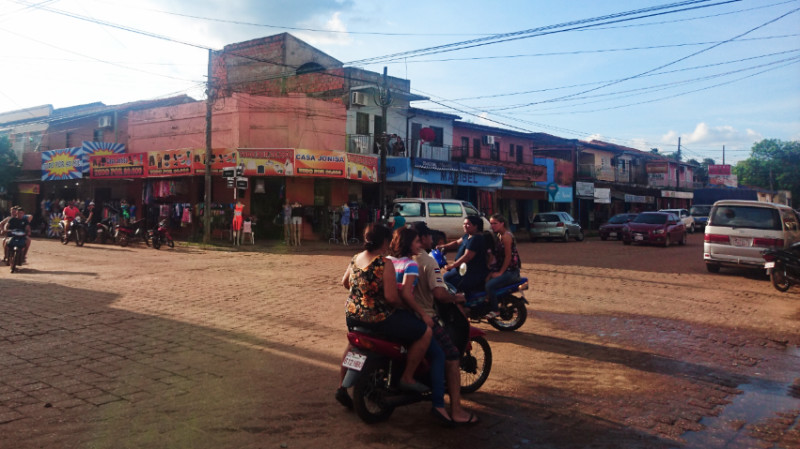 grid system made for hundreds of crossroad that had no give way signs so the speed of the traffic made sense for life preservation. The bravest went over first and it’s every man form himself. Eye contact is a weakness. Once established, they’ll continue across your path knowing you’ll brake. Use peripheral vision and look straight ahead and the traffic swerves around you like you’re a blind man. The traffic was dominated by scooter style motorcycles. Whole families on one, toddlers on laps, teen girls on others steering with one hand, texting with the other.
grid system made for hundreds of crossroad that had no give way signs so the speed of the traffic made sense for life preservation. The bravest went over first and it’s every man form himself. Eye contact is a weakness. Once established, they’ll continue across your path knowing you’ll brake. Use peripheral vision and look straight ahead and the traffic swerves around you like you’re a blind man. The traffic was dominated by scooter style motorcycles. Whole families on one, toddlers on laps, teen girls on others steering with one hand, texting with the other.
 The city of Concepcion is the biggest small town I’d ever seen. Hexagon slabs give a smoother ride here than Corumba, Brazil but are rucked up and rugged in some places. some suburbs have only dirt road. The main routes keep their smooth and wide asphalt.
The city of Concepcion is the biggest small town I’d ever seen. Hexagon slabs give a smoother ride here than Corumba, Brazil but are rucked up and rugged in some places. some suburbs have only dirt road. The main routes keep their smooth and wide asphalt.
 I made my way to Hostel Las Aguas., just off the main road but far enough to be away from the traffic noise. Ioverlander had it down as a camping hostel but I was denied that option and instead, took a bunk in the 5-bed Dorm and unloaded the bike stacking the luggage in one corner. Manuel speaks a little English and points out roughly where the centre is in relation to the port on the bank of the River Paraguay, carrying on eastwards to the mercado area. As far as attractions go, there is one museum but that’s closed at the weekend.
I made my way to Hostel Las Aguas., just off the main road but far enough to be away from the traffic noise. Ioverlander had it down as a camping hostel but I was denied that option and instead, took a bunk in the 5-bed Dorm and unloaded the bike stacking the luggage in one corner. Manuel speaks a little English and points out roughly where the centre is in relation to the port on the bank of the River Paraguay, carrying on eastwards to the mercado area. As far as attractions go, there is one museum but that’s closed at the weekend.
Setting off over the grid of the city in the warm morning air revealed not much to look at. Overgrown plazas, rutted cobbled streets, dirt tracks, small stores and family homes.
 There’s no tourism in Concepcion. The port area on the river looked in ruins although it still shows signs of activity, small ferries taking people across the river. The abandoned commercial building hints at a city in decline but really it’s the effect of the developing national road system
There’s no tourism in Concepcion. The port area on the river looked in ruins although it still shows signs of activity, small ferries taking people across the river. The abandoned commercial building hints at a city in decline but really it’s the effect of the developing national road system 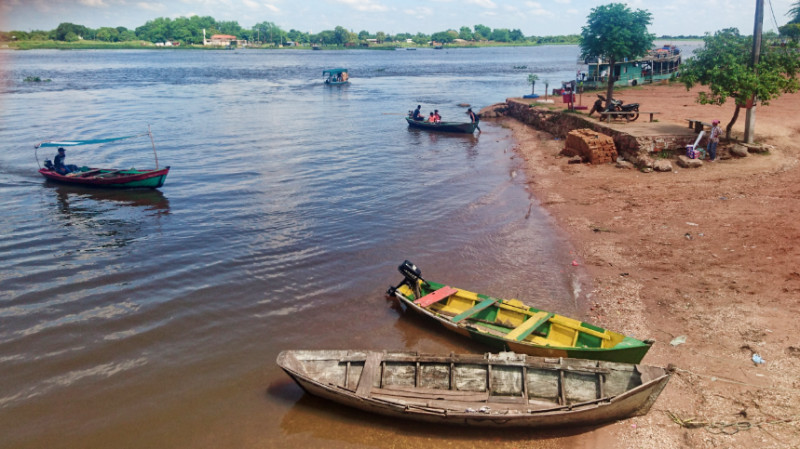 stealing the trade from the river. The people here are cheerful and friendly and the modest looking town bustles with activity and commerce.
stealing the trade from the river. The people here are cheerful and friendly and the modest looking town bustles with activity and commerce.
Parking my bike at an intersection I walked south and found a huge  hardware store. I dipped in an bought a padlock to replace one lost in Bonito and an extension lead. Returning to my bike I became conscious that all the intersections look the same and I wasn’t sure how far I walked or even certain I was heading in the right direction. The sun was overhead and gave no clue on my orientation. Two blocks further, I spotted it. I had walked further than I thought and realised if I don’t note the street names of the intersection, I’d have big problems locating my bike in the thousands of others parked at hundreds of intersections just like this one.
hardware store. I dipped in an bought a padlock to replace one lost in Bonito and an extension lead. Returning to my bike I became conscious that all the intersections look the same and I wasn’t sure how far I walked or even certain I was heading in the right direction. The sun was overhead and gave no clue on my orientation. Two blocks further, I spotted it. I had walked further than I thought and realised if I don’t note the street names of the intersection, I’d have big problems locating my bike in the thousands of others parked at hundreds of intersections just like this one.
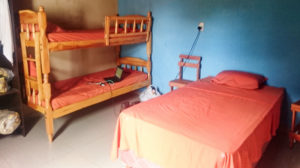 Flicking on the air conditioner and snuggling down on a soft mattress had been a forgotten luxury after the camping mat and concrete base of Quinta and despite the racket of fireworks and badly played brass band music somewhere out on the streets, celebrating the ousting of a corrupt local official, I slept soundly.
Flicking on the air conditioner and snuggling down on a soft mattress had been a forgotten luxury after the camping mat and concrete base of Quinta and despite the racket of fireworks and badly played brass band music somewhere out on the streets, celebrating the ousting of a corrupt local official, I slept soundly.
At dawn, the church bells told me what the time was, 6am then five minutes later, 6am again. In case you missed it the first time. The bell strikes a single beat for half past the hour.
 After the 9am peel and the snooze reminder 5 minutes later, I went down to breakfast to find a guest at breakfast. “Habla Ingles?” “Si.” A gringo journalist from New York, here in Concepción to research and write about the Chaco war with Bolivia. I asked him about the facilities and topology west of the River. He told me the same as Manuel yesterday. Nothing much there, even at Pozo Colorado. Some call it “the green hell,” the Chaco. Flat humid wetlands stretching to the western horizon with barely an elevation change of half a metre. Sure it would be interesting to see but not hundreds of kilometres of it.
After the 9am peel and the snooze reminder 5 minutes later, I went down to breakfast to find a guest at breakfast. “Habla Ingles?” “Si.” A gringo journalist from New York, here in Concepción to research and write about the Chaco war with Bolivia. I asked him about the facilities and topology west of the River. He told me the same as Manuel yesterday. Nothing much there, even at Pozo Colorado. Some call it “the green hell,” the Chaco. Flat humid wetlands stretching to the western horizon with barely an elevation change of half a metre. Sure it would be interesting to see but not hundreds of kilometres of it.
My eyes now look east of the river and southwards to Asunción.
Relaxing in my room one afternoon, There’s a knock at the door. Manuel is there and an old Englishman is behind him. “Hello, I heard there was an Englishman in Goncepcion arrived on a bike from Peru, I hope you don’t mind me interupting but I’m interested in your story…” His excitement was contagious and it was refreshing to speak with no language barrier to someone from Swindon, only twenty or thirty miles from my old foreclosed home in Wiltshire.
John, is his name and he grew up in Paraguay in the 50s in one of the Bruderhof communities that settled in the Chaco with help from the Mennonites and later moved to Itacurubi del Rosario. I was as interested in his story as he was in mine. After a cup of tea and a good old fashioned chat, we exchanged WhatsApp numbers and promised to meet again… perhaps take a trip up the river on a supply boat slowly being killed off by the new roads… or perhaps stay a days at his home in the rustic village of Belen…
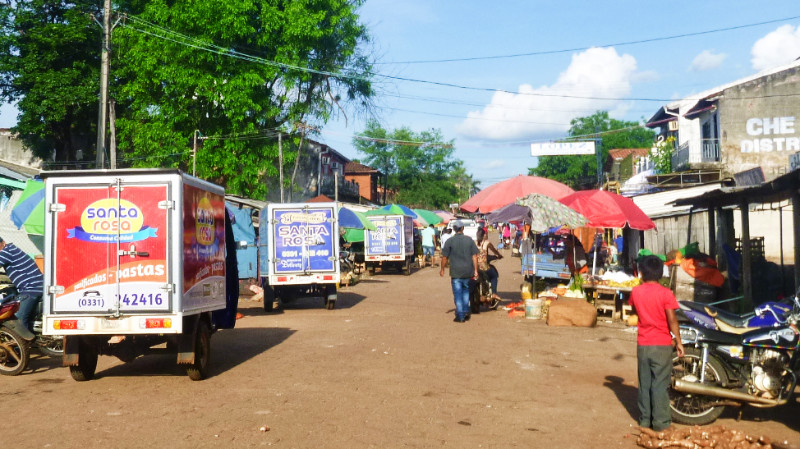

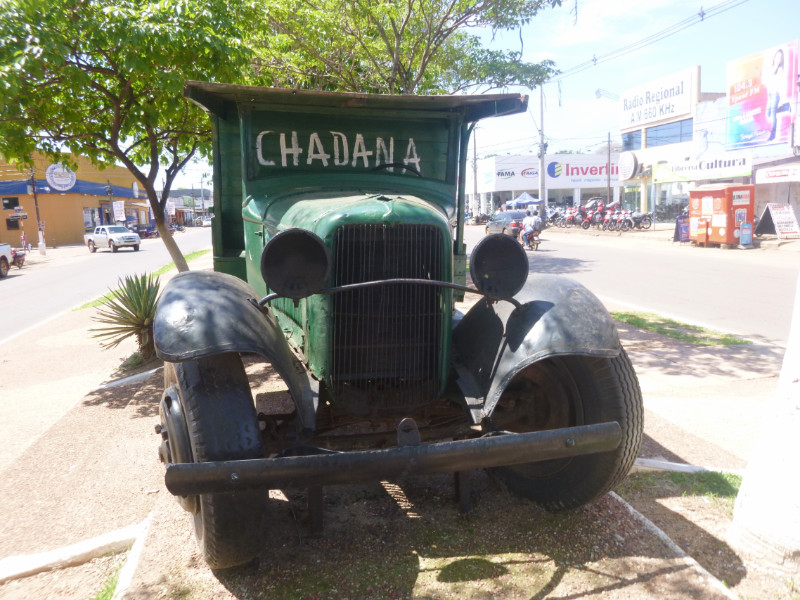
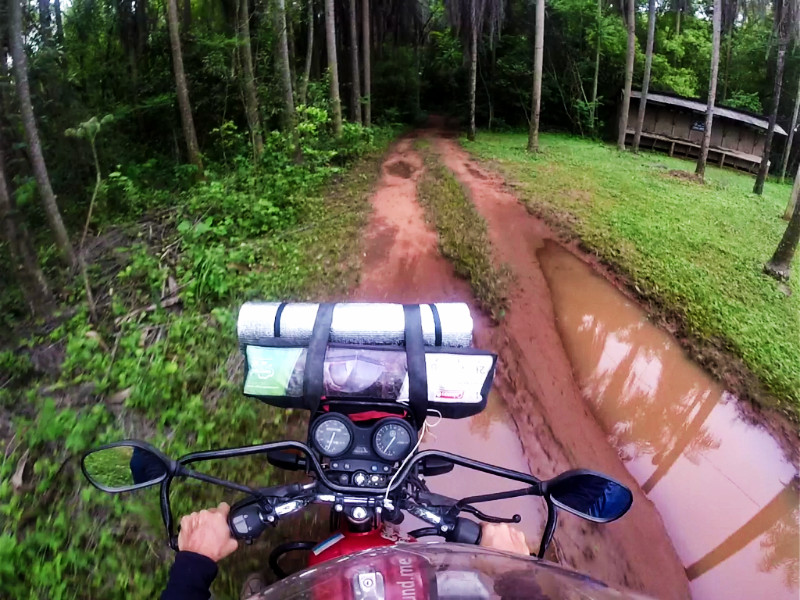 THE STORMY DAY at Pousada Zamora was followed by bright, dry morning sunshine. Young people were at breakfast. Leonardo, Marisa’s grandson took an interest in the bike and my trip. He could speak a little English so I was a little later leaving than I expected. The forecasted thunder looked absent if not late arriving. In the United States, they’d call it “partly cloudy.” And I set off with my rain gear firmly packed away.
THE STORMY DAY at Pousada Zamora was followed by bright, dry morning sunshine. Young people were at breakfast. Leonardo, Marisa’s grandson took an interest in the bike and my trip. He could speak a little English so I was a little later leaving than I expected. The forecasted thunder looked absent if not late arriving. In the United States, they’d call it “partly cloudy.” And I set off with my rain gear firmly packed away.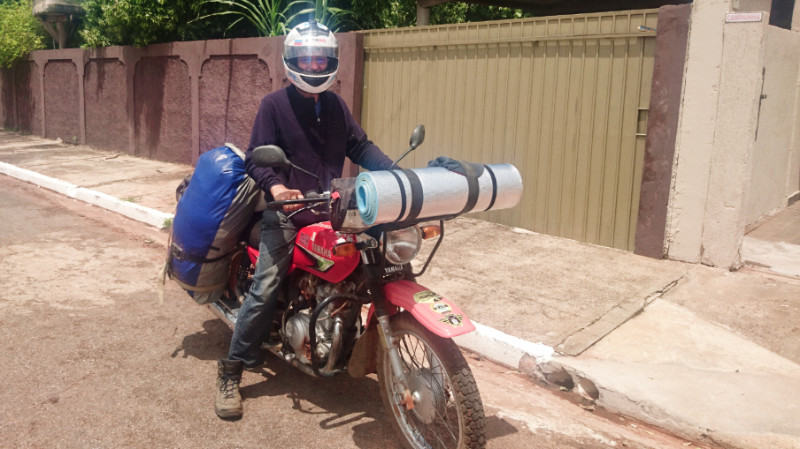 The roads are straight and smooth and farmland stretches to every horizon. Gigantic silos dwarf the Juggernauts waiting to be loaded with whatever’s in them. Villages are few and far between. Vista Alegre looks like a frontier town but presents me with a modern fuel station just at the exit before releasing me onto asphalt bisecting more flat farmland.
The roads are straight and smooth and farmland stretches to every horizon. Gigantic silos dwarf the Juggernauts waiting to be loaded with whatever’s in them. Villages are few and far between. Vista Alegre looks like a frontier town but presents me with a modern fuel station just at the exit before releasing me onto asphalt bisecting more flat farmland.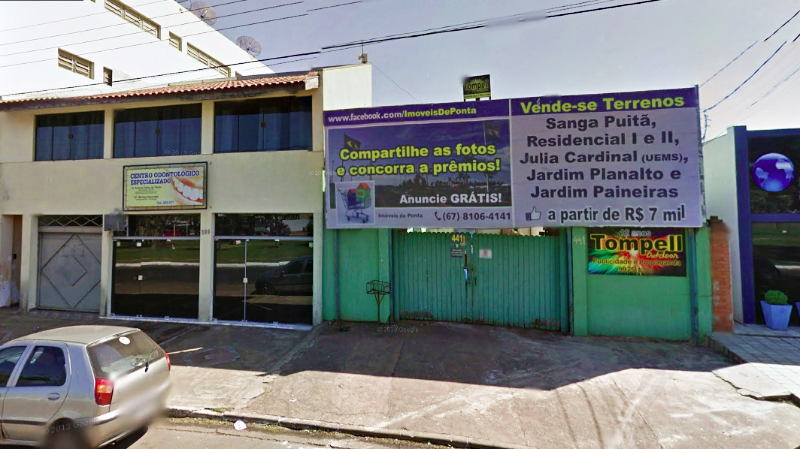 I need some WiFi to search for accommodation and soon reach the giant malls that the Brazilians invade for cheap tax-free electronics. The border is simply a line on a map – invisible in this merging of two towns. there is no border control at all and the malls stand with their toes on the border beckoning the overtaxed Brazilians with their quality discount fare from China. Burger King embeds itself in a parade away from where I can watch the bike and McDonalds ideally placed is bulging with impenetrable queues has a strong WiFi signal radiating across the car park, unfortunately, locked down by a password.
I need some WiFi to search for accommodation and soon reach the giant malls that the Brazilians invade for cheap tax-free electronics. The border is simply a line on a map – invisible in this merging of two towns. there is no border control at all and the malls stand with their toes on the border beckoning the overtaxed Brazilians with their quality discount fare from China. Burger King embeds itself in a parade away from where I can watch the bike and McDonalds ideally placed is bulging with impenetrable queues has a strong WiFi signal radiating across the car park, unfortunately, locked down by a password.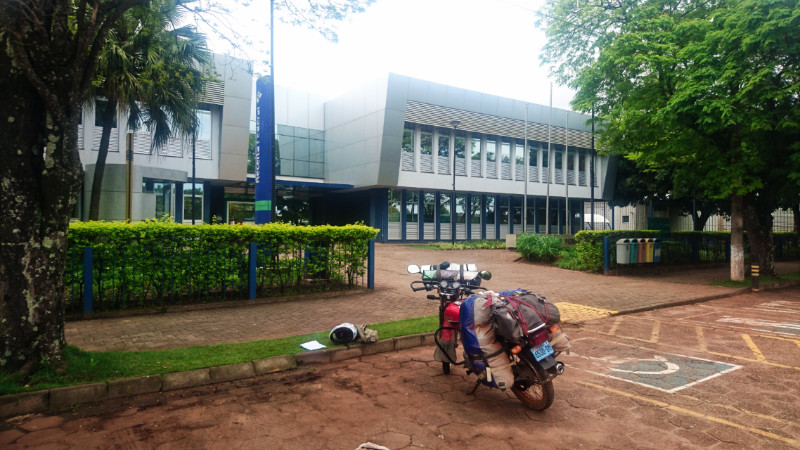 Although the hostel is close to the main road, my room is quiet and I get a good night’s sleep. In the morning, I use up all the time before the noon check-out transferring cash between cards ready to withdraw from ATMs in Paraguay. I decide to ignore the holiday warning and head to the first stop Brazilian Immigration at the airport 2km away. a solitary figure in a booth in an empty terminal is the man I’m looking for. Entrada o Saida. Saida… Asuncion. Stamp and I’m off to Aduanas near the Frontier Hotel. We fumble with language a while and I receive an exit document for the bike.
Although the hostel is close to the main road, my room is quiet and I get a good night’s sleep. In the morning, I use up all the time before the noon check-out transferring cash between cards ready to withdraw from ATMs in Paraguay. I decide to ignore the holiday warning and head to the first stop Brazilian Immigration at the airport 2km away. a solitary figure in a booth in an empty terminal is the man I’m looking for. Entrada o Saida. Saida… Asuncion. Stamp and I’m off to Aduanas near the Frontier Hotel. We fumble with language a while and I receive an exit document for the bike. Next Paraguay Migraciones near the China Mall. Stamp Vamos and finally to Paraguay Aduanas to await their Siesta. Apparently, this side of the road, in Paraguay, is an hour ahead so it cuts an hour off my wait.
Next Paraguay Migraciones near the China Mall. Stamp Vamos and finally to Paraguay Aduanas to await their Siesta. Apparently, this side of the road, in Paraguay, is an hour ahead so it cuts an hour off my wait.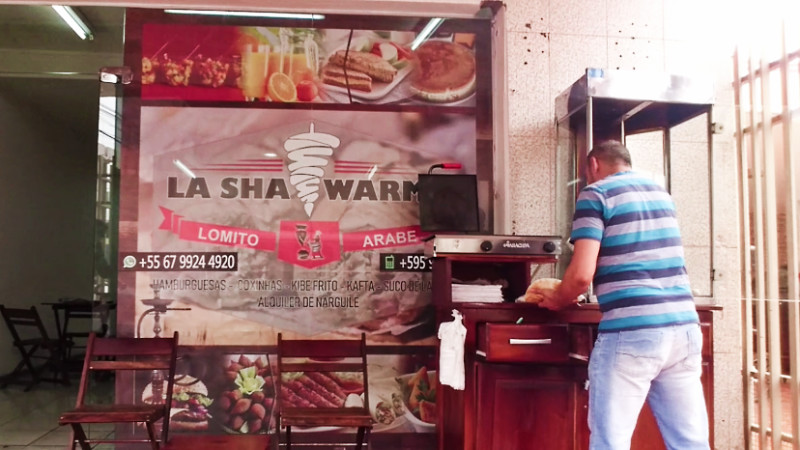
 By now it’s mid-afternoon in Paraguay and just after lunchtime over the road in Brazil and I settle down for my first lunch in Paraguay, a schwarma on a busy pavement outside a cafe. Cerro Cora is only 40km Southwest. I read about it on ioverlander. A free campsite in a national park. and after lunch, I weave around the grid of Pedro Juan Caballero toward Route 5. Once on the road, I click up to top gear and sit on the straight flat road reeling in the miles toward Concepcion.
By now it’s mid-afternoon in Paraguay and just after lunchtime over the road in Brazil and I settle down for my first lunch in Paraguay, a schwarma on a busy pavement outside a cafe. Cerro Cora is only 40km Southwest. I read about it on ioverlander. A free campsite in a national park. and after lunch, I weave around the grid of Pedro Juan Caballero toward Route 5. Once on the road, I click up to top gear and sit on the straight flat road reeling in the miles toward Concepcion. The clouds to my right loom big and grey but don’t look capable of more than a threat of rain but a few specks drive me into the shelter of a gas station and cafe a minute further down the road for an Empanada and Coke. The threat comes to nothing, the clouds, impotent and silent, pass quietly overhead revealing the fluffy silver blanket at higher altitudes.
The clouds to my right loom big and grey but don’t look capable of more than a threat of rain but a few specks drive me into the shelter of a gas station and cafe a minute further down the road for an Empanada and Coke. The threat comes to nothing, the clouds, impotent and silent, pass quietly overhead revealing the fluffy silver blanket at higher altitudes.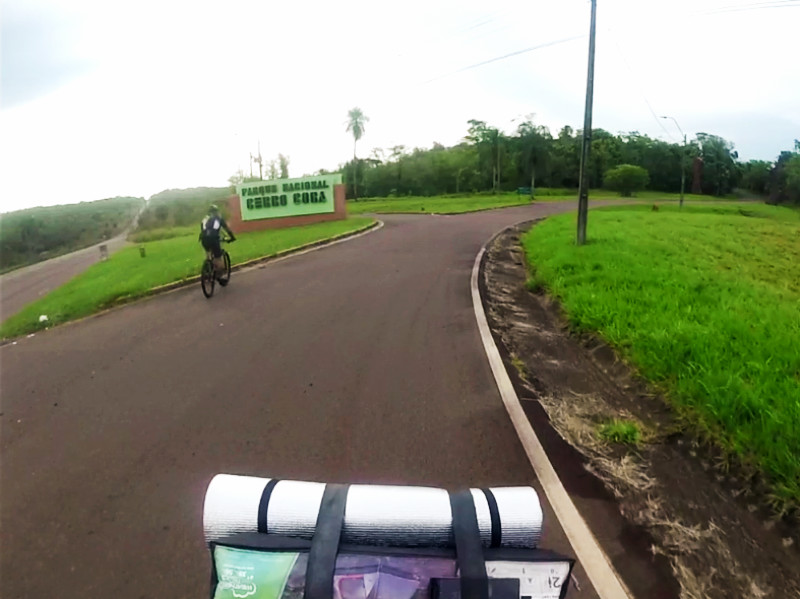 Cerro Cora has a visitor centre with a little man that appears out of thin air to attend to anyone wandering in. Naturally, he speaks no English but hinting to my camping arrangement parked outside, he gets me to fill a form and shows me the map of the area. I ask who the portrait of the imposing figure is, dominating the museum wall and he points to the Spanish text beneath. I look at the picture for two seconds then leave.
Cerro Cora has a visitor centre with a little man that appears out of thin air to attend to anyone wandering in. Naturally, he speaks no English but hinting to my camping arrangement parked outside, he gets me to fill a form and shows me the map of the area. I ask who the portrait of the imposing figure is, dominating the museum wall and he points to the Spanish text beneath. I look at the picture for two seconds then leave.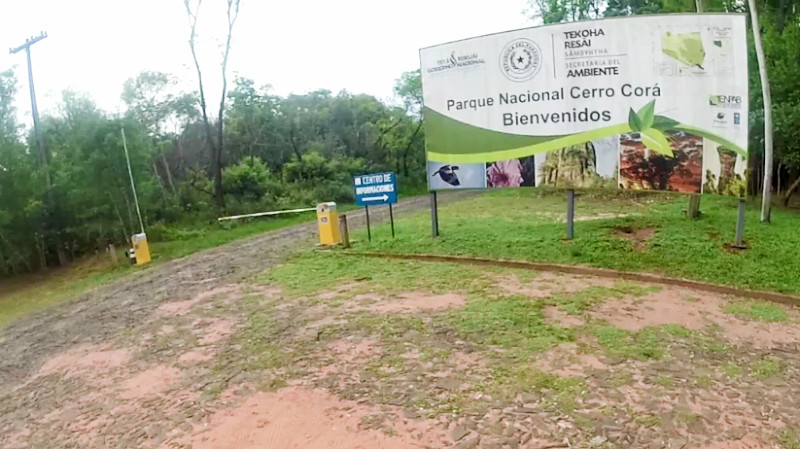 The 4 cyclists I passed on the way in bustle around my bike jabbering in supersonic Spanish. They’ve cycled 40km from Ponta Pora and decided to camp here in the park. We chat a little best we can and they set off along the cobbled track. I pass them on the first campground, which they appear to settle for and take off further into the woods along a narrow toward the river.
The 4 cyclists I passed on the way in bustle around my bike jabbering in supersonic Spanish. They’ve cycled 40km from Ponta Pora and decided to camp here in the park. We chat a little best we can and they set off along the cobbled track. I pass them on the first campground, which they appear to settle for and take off further into the woods along a narrow toward the river. It’s near feeding time for the biting insects and I quickly get the tent up in a small glade by the river. I’m glazed with sweat and the humidity prevents cooling by evaporation. My sweat feels more like cooking oil because of it. The shower block is a hundred metres away but do I really want to shower with a thousand alien species from the insect world?
It’s near feeding time for the biting insects and I quickly get the tent up in a small glade by the river. I’m glazed with sweat and the humidity prevents cooling by evaporation. My sweat feels more like cooking oil because of it. The shower block is a hundred metres away but do I really want to shower with a thousand alien species from the insect world?
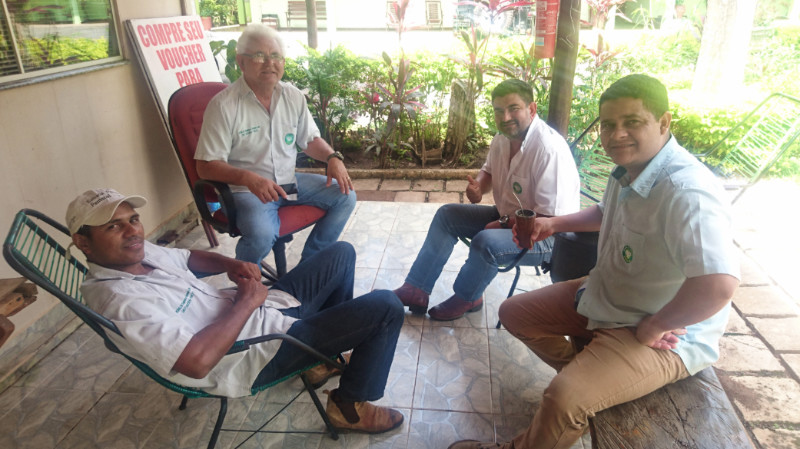 THE DAY HAD come. Monday, the virtual line I had marked in the imaginary sand. Time to leave. Seventy days might be a record stay for Pousada Do Peralta. My shiny new bank card paid the bill plus booked the Rio Sucuri tour, which I thought was close to Jardim but no, the map put it closer to Bonito, a lot closer. I’d already packed up and
THE DAY HAD come. Monday, the virtual line I had marked in the imaginary sand. Time to leave. Seventy days might be a record stay for Pousada Do Peralta. My shiny new bank card paid the bill plus booked the Rio Sucuri tour, which I thought was close to Jardim but no, the map put it closer to Bonito, a lot closer. I’d already packed up and  loaded the bike needing another night in Bonito and was loath to unpack again for camping another night so, while I still had WiFi, I combed the booking sites for a hostel. Bingo! Papaya Hostel downtown. And thus, I pulled up outside Papaya Hostel barely warming up the bike enough to put the choke back in. One thing for sure, after riding a bare bike around the town, the tent on the bars disturbs the handling greatly.
loaded the bike needing another night in Bonito and was loath to unpack again for camping another night so, while I still had WiFi, I combed the booking sites for a hostel. Bingo! Papaya Hostel downtown. And thus, I pulled up outside Papaya Hostel barely warming up the bike enough to put the choke back in. One thing for sure, after riding a bare bike around the town, the tent on the bars disturbs the handling greatly.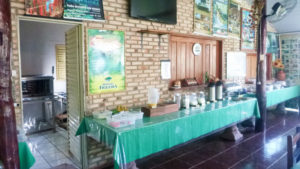 “Compact and Bijou” the real estate agents would call Papaya Hostel. Small, in other words. To be fair, I’d seen smaller hostels but this one had so many more facilities compacted into its footprint. The main thing for me was It had my top requirements: secure parking to save me unpacking, power, wifi and free breakfast all for 35R, ten less than Peralta.
“Compact and Bijou” the real estate agents would call Papaya Hostel. Small, in other words. To be fair, I’d seen smaller hostels but this one had so many more facilities compacted into its footprint. The main thing for me was It had my top requirements: secure parking to save me unpacking, power, wifi and free breakfast all for 35R, ten less than Peralta.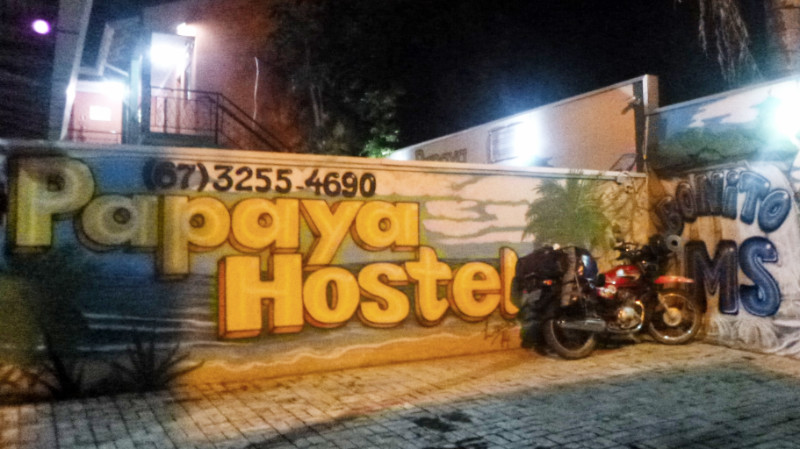 The Senhora on reception wore a stoic face with a disposition of busy-ness and my attempting to pay for the dorm felt like I was being a minor inconvenience. I only had 50R notes and she needed 35 but had no change so told me to pay tomorrow. the receptionist led to the small courtyard, paused, looked up at the balcony and shouted “Horsey,” making me jump A a stocky woman with a cheerful face emerged from an upstairs doorway and beckoned me up to the rooms. ‘Horsey’ helped me choose a bed and locker in the dorm she was currently cleaning.
The Senhora on reception wore a stoic face with a disposition of busy-ness and my attempting to pay for the dorm felt like I was being a minor inconvenience. I only had 50R notes and she needed 35 but had no change so told me to pay tomorrow. the receptionist led to the small courtyard, paused, looked up at the balcony and shouted “Horsey,” making me jump A a stocky woman with a cheerful face emerged from an upstairs doorway and beckoned me up to the rooms. ‘Horsey’ helped me choose a bed and locker in the dorm she was currently cleaning.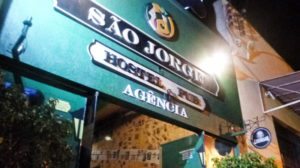 journey after being so long stranded by circumstance. Bonito is surprisingly short of good bars open on a Monday so I found myself back at the Sao Jorge. It looked half closed. The bar shares the long wide entrance to the Hostel and nestled quietly in the shadows at the back of the building. At the entrance, a young guy sat at the desk behind a laptop and a girl was standing next to him. Their faces a reflection of work instead of pleasure.
journey after being so long stranded by circumstance. Bonito is surprisingly short of good bars open on a Monday so I found myself back at the Sao Jorge. It looked half closed. The bar shares the long wide entrance to the Hostel and nestled quietly in the shadows at the back of the building. At the entrance, a young guy sat at the desk behind a laptop and a girl was standing next to him. Their faces a reflection of work instead of pleasure. James and Holly were Aussies only just engaged a week or so back on an earlier leg of their trip and, as it happened, had completed the Rio Sucuri tour that day. When James returned we shared a drink and experiences on the road. The air was cooler after the storm and the couple were still wearing their wet gear from the tour. They were the same age as my sons but felt more like my own peers. Apparently, I shared James’ father’s adventurous spirit.
James and Holly were Aussies only just engaged a week or so back on an earlier leg of their trip and, as it happened, had completed the Rio Sucuri tour that day. When James returned we shared a drink and experiences on the road. The air was cooler after the storm and the couple were still wearing their wet gear from the tour. They were the same age as my sons but felt more like my own peers. Apparently, I shared James’ father’s adventurous spirit. After a solid night’s sleep in a soft bed for the first time in months followed by a filling breakfast, I was riding the rough rust-red dirt track to Sucuri. Hot Brazilian air ruffled my t-shirt and should have felt cooling to my bare arms. It’s a slow dusty 20km that makes the journey over stony potholes and loose corrugations feel longer than it should.
After a solid night’s sleep in a soft bed for the first time in months followed by a filling breakfast, I was riding the rough rust-red dirt track to Sucuri. Hot Brazilian air ruffled my t-shirt and should have felt cooling to my bare arms. It’s a slow dusty 20km that makes the journey over stony potholes and loose corrugations feel longer than it should.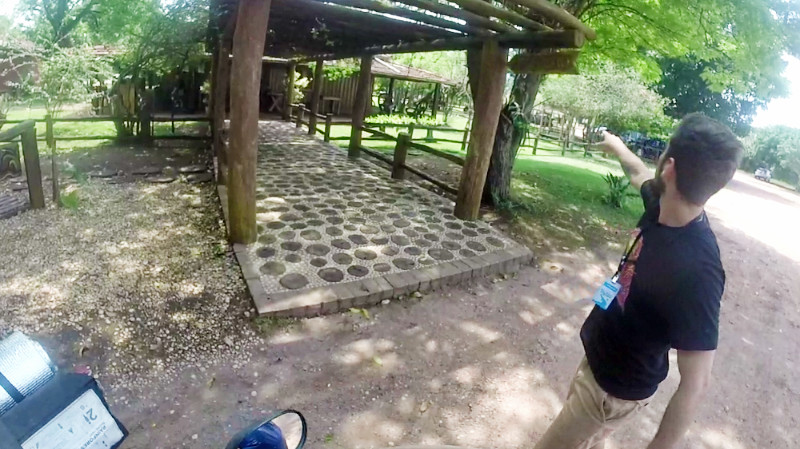 The Rio Sucuri Farm is beautifully well kept. Vinicio welcomed me warmly in English and directed me to a safe parking spot in the shade for the loaded bike. I was two hours early so I could relax, perhaps take an early lunch, reflect and then smoke James’ joint.
The Rio Sucuri Farm is beautifully well kept. Vinicio welcomed me warmly in English and directed me to a safe parking spot in the shade for the loaded bike. I was two hours early so I could relax, perhaps take an early lunch, reflect and then smoke James’ joint. When we reached the river, there seemed to be no rush to get in. Instead, people were standing around chatting. I’d wait in the shade rather than the water. I wasn’t too hot and I’d start to feel impatient if I was ready to go waiting for the rest of the group.
When we reached the river, there seemed to be no rush to get in. Instead, people were standing around chatting. I’d wait in the shade rather than the water. I wasn’t too hot and I’d start to feel impatient if I was ready to go waiting for the rest of the group.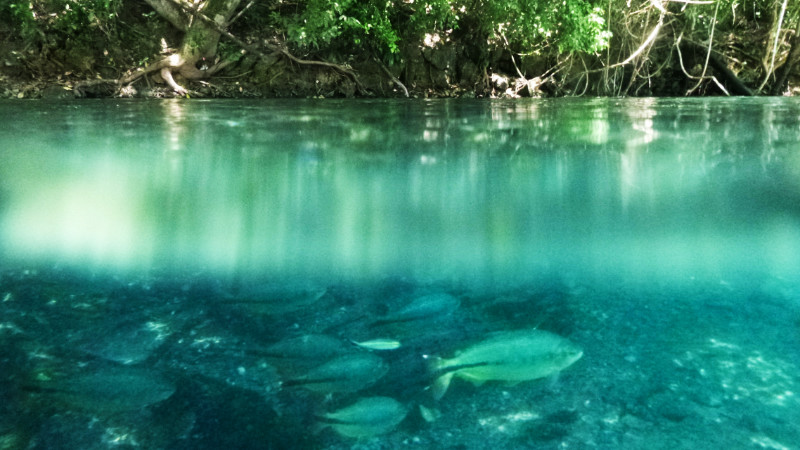 Drifting down the river, the water felt cold as it seeped between skin and neoprene and the sun did its best between the dappled shade of the overhanging trees to warm my back through the floatation jacket and wetsuit. the chill was getting to me when we reached the end of the drift
Drifting down the river, the water felt cold as it seeped between skin and neoprene and the sun did its best between the dappled shade of the overhanging trees to warm my back through the floatation jacket and wetsuit. the chill was getting to me when we reached the end of the drift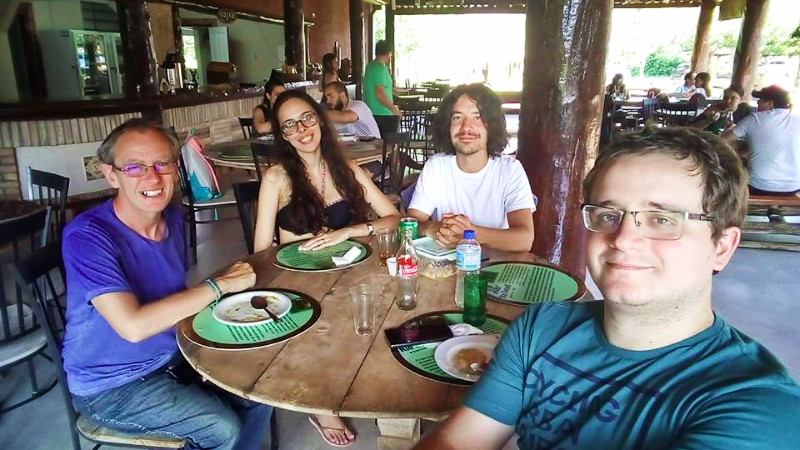 Paulo and Thia were unofficial translators on the tour for me and a young scot named Robbie. They told us later that they had just got married and were on their honeymoon. This was a happy revelation and reason to celebrate in good company. We enjoyed lunch together and agreed to meet at Gruta Azul since my GPS route took me back to Bonito before Jardim.
Paulo and Thia were unofficial translators on the tour for me and a young scot named Robbie. They told us later that they had just got married and were on their honeymoon. This was a happy revelation and reason to celebrate in good company. We enjoyed lunch together and agreed to meet at Gruta Azul since my GPS route took me back to Bonito before Jardim.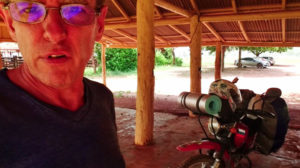 After the bus took away my new friends, I packed up the bike and started back to Bonito as far as a fork in the road sporting large blue signs: left Bonito, Right Jardim! Jardim won the toss and I turned south down the dusty red track. Although it was late in the afternoon, I could feel the radiant sun on my skin, my t-shirt billowing in the breeze as I carved a dusty trail between open fields and farmland. After so long being static, I enjoyed the mixture of sensations between freedom and adventure and the feelings of doubt and anticipation that uncertainty brings. It seems they go hand in hand. If there is no uncertainty, there is no adventure.
After the bus took away my new friends, I packed up the bike and started back to Bonito as far as a fork in the road sporting large blue signs: left Bonito, Right Jardim! Jardim won the toss and I turned south down the dusty red track. Although it was late in the afternoon, I could feel the radiant sun on my skin, my t-shirt billowing in the breeze as I carved a dusty trail between open fields and farmland. After so long being static, I enjoyed the mixture of sensations between freedom and adventure and the feelings of doubt and anticipation that uncertainty brings. It seems they go hand in hand. If there is no uncertainty, there is no adventure.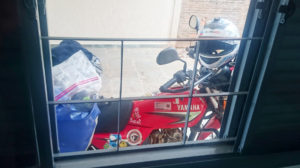 Her name’s Marisa and she showed me all the rooms and, after I pointed to the motorcycle, put me in the triple so I could access my baggage through the window. I was the only guest tonight and thought “Nice trick with the ‘last available’ artificial scarcity tactic, Booking.com.”
Her name’s Marisa and she showed me all the rooms and, after I pointed to the motorcycle, put me in the triple so I could access my baggage through the window. I was the only guest tonight and thought “Nice trick with the ‘last available’ artificial scarcity tactic, Booking.com.”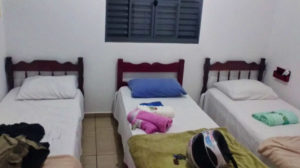 The room was hot and humid but the air conditioner soon brought both down in short order. The three single beds reminded me of Goldilocks and the three bears. I chose the bed that was neither too hard or too soft but just right and slept without covers switching off the air conditioner sometime in the early hours when the cold woke me up.
The room was hot and humid but the air conditioner soon brought both down in short order. The three single beds reminded me of Goldilocks and the three bears. I chose the bed that was neither too hard or too soft but just right and slept without covers switching off the air conditioner sometime in the early hours when the cold woke me up.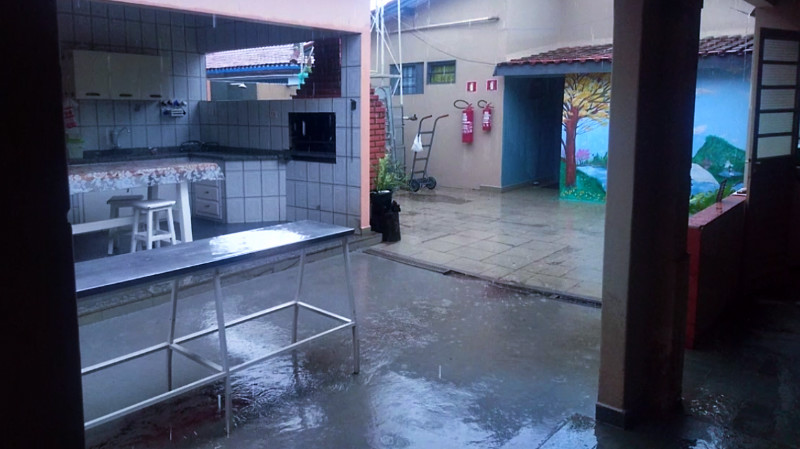
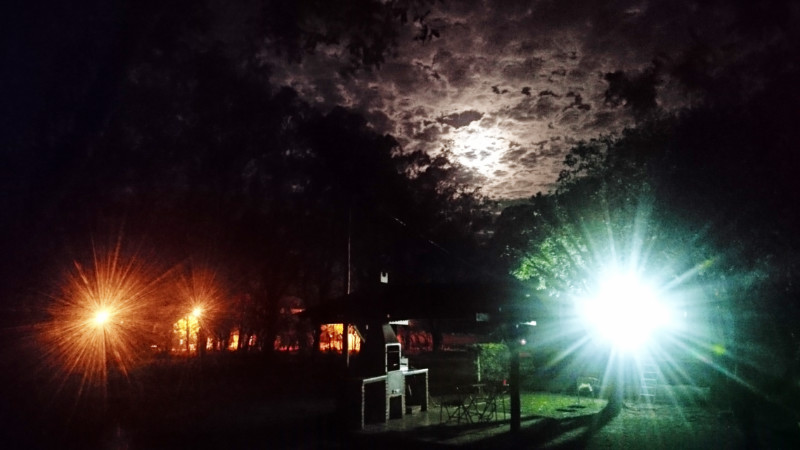 TODAY WOULD HAVE been my 27th wedding anniversary, 5th October. Where would I be now if my wife hadn’t set me free? Where does the time go? My birthday yesterday too. Anyway, there was no way I would think I would be another year older leaving Bonito but that’s the way it goes sometimes.
TODAY WOULD HAVE been my 27th wedding anniversary, 5th October. Where would I be now if my wife hadn’t set me free? Where does the time go? My birthday yesterday too. Anyway, there was no way I would think I would be another year older leaving Bonito but that’s the way it goes sometimes.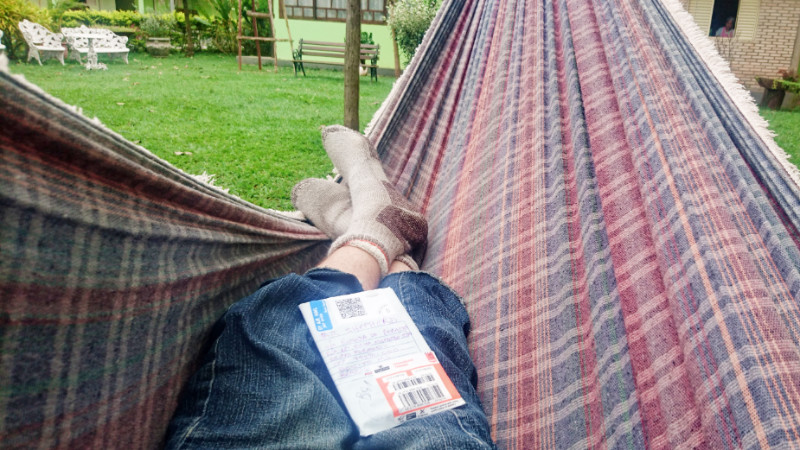 Laying in the hammock under the trees, with the final piece of the puzzle in my hands felt instantly liberating. I could now leave when I wanted, but did I really want to? Pousada Do Peralta felt like home now. Roots were beginning to take hold. Everything I need is here and the staff feel like family. In a way, it would be a wrench to leave.
Laying in the hammock under the trees, with the final piece of the puzzle in my hands felt instantly liberating. I could now leave when I wanted, but did I really want to? Pousada Do Peralta felt like home now. Roots were beginning to take hold. Everything I need is here and the staff feel like family. In a way, it would be a wrench to leave.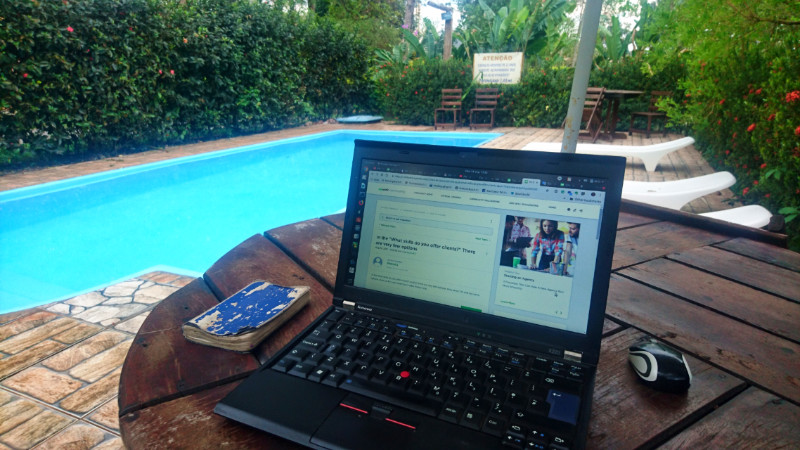 Should the laptops be cheap I could well buy a replacement. What about a camera? what about space on the bike? Yes, it’s a fine balance.
Should the laptops be cheap I could well buy a replacement. What about a camera? what about space on the bike? Yes, it’s a fine balance.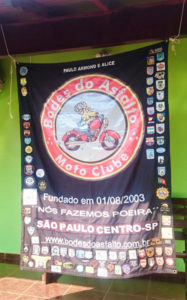 Bonito is noticeably hotter now and stripping off to shorts and t-shirt exposes me to the merciless sandflies and mosquitos. They are so small, I don’t see them around me until its too late so I remain covered as much as possible and suffer the heat.
Bonito is noticeably hotter now and stripping off to shorts and t-shirt exposes me to the merciless sandflies and mosquitos. They are so small, I don’t see them around me until its too late so I remain covered as much as possible and suffer the heat.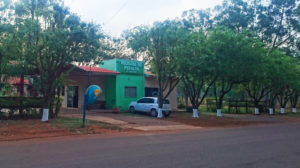 “Chuva” Gian announced with hands up fingers pointing down. That means rain. The sky was still clear but the air felt thick and hot. Vandeia finished his beer and sped off home on his Honda at a quarter past four and Gian returned to the Reception while I stayed racing the dying phone battery to finish my responses. The rain was transported in by heavy black clouds, growling with thunder and washed the heavy air into the ground leaving the evening fresh and clean.
“Chuva” Gian announced with hands up fingers pointing down. That means rain. The sky was still clear but the air felt thick and hot. Vandeia finished his beer and sped off home on his Honda at a quarter past four and Gian returned to the Reception while I stayed racing the dying phone battery to finish my responses. The rain was transported in by heavy black clouds, growling with thunder and washed the heavy air into the ground leaving the evening fresh and clean.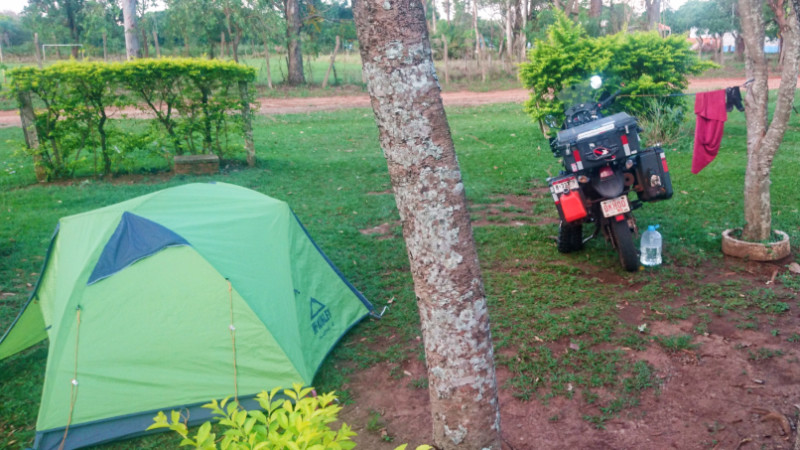 Very few tents come here but Kix Marshall from Kixmarshall.com arrived a week ago and we exchanged notes and took a ride out to the waterfall not so far away. The hot, dry trail billowed red dust clouds with passing traffic and we needed a swim as much to clean up as cool off.
Very few tents come here but Kix Marshall from Kixmarshall.com arrived a week ago and we exchanged notes and took a ride out to the waterfall not so far away. The hot, dry trail billowed red dust clouds with passing traffic and we needed a swim as much to clean up as cool off. “Are there any piranha here?” I asked. We just shrugged, we’d soon find out. It’s the River Formosa where most of the tours are so I’d presume the most dangerous thing would be the waterfall to our right. These things can suck you in and tumble you under the water like giant washing machines without a chance of surfacing before you drown.
“Are there any piranha here?” I asked. We just shrugged, we’d soon find out. It’s the River Formosa where most of the tours are so I’d presume the most dangerous thing would be the waterfall to our right. These things can suck you in and tumble you under the water like giant washing machines without a chance of surfacing before you drown. Wilson and Rose were generous neighbours in a full-sized converted coach, feeding me grand portions of Brazilian cuisine, beer and cachaca. You’d think with names like that they’d be European but no. They hail from Guarulhos, Sao Paulo and travel around with their dog and parrot. They spoke a lot but I understood very little of what was said. Hardly any of the words I hear correspond with what I’ve practised with Pimsleur and Duolingo. I Plod on regardless. Pretty soon I’d be back to wrestling Spanish verbs again.
Wilson and Rose were generous neighbours in a full-sized converted coach, feeding me grand portions of Brazilian cuisine, beer and cachaca. You’d think with names like that they’d be European but no. They hail from Guarulhos, Sao Paulo and travel around with their dog and parrot. They spoke a lot but I understood very little of what was said. Hardly any of the words I hear correspond with what I’ve practised with Pimsleur and Duolingo. I Plod on regardless. Pretty soon I’d be back to wrestling Spanish verbs again.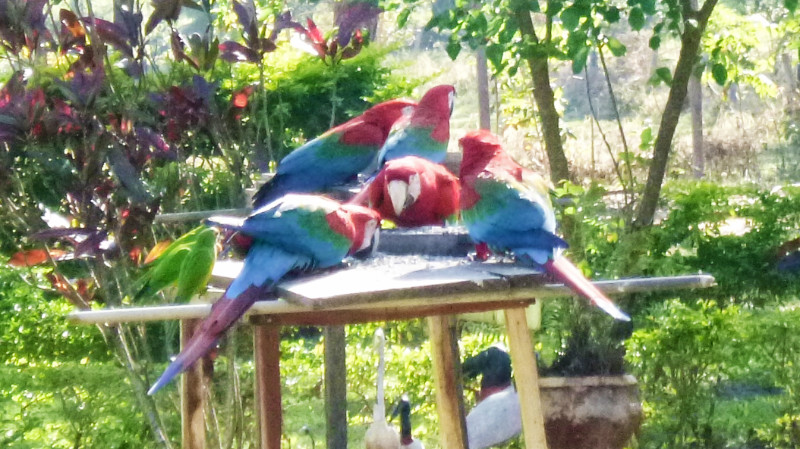 I’ve been here in Bonito for over two moons. I’d watched it wax and wane over the Pantanal sky, twice. Monday would make my stay 70 days when it comes to paying the bill. A lot of good people had come and gone in that time: Germans, Swiss, Canadians, Americans, Spanish, Belgians, Dutch, French, French Guianans, Italians, Brits, Austrians, Australians, Paraguayans, Brazilians, Argentinians and a Turk.
I’ve been here in Bonito for over two moons. I’d watched it wax and wane over the Pantanal sky, twice. Monday would make my stay 70 days when it comes to paying the bill. A lot of good people had come and gone in that time: Germans, Swiss, Canadians, Americans, Spanish, Belgians, Dutch, French, French Guianans, Italians, Brits, Austrians, Australians, Paraguayans, Brazilians, Argentinians and a Turk.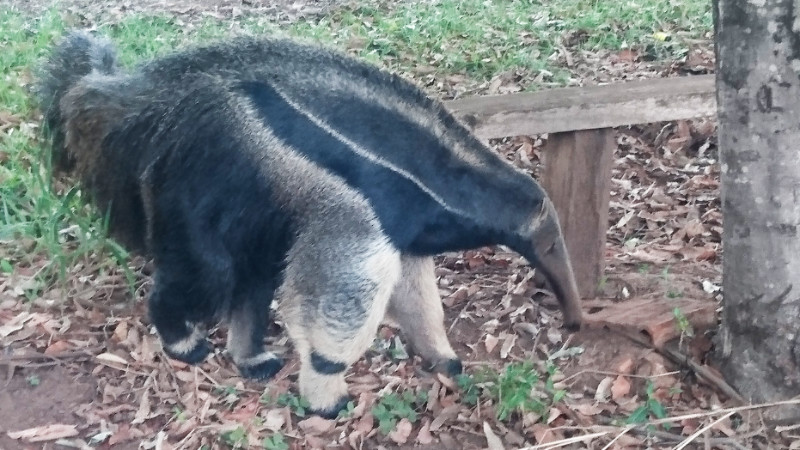 Staying at Pousada do Peralta was as good as travelling for meeting people from around the world. The experiences here too many to mention for a blog post but I’m grateful for everybody’s company and generosity, and in all that time, I never saw one unhappy face or heard a cross word between people… even married couples…
Staying at Pousada do Peralta was as good as travelling for meeting people from around the world. The experiences here too many to mention for a blog post but I’m grateful for everybody’s company and generosity, and in all that time, I never saw one unhappy face or heard a cross word between people… even married couples…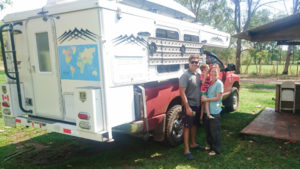
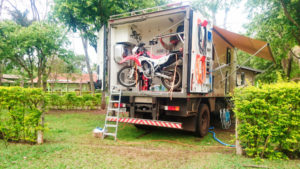
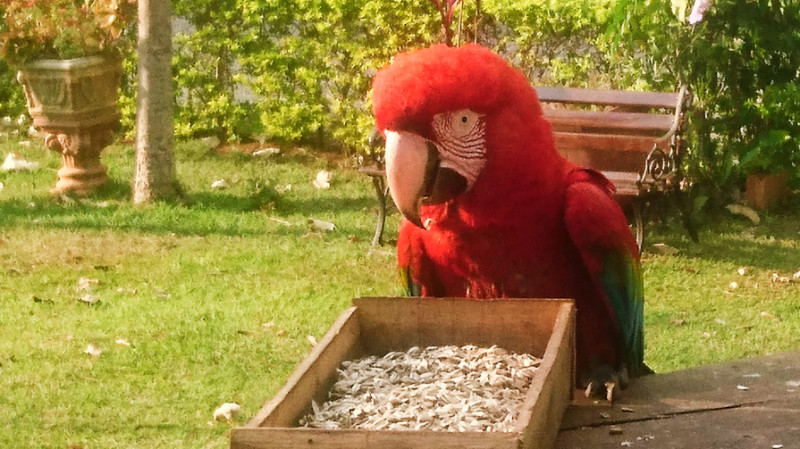
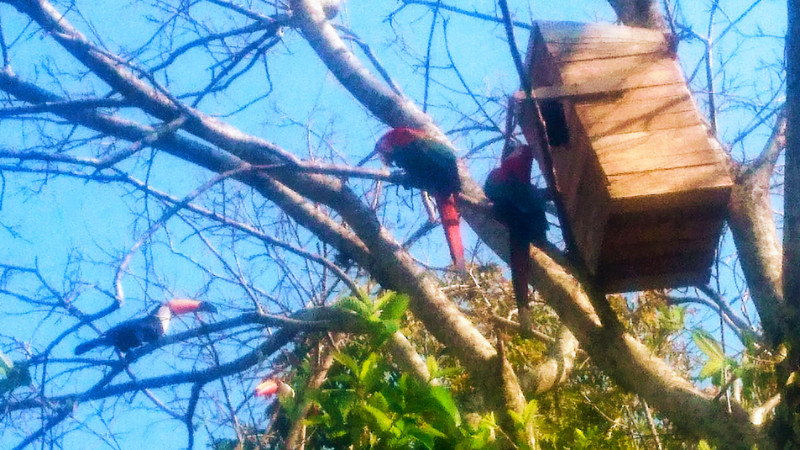
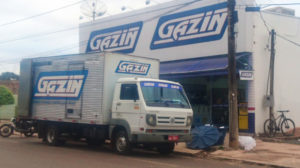 I’D VISITED GAZIN five times now. During that time I’d comfortably survived needing no cash. I didn’t need Western Union and their ineffectual, expensive service and so began the cancellation procedure.
I’D VISITED GAZIN five times now. During that time I’d comfortably survived needing no cash. I didn’t need Western Union and their ineffectual, expensive service and so began the cancellation procedure.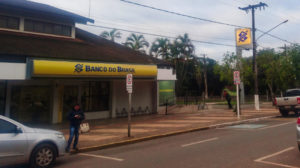 Now, where do you go to change currency? I know, Banco do Brazil, money is their business, they’d have some… The receptionist recognises me from before and says “No, no Western Union.” I take out the currency from my fleece pocket and fan it out to underline my need for currency exchange but no. I’m directed across the plaza to a travel agent. The travel agent shakes his head and points up the street. “Hotel Paraiso das Aguas… two blocks”
Now, where do you go to change currency? I know, Banco do Brazil, money is their business, they’d have some… The receptionist recognises me from before and says “No, no Western Union.” I take out the currency from my fleece pocket and fan it out to underline my need for currency exchange but no. I’m directed across the plaza to a travel agent. The travel agent shakes his head and points up the street. “Hotel Paraiso das Aguas… two blocks”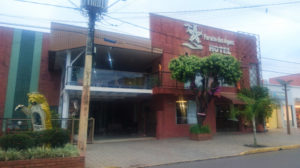 Hotel Paraiso das Aguas is large, spacious and empty apart from a receptionist barely visible on her low seat behind a tall wooden desk. “Senora fala Ingles?” I mimic off my CD course. The receptionist disappears down a corridor, her footsteps echoing off the hard ceramic surfaces, and returns with a young English speaking woman. I explain my plight and show her my currency. She asks me if I have
Hotel Paraiso das Aguas is large, spacious and empty apart from a receptionist barely visible on her low seat behind a tall wooden desk. “Senora fala Ingles?” I mimic off my CD course. The receptionist disappears down a corridor, her footsteps echoing off the hard ceramic surfaces, and returns with a young English speaking woman. I explain my plight and show her my currency. She asks me if I have 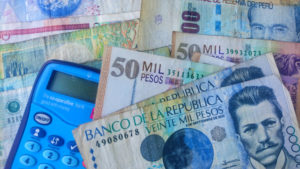 American Dollars before taking pity on me and phoning her husband to check my selection. She accepts the €50 but rejects the rest. This far from the border, Peruvian and Colombian currency is simply worthless paper, like Monopoly money. Their value is only supported by communal belief and their communities aren’t powerful enough to project their belief this far. I leave the hotel with 185 reais and a heartfelt “Good luck” from the young woman.
American Dollars before taking pity on me and phoning her husband to check my selection. She accepts the €50 but rejects the rest. This far from the border, Peruvian and Colombian currency is simply worthless paper, like Monopoly money. Their value is only supported by communal belief and their communities aren’t powerful enough to project their belief this far. I leave the hotel with 185 reais and a heartfelt “Good luck” from the young woman.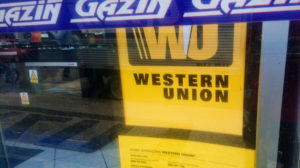 Clair and Carlos, a German, Brazilian couple – from the Netherlands – on vacation with their family of two daughters and a son offered to take cash out of an ATM in exchange for a bank transfer, which I gratefully accepted. Even paying had become a challenge without a bank card to confirm new payees using the Pin-Sentry security device. An obstacle overcome via my sister as an existing payee and intermediary.
Clair and Carlos, a German, Brazilian couple – from the Netherlands – on vacation with their family of two daughters and a son offered to take cash out of an ATM in exchange for a bank transfer, which I gratefully accepted. Even paying had become a challenge without a bank card to confirm new payees using the Pin-Sentry security device. An obstacle overcome via my sister as an existing payee and intermediary.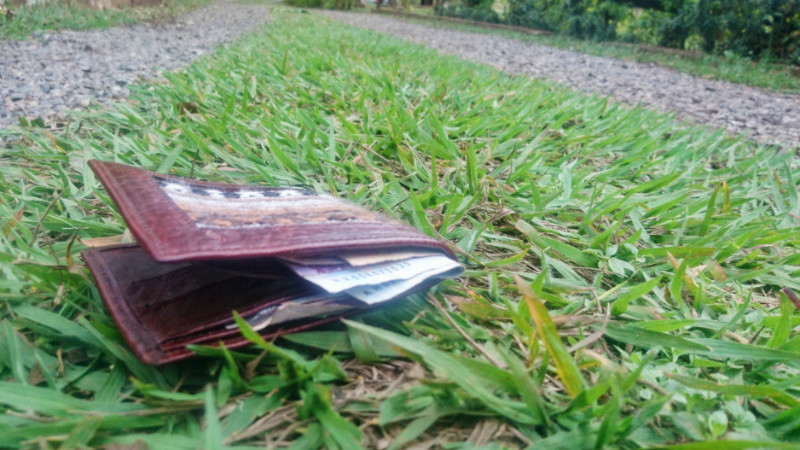
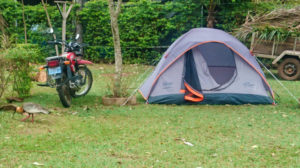 Chickens scratched around the lawn for food around my tent while I scratched around inside for cash. I found a wad stashed in a document wallet that I keep all my stray papers: Colombian Pesos and Peruvian Soles. More than was reasonable since it was before I managed to estimate my budget better whenever approaching borders. I folded it best I could inside my passport and zipped it in my fleece pocket.
Chickens scratched around the lawn for food around my tent while I scratched around inside for cash. I found a wad stashed in a document wallet that I keep all my stray papers: Colombian Pesos and Peruvian Soles. More than was reasonable since it was before I managed to estimate my budget better whenever approaching borders. I folded it best I could inside my passport and zipped it in my fleece pocket. The weather had killed life in Bonito and Saturday had been drowned on its glistening silver streets. The drizzle had upgraded itself to rain ready for my journey back to Peralta, I returned empty-handed and with a quilted jacket that had gained three times its weight in water along the way.
The weather had killed life in Bonito and Saturday had been drowned on its glistening silver streets. The drizzle had upgraded itself to rain ready for my journey back to Peralta, I returned empty-handed and with a quilted jacket that had gained three times its weight in water along the way.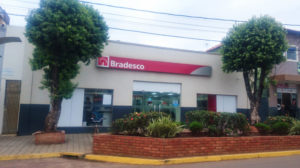 displayed A38. Two hours later, ‘ping!’ A44 and was swiftly instructed via Google translate that Banco Do Brazil could only release funds either to their own customers or Brazilian residents, surely I deserved more time than that after a two-hour wait. Bradesco bank told me similar but faster and less security ritual.
displayed A38. Two hours later, ‘ping!’ A44 and was swiftly instructed via Google translate that Banco Do Brazil could only release funds either to their own customers or Brazilian residents, surely I deserved more time than that after a two-hour wait. Bradesco bank told me similar but faster and less security ritual. Checking my email, my original Western Union transfer had been reviewed by support and cleared. I had a new reference number to play with but, looking closely at the details, the email receipt specified “Bank Account or Mobile Wallet.” What? Cash was omitted from the selection. What was the use of that? Brazil runs on 1. Cash, 2. Card Payments, and I possessed neither.
Checking my email, my original Western Union transfer had been reviewed by support and cleared. I had a new reference number to play with but, looking closely at the details, the email receipt specified “Bank Account or Mobile Wallet.” What? Cash was omitted from the selection. What was the use of that? Brazil runs on 1. Cash, 2. Card Payments, and I possessed neither.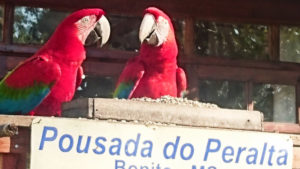 POUSADA DO PERALTA has good reviews 0n the ioverlander app and seems reasonably priced. Kicking down the side stand and planting it in the gravel, I climb off the bike and introduce myself at reception and given a tour of the tree-shaded grounds, bursting at the seams with coach-sized luxury motorhomes, I give the thumbs up with a smile and given a warm welcome in barely intelligible Portuguese. I get the tone and body language more than I do the words.
POUSADA DO PERALTA has good reviews 0n the ioverlander app and seems reasonably priced. Kicking down the side stand and planting it in the gravel, I climb off the bike and introduce myself at reception and given a tour of the tree-shaded grounds, bursting at the seams with coach-sized luxury motorhomes, I give the thumbs up with a smile and given a warm welcome in barely intelligible Portuguese. I get the tone and body language more than I do the words.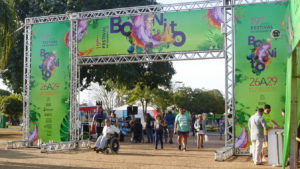 The warm weather encourages me to strip to my t-shirt and jeans and recline into a hammock under the trees before firing up the laptop. Sandflies soon encourage my fleece back on again to gently sweat in the balmy air. When the music dies the husky quacks of Toucans and distant song of mysterious tropical birds come alive.
The warm weather encourages me to strip to my t-shirt and jeans and recline into a hammock under the trees before firing up the laptop. Sandflies soon encourage my fleece back on again to gently sweat in the balmy air. When the music dies the husky quacks of Toucans and distant song of mysterious tropical birds come alive.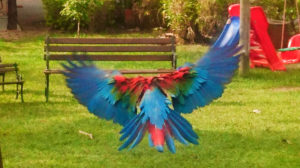 One day flowed into another through bright sunny days in the high twenties. The beauty of the Araras’ (Macaws) plumage was offset by their shrill squawks. It was a wise choice to choose the hammocks not directly under their favourite branches…
One day flowed into another through bright sunny days in the high twenties. The beauty of the Araras’ (Macaws) plumage was offset by their shrill squawks. It was a wise choice to choose the hammocks not directly under their favourite branches…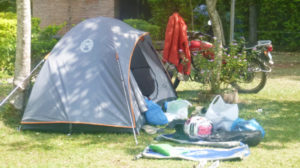 Gathering everything together, something was noticeable by its absence. My wallet. Checking pockets, bags and all through the tent. No wallet. I wouldn’t be going anywhere. In the wallet were; R500 ( about £100), my last active bank card, blood donor card, a few sentimental photos, and a photocopy of my passport. Checking my pockets, I had only three coins, 1 Real and 2 Bolivianos.
Gathering everything together, something was noticeable by its absence. My wallet. Checking pockets, bags and all through the tent. No wallet. I wouldn’t be going anywhere. In the wallet were; R500 ( about £100), my last active bank card, blood donor card, a few sentimental photos, and a photocopy of my passport. Checking my pockets, I had only three coins, 1 Real and 2 Bolivianos.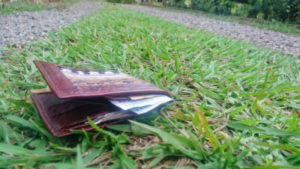 I discovered a similar empty wallet in the bottom of a bag of gifts for family. I had bought two wallets in Cusco, one for me and one for my Dad, something I could wave around to see if anyone would recognise its twin. I had had my wallet last at the Formoso Supermarket the day before and hadn’t been anywhere else since. Lost or Stolen, I couldn’t tell. Whatever the facts, the wallet and its contents remained absent…
I discovered a similar empty wallet in the bottom of a bag of gifts for family. I had bought two wallets in Cusco, one for me and one for my Dad, something I could wave around to see if anyone would recognise its twin. I had had my wallet last at the Formoso Supermarket the day before and hadn’t been anywhere else since. Lost or Stolen, I couldn’t tell. Whatever the facts, the wallet and its contents remained absent… While I had internet access, I typed out the question I wanted to ask at the supermarket via Google Translate and rode around the corner, pronto. Shaking of heads were the only response to the question I was pointing out on the screen. Lost for any more words, I coasted slowly back to Peralta scanning the gutter for stray wallets.
While I had internet access, I typed out the question I wanted to ask at the supermarket via Google Translate and rode around the corner, pronto. Shaking of heads were the only response to the question I was pointing out on the screen. Lost for any more words, I coasted slowly back to Peralta scanning the gutter for stray wallets. I logged on to Western Union and found I could send cash using a bank transfer. Screen by screen completed, one to another and, Ping! a pop up: “Your money transfer isn’t complete We’re sorry, but we are not able to send your money. If you have any questions, please call customer service at 0808 234 9168”
I logged on to Western Union and found I could send cash using a bank transfer. Screen by screen completed, one to another and, Ping! a pop up: “Your money transfer isn’t complete We’re sorry, but we are not able to send your money. If you have any questions, please call customer service at 0808 234 9168”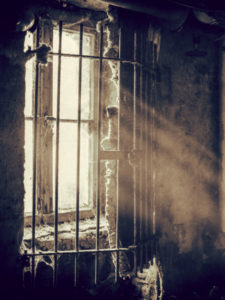
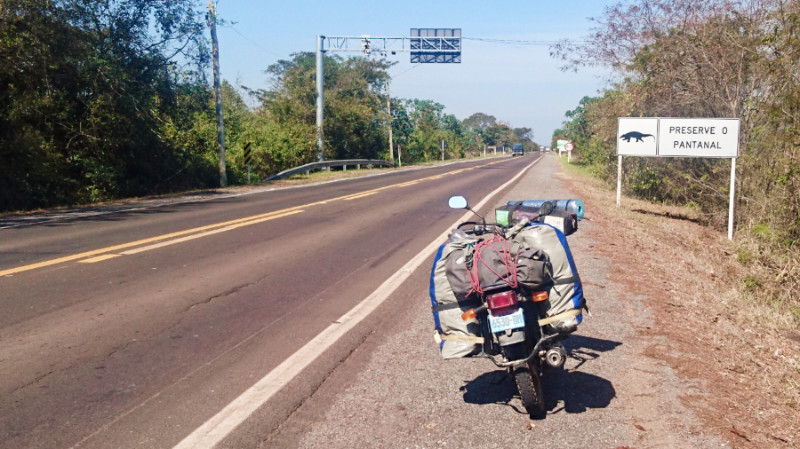 PANTANAL? NEVER HEARD of it… An internet search for the word for it brought up “wetlands.” Later, it dawned on me how important and beautiful this National Park is. Toucans, Macaws (Araras), Anteaters, Alligators; all as common as sparrows, magpies and squirrels back in the UK.
PANTANAL? NEVER HEARD of it… An internet search for the word for it brought up “wetlands.” Later, it dawned on me how important and beautiful this National Park is. Toucans, Macaws (Araras), Anteaters, Alligators; all as common as sparrows, magpies and squirrels back in the UK.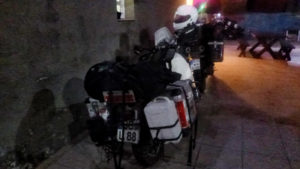 Corumba is an ideal service stop after exiting Bolivia, close enough to the border to address any immigration problems. The further inland you go, the more sparse these offices become and the more difficult it gets to resolve any difficulties. The issue with the camouflaged customs here on the border was a good example and I settled down to prepare for the rest of the journey.
Corumba is an ideal service stop after exiting Bolivia, close enough to the border to address any immigration problems. The further inland you go, the more sparse these offices become and the more difficult it gets to resolve any difficulties. The issue with the camouflaged customs here on the border was a good example and I settled down to prepare for the rest of the journey.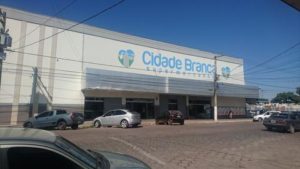 The bank ATMs in the centre of Corumba reject my card. The banks here support neither Visa or Mastercard but I later discover a machine, tucked behind a kiosk in a nearby supermarket and another at the Shell fuel station way across town. It occurred to me that having only one Debit Card is a bottleneck for ongoing access for funds. I started off with two cards initially but the first one was lost in Sicily whilst minding Sailing Vessel Pantelisa before the
The bank ATMs in the centre of Corumba reject my card. The banks here support neither Visa or Mastercard but I later discover a machine, tucked behind a kiosk in a nearby supermarket and another at the Shell fuel station way across town. It occurred to me that having only one Debit Card is a bottleneck for ongoing access for funds. I started off with two cards initially but the first one was lost in Sicily whilst minding Sailing Vessel Pantelisa before the 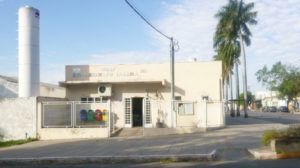 Some countries require an international yellow fever vaccine certificate if you’ve visited Brazil. As I’m passing the local hospital, I drop in and ask at reception for any info. They speak no English but understand enough what I’m asking and they mark on my tourists map the clinic a few blocks down the road and direct me there.
Some countries require an international yellow fever vaccine certificate if you’ve visited Brazil. As I’m passing the local hospital, I drop in and ask at reception for any info. They speak no English but understand enough what I’m asking and they mark on my tourists map the clinic a few blocks down the road and direct me there.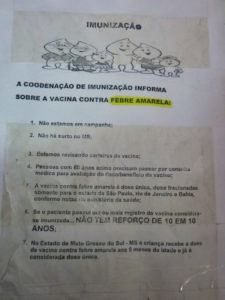 I leave the bike across the road and wander through a crowded waiting room to the small queue at the reception desk. After a short wait, I ask about “Amarillo Fever” pointing to the ‘febre amarila’ poster and they try to guess where I’m from ” Italiano?” “No, Ingles.” I’m invited to make myself comfortable on one of the plastic chairs in the waiting room. Two hours later after sitting in the company of breastfeeding mothers and wailing babies, they call me into a cupboard-sized room, big enough for a couple of chairs, a desk and shelves of basic medical paraphernalia. A couple of questions about nationality and age then Jab, rubber stamp and I’m done. I ask the receptionist if this card was the certificate I needed and she pulls up the address of the Anvisa office on Google and points to it. I snap a photo of the screen with my phone and swing the bike out onto the cobbles homeward to Road Riders.
I leave the bike across the road and wander through a crowded waiting room to the small queue at the reception desk. After a short wait, I ask about “Amarillo Fever” pointing to the ‘febre amarila’ poster and they try to guess where I’m from ” Italiano?” “No, Ingles.” I’m invited to make myself comfortable on one of the plastic chairs in the waiting room. Two hours later after sitting in the company of breastfeeding mothers and wailing babies, they call me into a cupboard-sized room, big enough for a couple of chairs, a desk and shelves of basic medical paraphernalia. A couple of questions about nationality and age then Jab, rubber stamp and I’m done. I ask the receptionist if this card was the certificate I needed and she pulls up the address of the Anvisa office on Google and points to it. I snap a photo of the screen with my phone and swing the bike out onto the cobbles homeward to Road Riders.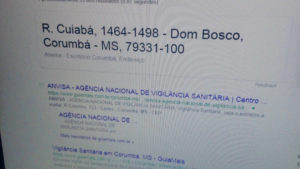 Anvisa office, the next day, time 14:20. “Where are you from?” It says it in the passport he’s holding. “United Kingdom… Great Britain… Gran Bretagne… England… Inglaterra?” Blank look… his eyes return to the screen and all became quiet between the mouse clicks and the tapping of computer keys. I check the certificate he hands to me. Place of birth: “Georgia.” Close enough, and I tuck it
Anvisa office, the next day, time 14:20. “Where are you from?” It says it in the passport he’s holding. “United Kingdom… Great Britain… Gran Bretagne… England… Inglaterra?” Blank look… his eyes return to the screen and all became quiet between the mouse clicks and the tapping of computer keys. I check the certificate he hands to me. Place of birth: “Georgia.” Close enough, and I tuck it 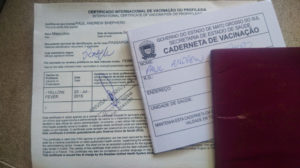 into my satchel. Tip: if you ever get asked in a Spanish or Portuguese speaking country and need to express Britain as your place of origin, learn to say “Reino Unido.” Also, if you don’t know that, it’s a bugger to find in the list of countries on a computer since it’s nowhere near G or U in an alphabetical drop-down box.
into my satchel. Tip: if you ever get asked in a Spanish or Portuguese speaking country and need to express Britain as your place of origin, learn to say “Reino Unido.” Also, if you don’t know that, it’s a bugger to find in the list of countries on a computer since it’s nowhere near G or U in an alphabetical drop-down box.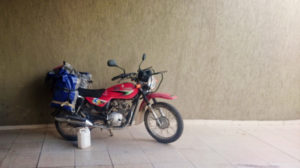 After a week at Road Riders, having collected more contacts it was time to move on. The bike had already been prepared the day before and I had everything I needed. Diego gave me a gallon container so I could grab more fuel when I need it between the longer distances across Brazil and Argentina, which would take the stress out of watching the fuel gauge needle plummet toward empty while out in the sticks. I devised a clever loop system so I could release the container without untying the bags. Always thinking…
After a week at Road Riders, having collected more contacts it was time to move on. The bike had already been prepared the day before and I had everything I needed. Diego gave me a gallon container so I could grab more fuel when I need it between the longer distances across Brazil and Argentina, which would take the stress out of watching the fuel gauge needle plummet toward empty while out in the sticks. I devised a clever loop system so I could release the container without untying the bags. Always thinking…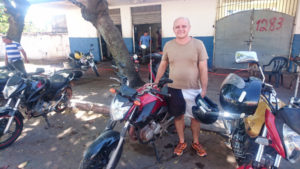 I visit Manoel and his wife one more time and he insisted on escorting me to the edge of town for the 350km trip to Bonito. Manoel pulls over on the edge of town at what looks to be an unattended checkpoint, I stop to thank him and give a wave as I pull away toward my first waypoint, the town of Miranda. The day is hazy and surprisingly cold and, on the horizon, rain threatens to dampen my ride. This is the Pantanal, the wetlands of Brazil, the famous national park I’d never heard of before.
I visit Manoel and his wife one more time and he insisted on escorting me to the edge of town for the 350km trip to Bonito. Manoel pulls over on the edge of town at what looks to be an unattended checkpoint, I stop to thank him and give a wave as I pull away toward my first waypoint, the town of Miranda. The day is hazy and surprisingly cold and, on the horizon, rain threatens to dampen my ride. This is the Pantanal, the wetlands of Brazil, the famous national park I’d never heard of before.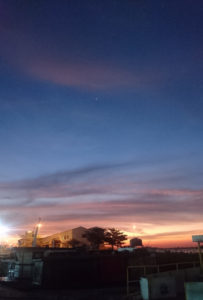 The road to Miranda has a smooth grey surface, dead straight on a raised dyke through a marshy flat landscape bisected by the mighty Paraguay River. Speed cameras line the road at my maximum cruising speed of 80kmh to help protect the wildlife that stray across. I’m told the water level is unusually high for the time of year and I notice the Brahman cattle between the shrubs, ankle deep in water, grazing on whatever vegetation breaks the surface and wonder how many get taken by alligators.
The road to Miranda has a smooth grey surface, dead straight on a raised dyke through a marshy flat landscape bisected by the mighty Paraguay River. Speed cameras line the road at my maximum cruising speed of 80kmh to help protect the wildlife that stray across. I’m told the water level is unusually high for the time of year and I notice the Brahman cattle between the shrubs, ankle deep in water, grazing on whatever vegetation breaks the surface and wonder how many get taken by alligators.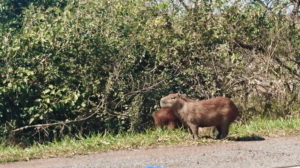 The weather had brightened up before I reached Miranda where I was due to turn right to Bonito. I was warmer now as I coasted into the gas station for a top up. The fuel container behind me was replaced by empty space and the rope it was attached to was a loose and wayward loop hanging off the back of the bike. I surmised the container bounced off the seat and worked its way along the rope, over the bag until it hung off the back near the rear light and eventually worked the loop off the peg and escape to join the animals in the Pantanal. My contribution to pollution of the habitat while decreasing my fuel range. Everyone’s a loser.
The weather had brightened up before I reached Miranda where I was due to turn right to Bonito. I was warmer now as I coasted into the gas station for a top up. The fuel container behind me was replaced by empty space and the rope it was attached to was a loose and wayward loop hanging off the back of the bike. I surmised the container bounced off the seat and worked its way along the rope, over the bag until it hung off the back near the rear light and eventually worked the loop off the peg and escape to join the animals in the Pantanal. My contribution to pollution of the habitat while decreasing my fuel range. Everyone’s a loser.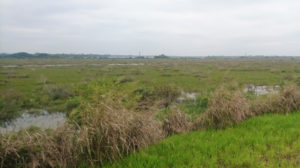 Way past lunchtime, I cruise around Miranda looking for a suitable lunch stop. Too many people on the street watching my loaded bike idle by makes me feel self-conscious at a time I’d rather go unnoticed. Uninspired and not hungry enough for what was on offer I instead continue to Bonito down the MS 339 via Bodequena
Way past lunchtime, I cruise around Miranda looking for a suitable lunch stop. Too many people on the street watching my loaded bike idle by makes me feel self-conscious at a time I’d rather go unnoticed. Uninspired and not hungry enough for what was on offer I instead continue to Bonito down the MS 339 via Bodequena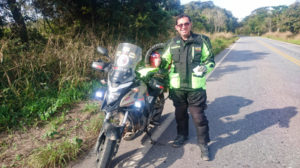 A bright light catches the corner of my eye. A motorcycle gaining in my mirrors. Pure white LED lights, with a paranoid hint of blue, either side of the headlamp. Rider wearing black jacket and fluorescent yellow helmet, flashing his headlight waving me over.. Shit, a cop… this would be my first stop since setting foot on the continent way back in January.
A bright light catches the corner of my eye. A motorcycle gaining in my mirrors. Pure white LED lights, with a paranoid hint of blue, either side of the headlamp. Rider wearing black jacket and fluorescent yellow helmet, flashing his headlight waving me over.. Shit, a cop… this would be my first stop since setting foot on the continent way back in January. Vinicio Rodriguez is not a cop. He’s a university lecturer from Ecuador on a road trip to visit his son in Campinas, not far from Sao Paulo. His Honda 500X is decked out well for long stretches of tarmac and today we are both bound for Bonito for the night. We chat at the roadside for a few minutes and then partner up for the next hour’s cruise into Bonito. I lead at first on the slower machine until we approach Bonito and then we switch and I follow Vin to his hotel intending to enjoy a drink together. We reach Pousada Ceu de Estrelles not long before dusk. Vinicio checked out the room and invited me to stay. I say thanks but it’s over my budget and I’d be camping at Pousada do Peralta. He tells me that the hotel charges per room and costs the same for one person as it would for two and would be pleased to share my company. I feel conflicted but accept, offering a contribution to alleviate my feeling. He wouldn’t have it.
Vinicio Rodriguez is not a cop. He’s a university lecturer from Ecuador on a road trip to visit his son in Campinas, not far from Sao Paulo. His Honda 500X is decked out well for long stretches of tarmac and today we are both bound for Bonito for the night. We chat at the roadside for a few minutes and then partner up for the next hour’s cruise into Bonito. I lead at first on the slower machine until we approach Bonito and then we switch and I follow Vin to his hotel intending to enjoy a drink together. We reach Pousada Ceu de Estrelles not long before dusk. Vinicio checked out the room and invited me to stay. I say thanks but it’s over my budget and I’d be camping at Pousada do Peralta. He tells me that the hotel charges per room and costs the same for one person as it would for two and would be pleased to share my company. I feel conflicted but accept, offering a contribution to alleviate my feeling. He wouldn’t have it.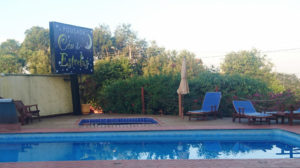 Vinicio’s Spanish is understood by Brazilians far more readily than my English. Marco Velho is a buffet restaurant in the centre of Bonito that comes highly recommended and apparently the most attended throughout Bonito. We make ourselves comfortable and, before we know it, all the tables are swept up by an influx of local inhabitants. Always a good endorsement.
Vinicio’s Spanish is understood by Brazilians far more readily than my English. Marco Velho is a buffet restaurant in the centre of Bonito that comes highly recommended and apparently the most attended throughout Bonito. We make ourselves comfortable and, before we know it, all the tables are swept up by an influx of local inhabitants. Always a good endorsement.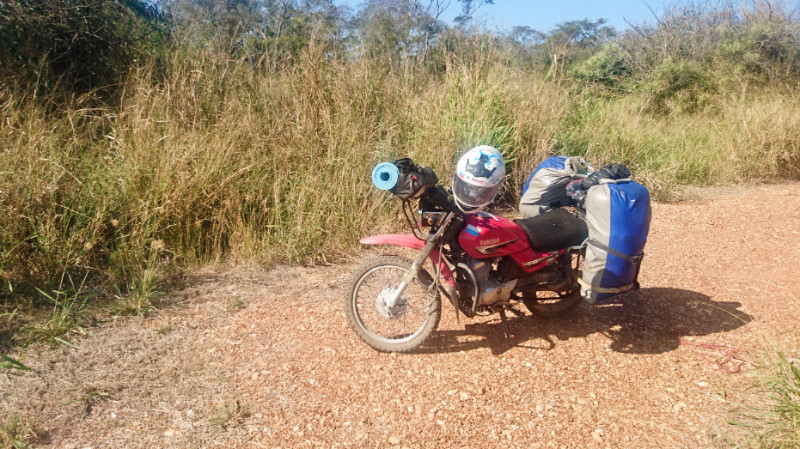 I AWOKE AT dawn but only emerged when the sun had risen a clear hour above the horizon before I packed away. I refuelled at the border town of Puerto Quijarro to use up my remaining Bolivianos and breakfasted on chicken and rice at a locals cafe to work up to engaging with the border agents just down the road.
I AWOKE AT dawn but only emerged when the sun had risen a clear hour above the horizon before I packed away. I refuelled at the border town of Puerto Quijarro to use up my remaining Bolivianos and breakfasted on chicken and rice at a locals cafe to work up to engaging with the border agents just down the road.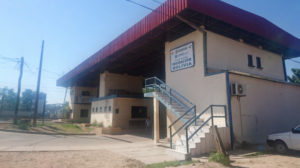 I breezed through Bolivian Migraciones: three people in front of me then: stamp, vamos. Over the road at Aduana Nacional, the gates were firmly closed. A sign indicated Cerrado from 12.30 to 14.30. It was now 12.47. ~ most unexpected. I’d have skipped breakfast if I’d anticipated that.
I breezed through Bolivian Migraciones: three people in front of me then: stamp, vamos. Over the road at Aduana Nacional, the gates were firmly closed. A sign indicated Cerrado from 12.30 to 14.30. It was now 12.47. ~ most unexpected. I’d have skipped breakfast if I’d anticipated that.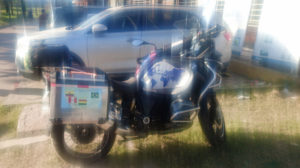 None of the cafes nearby provided WiFi. Wandering around the dusty, sun-baked street, I decided I may as well hang around the Aduana entrance. There was a family already there. Time crawled by as I kicked over the gravel in the car park. More people began to gather from 13.50. I was glad I’d decided to wait here as the queue expanded to about 8 people by the time the bolt was slid across to open the gate.
None of the cafes nearby provided WiFi. Wandering around the dusty, sun-baked street, I decided I may as well hang around the Aduana entrance. There was a family already there. Time crawled by as I kicked over the gravel in the car park. More people began to gather from 13.50. I was glad I’d decided to wait here as the queue expanded to about 8 people by the time the bolt was slid across to open the gate.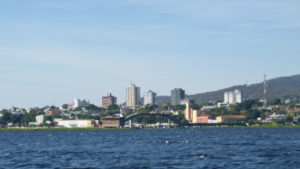
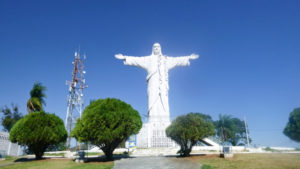
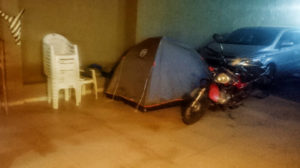
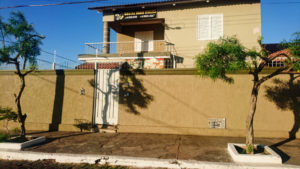
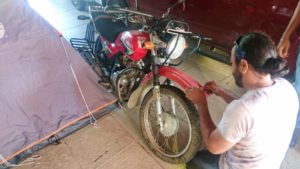
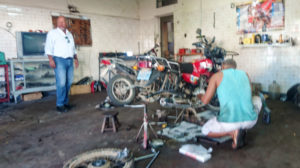
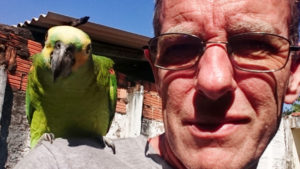
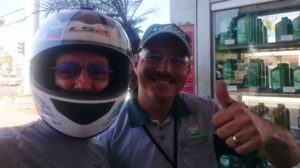
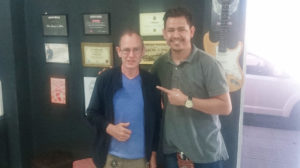
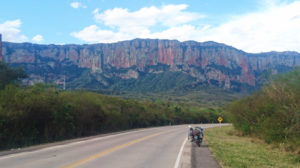 EARLY AFTERNOON IN the wake of England’s second defeat to Belgium in the World Cup and I’m eastbound on Route 4. Estancia Aguas Calientes is only 165km and I take it steady to save fuel. I pass the gas station at Robore with the gauge just over a quarter but gamble on fuel being available at Aguas Calientes 30km further on. “Get it while you can.” Is my fuel mantra since I don’t yet carry reserves. Rarely do I obey it though and start fretting when the needle plummets below the last quarter mark.
EARLY AFTERNOON IN the wake of England’s second defeat to Belgium in the World Cup and I’m eastbound on Route 4. Estancia Aguas Calientes is only 165km and I take it steady to save fuel. I pass the gas station at Robore with the gauge just over a quarter but gamble on fuel being available at Aguas Calientes 30km further on. “Get it while you can.” Is my fuel mantra since I don’t yet carry reserves. Rarely do I obey it though and start fretting when the needle plummets below the last quarter mark. Bearing right off the highway onto the red dirt track to launched me into a sand pit and the Yamaha’s narrow tyres fight to stay on the surface. I haven’t mastered riding in deep sand yet. The steering doesn’t work and the rear wheel drifts sideways. Losing momentum results in the rear wheel trying to bury itself as I try to move off. I try to find the firmest looking car tracks and keep moving forward, paddling my feet like a swan trying to take off from a lake.
Bearing right off the highway onto the red dirt track to launched me into a sand pit and the Yamaha’s narrow tyres fight to stay on the surface. I haven’t mastered riding in deep sand yet. The steering doesn’t work and the rear wheel drifts sideways. Losing momentum results in the rear wheel trying to bury itself as I try to move off. I try to find the firmest looking car tracks and keep moving forward, paddling my feet like a swan trying to take off from a lake.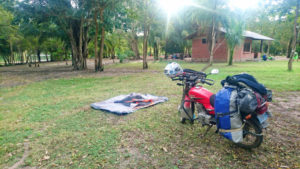 I ride into the Miraflores Toucan campsite around 16:30. I spot only two other tents here down in the far corner near the waterside. I select a quiet area near the trees and no other attractions. Quickly pitched, I change into shorts and t-shirt, grab a towel and stroll down to the lake.
I ride into the Miraflores Toucan campsite around 16:30. I spot only two other tents here down in the far corner near the waterside. I select a quiet area near the trees and no other attractions. Quickly pitched, I change into shorts and t-shirt, grab a towel and stroll down to the lake. 34C feels surprisingly warm and I wade out, waste deep toward the shimmering surface where the bubbles are breaking the surface, crystal clear water, into the warm humid air. I soak until the sun sets, stirring up the sand and attracting the fish to whatever’s being released by the bubbles. Every now and then, I feel a nip as a fish forages for food. A school of them find the flaking skin between my toes where I’ve contracted athletes foot and nibble away. They can have that
34C feels surprisingly warm and I wade out, waste deep toward the shimmering surface where the bubbles are breaking the surface, crystal clear water, into the warm humid air. I soak until the sun sets, stirring up the sand and attracting the fish to whatever’s being released by the bubbles. Every now and then, I feel a nip as a fish forages for food. A school of them find the flaking skin between my toes where I’ve contracted athletes foot and nibble away. They can have that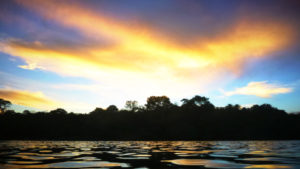 Out into the tree-shaded campsite, the moon is a thin crescent, not enough to add to the sparse lighting around the site. I buy a beer from the attendant and ask about fuel during our conversation. “Robore.” he says. I’d seen that fuel station 25Km back from where I came. I laugh and feel I need to explain why. It was the station I had passed way back. He tells me someone in the village sells out bottles for 5bob a litre. I say, “That’s cheap” and he says “No, muy caro” until I explain the international rate of “Ocho por litro!” He shows me on my sat nav app where to go in the village. The main thing is I don’t have to backtrack for 8bob a litre.
Out into the tree-shaded campsite, the moon is a thin crescent, not enough to add to the sparse lighting around the site. I buy a beer from the attendant and ask about fuel during our conversation. “Robore.” he says. I’d seen that fuel station 25Km back from where I came. I laugh and feel I need to explain why. It was the station I had passed way back. He tells me someone in the village sells out bottles for 5bob a litre. I say, “That’s cheap” and he says “No, muy caro” until I explain the international rate of “Ocho por litro!” He shows me on my sat nav app where to go in the village. The main thing is I don’t have to backtrack for 8bob a litre.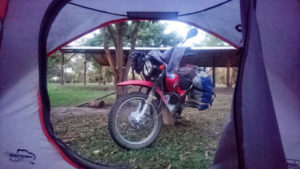 The dawn paints in a rose petal sky as I enter the warm clear waters of the lake. I consider going in naked since it’s early and not many people are around. I play safe and keep my briefs on, followed, ten minutes later, by a family of three.
The dawn paints in a rose petal sky as I enter the warm clear waters of the lake. I consider going in naked since it’s early and not many people are around. I play safe and keep my briefs on, followed, ten minutes later, by a family of three.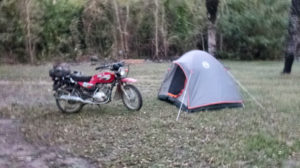 I decamp and pack away slowly to scoot the bike along the sandy track toward the fuel bottles in the village. After asking a couple of stores, I found a private cabana on the corner. “Seis!” he tells me and I ask for six litres without haggling the sixty pence difference. He looks like he needs it more than I do. Six litres tops me up just perfectly.
I decamp and pack away slowly to scoot the bike along the sandy track toward the fuel bottles in the village. After asking a couple of stores, I found a private cabana on the corner. “Seis!” he tells me and I ask for six litres without haggling the sixty pence difference. He looks like he needs it more than I do. Six litres tops me up just perfectly.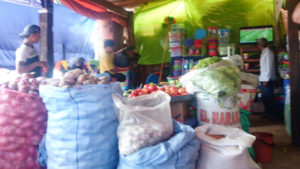 The sat nav indicates a restaurant perched on the bypass around the village but it doesn’t seem to exist in my physical reality. The time was 10:50 and the World Cup Final between France and Croatia was kicking off at 11. I hang a U-turn at the junction and cruise back into the village to the store across from the fuel vendor that I noticed packed with people settled in plastic patio chairs.
The sat nav indicates a restaurant perched on the bypass around the village but it doesn’t seem to exist in my physical reality. The time was 10:50 and the World Cup Final between France and Croatia was kicking off at 11. I hang a U-turn at the junction and cruise back into the village to the store across from the fuel vendor that I noticed packed with people settled in plastic patio chairs.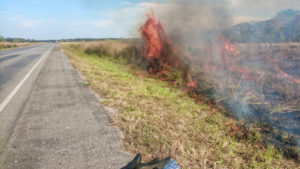 Shortly after midday, the little Yamaha was humming its way eastwards toward the Brazilian border, 210km away. I wanted a break before tackling the bureaucrats, so my target was to be a wild camping site near Yucuces, 165km away, which would leave about 45km to the border the next morning. Today though, a fast but leisurely journey on these straight and level roads. Time enough for Sunday lunch in El Carmen Rivero Torrez,
Shortly after midday, the little Yamaha was humming its way eastwards toward the Brazilian border, 210km away. I wanted a break before tackling the bureaucrats, so my target was to be a wild camping site near Yucuces, 165km away, which would leave about 45km to the border the next morning. Today though, a fast but leisurely journey on these straight and level roads. Time enough for Sunday lunch in El Carmen Rivero Torrez,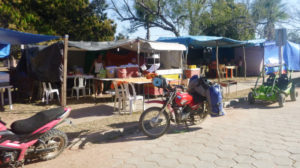 Turning of the El Carmen bypass, the hexagon paving blocks are cute to look at but rough to ride on and they deliver me to a bare looking Plaza surrounded by market stalls and booming PA speakers. I find a food stall just off the Plaza and face the customary plate of chicken and rice. A cold beer helps both relax and revive me. I check the sat nav for my destination.
Turning of the El Carmen bypass, the hexagon paving blocks are cute to look at but rough to ride on and they deliver me to a bare looking Plaza surrounded by market stalls and booming PA speakers. I find a food stall just off the Plaza and face the customary plate of chicken and rice. A cold beer helps both relax and revive me. I check the sat nav for my destination.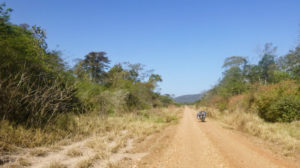 The wild campsite on the sat nav gives no clue to landmarks to look out for and I add the distance of the junction that leads off the main road to the milometer and count down the miles along route 4. There aren’t that many junctions and the turning I finally take is the only candidate for miles. A loose gravel track leads north away from the main road for five kilometres. Tall dry pampas half obscures a pair of laybys that combine to make a turning circle with a six-metre radius. Nothing here but tall grass, gravel and telltale signs of campers. Litter remains scattered over the floor: blister packs for tablets, cotton buds, food wrappers, used batteries, tissues. Man tracks…
The wild campsite on the sat nav gives no clue to landmarks to look out for and I add the distance of the junction that leads off the main road to the milometer and count down the miles along route 4. There aren’t that many junctions and the turning I finally take is the only candidate for miles. A loose gravel track leads north away from the main road for five kilometres. Tall dry pampas half obscures a pair of laybys that combine to make a turning circle with a six-metre radius. Nothing here but tall grass, gravel and telltale signs of campers. Litter remains scattered over the floor: blister packs for tablets, cotton buds, food wrappers, used batteries, tissues. Man tracks…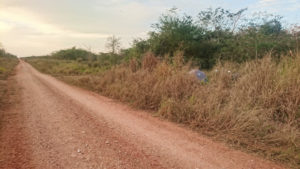 Early evening brings out the flies, dancing before my eyes, distracting me as I pitch the tent in the edge of the pampas, flattening the grass for creating a softer sleeping base over the underlying gravel. I wheel the bike close to the tent and, from the track, I’m almost invisible. Passing traffic would have to look 90 degrees to notice me. Nobody passes, day or night.
Early evening brings out the flies, dancing before my eyes, distracting me as I pitch the tent in the edge of the pampas, flattening the grass for creating a softer sleeping base over the underlying gravel. I wheel the bike close to the tent and, from the track, I’m almost invisible. Passing traffic would have to look 90 degrees to notice me. Nobody passes, day or night.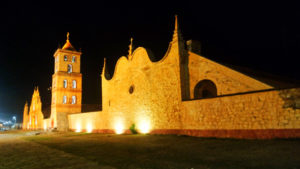 300KM… IT LOOKED A tall order to start with and now it was officially afternoon and I’ve only knocked off 25km. Whatever… If I have to sleep in a field then so be it.
300KM… IT LOOKED A tall order to start with and now it was officially afternoon and I’ve only knocked off 25km. Whatever… If I have to sleep in a field then so be it. At the traffic lights, I notice a horse and cart at the curb and think “How quaint.” The lights change and the truck moves off and I almost run into the back of it when it slams on its brakes to avoid the quaint horse and cart merrily trotting across the dual carriageway.
At the traffic lights, I notice a horse and cart at the curb and think “How quaint.” The lights change and the truck moves off and I almost run into the back of it when it slams on its brakes to avoid the quaint horse and cart merrily trotting across the dual carriageway.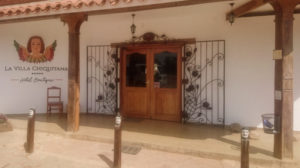 I pull over in Quimome and ask at the store about ‘Gasolina’ he points to the turning I’d just passed on my right but don’t understand what he’s saying. I notice the water bottle hanging by the left-hand pannier and refresh myself with a long slug of water before I go to three more locations in the general direction of the fuel, venturing away from the main road along a dirt track, into the village. A small handwritten sign hangs from the porch of a cabana on the corner of the street. I strike gold with four 2 litre bottles of petrol at 10bob a bottle.
I pull over in Quimome and ask at the store about ‘Gasolina’ he points to the turning I’d just passed on my right but don’t understand what he’s saying. I notice the water bottle hanging by the left-hand pannier and refresh myself with a long slug of water before I go to three more locations in the general direction of the fuel, venturing away from the main road along a dirt track, into the village. A small handwritten sign hangs from the porch of a cabana on the corner of the street. I strike gold with four 2 litre bottles of petrol at 10bob a bottle. Hotel Villa Chiquitana has rave reviews on iOverlander. The lobby is immaculately clean and the place looks a cut above the usual standard I’m used to. Jerome the owner, tells me they no longer accept tents, as they have caused so much trouble, and directs me to Balneario el Quebracho. “You can’t miss it, there’s a giant white Jesus in the middle of the road, it’s just past that…”
Hotel Villa Chiquitana has rave reviews on iOverlander. The lobby is immaculately clean and the place looks a cut above the usual standard I’m used to. Jerome the owner, tells me they no longer accept tents, as they have caused so much trouble, and directs me to Balneario el Quebracho. “You can’t miss it, there’s a giant white Jesus in the middle of the road, it’s just past that…”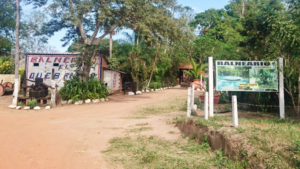 I set up and rest in the tent until dark before taking the 1km stroll into the Plaza. On the eastern side, the Jesuit mission is warmly illuminated in a sepia orange glow, rekindling romantic memories with my fiance when we visited the Alamo in San Antonio, Texas… an age has passed since then… another life ago.
I set up and rest in the tent until dark before taking the 1km stroll into the Plaza. On the eastern side, the Jesuit mission is warmly illuminated in a sepia orange glow, rekindling romantic memories with my fiance when we visited the Alamo in San Antonio, Texas… an age has passed since then… another life ago.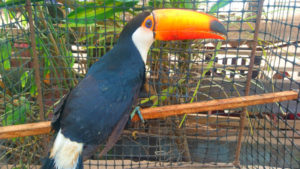 I awake just before dawn, not because of the cold but due to a menagerie of animal noises, cockerels by the busload, the caw of a toucan, unknown tropical songs together with collective shouts from the infantrymen on the training ground. Just after the sun casts leafy shadows over my tent, I open the door and see the mosquitos dance up and down the fly screen. A horse trots by, untethered and unencumbered by harness or saddle. A circular saw screams in the near distance. It’s clear in the warm tropical light of day that this place is undergoing a refurbishment. I appear to be the only guest. I don’t mind. I promptly pay for an extra night…
I awake just before dawn, not because of the cold but due to a menagerie of animal noises, cockerels by the busload, the caw of a toucan, unknown tropical songs together with collective shouts from the infantrymen on the training ground. Just after the sun casts leafy shadows over my tent, I open the door and see the mosquitos dance up and down the fly screen. A horse trots by, untethered and unencumbered by harness or saddle. A circular saw screams in the near distance. It’s clear in the warm tropical light of day that this place is undergoing a refurbishment. I appear to be the only guest. I don’t mind. I promptly pay for an extra night…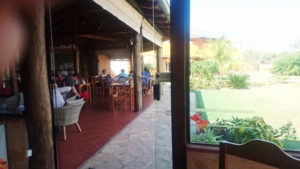 I’m looking for a place suitable for uploading a blog and the plaza isn’t it. I walk an extra kilometre down to the hotel I visited yesterday. Hotel Villa Chiquetana. Electric, Wifi and decent coffee. I choose the corner table in the restaurant next to a mains socket. Windows border both sides a view to the patio area of the restaurant and the other looking out across the lawn toward the pool. Indoors being only marginally cooler than outdoors became a haven of solitude and productivity for the rest of the day.
I’m looking for a place suitable for uploading a blog and the plaza isn’t it. I walk an extra kilometre down to the hotel I visited yesterday. Hotel Villa Chiquetana. Electric, Wifi and decent coffee. I choose the corner table in the restaurant next to a mains socket. Windows border both sides a view to the patio area of the restaurant and the other looking out across the lawn toward the pool. Indoors being only marginally cooler than outdoors became a haven of solitude and productivity for the rest of the day.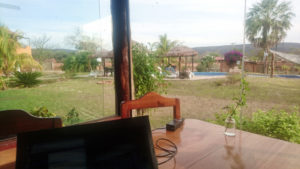 My second visit to La Tortilla for Mexican fare cemented a good friendship with the proprietors. I think they don’t see a lone gringo on a motorcycle stop by very often.
My second visit to La Tortilla for Mexican fare cemented a good friendship with the proprietors. I think they don’t see a lone gringo on a motorcycle stop by very often. I LAY IN bed imagining the distance of the fuel gauge from needle to empty and distance from Porongo to fuel stations on my Android apps. The nearest were 6km in La Guardia fording the river. The nearest over the bridge was 26km. I wasn’t sure I’d make it that far, the speed the needle drops on the lower half of the gauge. The thought was debilitating but there was nothing to do until it came to moving anyway.
I LAY IN bed imagining the distance of the fuel gauge from needle to empty and distance from Porongo to fuel stations on my Android apps. The nearest were 6km in La Guardia fording the river. The nearest over the bridge was 26km. I wasn’t sure I’d make it that far, the speed the needle drops on the lower half of the gauge. The thought was debilitating but there was nothing to do until it came to moving anyway.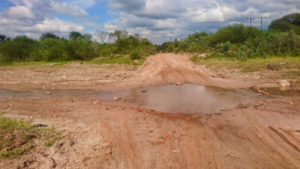 look at the river crossing. 2km, the GPS told me until I’d already walked a kilometre into Porongo, which by then had changed to 4km. Sticky humid air under an overcast sky stuck the t-shirt to my back, reminding me of my work in the sweaty oil fields of East Texas back in 1982. The round trip would now be 8km instead of 4. Still, I had all day.
look at the river crossing. 2km, the GPS told me until I’d already walked a kilometre into Porongo, which by then had changed to 4km. Sticky humid air under an overcast sky stuck the t-shirt to my back, reminding me of my work in the sweaty oil fields of East Texas back in 1982. The round trip would now be 8km instead of 4. Still, I had all day.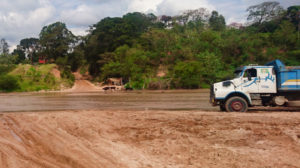 Stripping all the straps and remaining luggage off the bike the next morning I set off to the river after Giulio told me I must have been at the small river, not the main one. He was right. I fought with the loose sand along the track and the bare riverbed and sat at the water’s edge to watch traffic cross. I waited a while and saw only a lone cyclist push his bike across the knee-deep flow.
Stripping all the straps and remaining luggage off the bike the next morning I set off to the river after Giulio told me I must have been at the small river, not the main one. He was right. I fought with the loose sand along the track and the bare riverbed and sat at the water’s edge to watch traffic cross. I waited a while and saw only a lone cyclist push his bike across the knee-deep flow.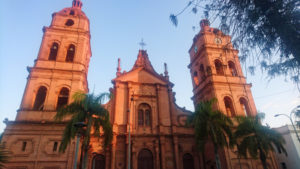 Refuelling gave me the freedom to run in and out to Santa Cruz and explore the city centre. I got to know which streets weren’t amputated with an improvised dead end or disempowered by a “no left turn.” Many of the crossroads looked like four-way stop junctions but without the stop signs. Seems to be that the bravest goes first. The best strategy for me seemed to be, keep a good rolling pace slow
Refuelling gave me the freedom to run in and out to Santa Cruz and explore the city centre. I got to know which streets weren’t amputated with an improvised dead end or disempowered by a “no left turn.” Many of the crossroads looked like four-way stop junctions but without the stop signs. Seems to be that the bravest goes first. The best strategy for me seemed to be, keep a good rolling pace slow 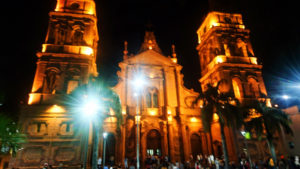 enough for an emergency stop but fast enough that I could gun it through and be clear pronto once I was sure there was no traffic within striking distance. I memorised the easiest route to the central plaza and found the customary Irish Pub that seems to sprout not far from South American Cathedrals and Plazas.
enough for an emergency stop but fast enough that I could gun it through and be clear pronto once I was sure there was no traffic within striking distance. I memorised the easiest route to the central plaza and found the customary Irish Pub that seems to sprout not far from South American Cathedrals and Plazas.
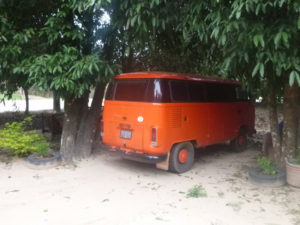 9am, I meet the landlord’s elderly father entering the gate come to feed the pigs with the scraps from the restaurant he runs in the village. A cheerful man wishing me “Buena dia.” they knock the s of the greeting here. I warm myself on the chair on the porch receiving the full beam of the morning sun, while peeling a third tangerine still spitting the pips out from the second before riding into Santa Cruz for breakfast and watch Croatia beat England in the world cup semifinal. The other plans I had for being online evaporated along with England’s 1966 dreams.
9am, I meet the landlord’s elderly father entering the gate come to feed the pigs with the scraps from the restaurant he runs in the village. A cheerful man wishing me “Buena dia.” they knock the s of the greeting here. I warm myself on the chair on the porch receiving the full beam of the morning sun, while peeling a third tangerine still spitting the pips out from the second before riding into Santa Cruz for breakfast and watch Croatia beat England in the world cup semifinal. The other plans I had for being online evaporated along with England’s 1966 dreams.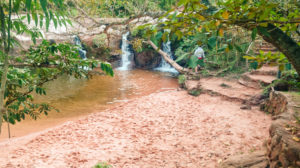 LAS CUEVAS IS only 20km away from Samaipata but a visit to the waterfalls had been recommended. The campsite across the road wedges itself in the elbow of the hairpin as the road crosses the river. I pitched the tent as far from the roadside as I could, then wandered across to visit the falls.
LAS CUEVAS IS only 20km away from Samaipata but a visit to the waterfalls had been recommended. The campsite across the road wedges itself in the elbow of the hairpin as the road crosses the river. I pitched the tent as far from the roadside as I could, then wandered across to visit the falls.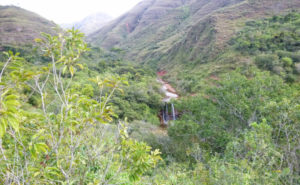 A few people were enjoying the sun and the water. It was a pleasant enough visit but I would have preferred staying at Serena in hindsight. Sometimes a visit is worthwhile to extinguish the curiosity that is carried if ever an opportunity is missed.
A few people were enjoying the sun and the water. It was a pleasant enough visit but I would have preferred staying at Serena in hindsight. Sometimes a visit is worthwhile to extinguish the curiosity that is carried if ever an opportunity is missed.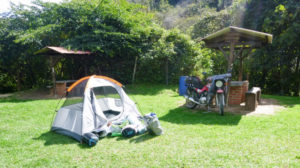
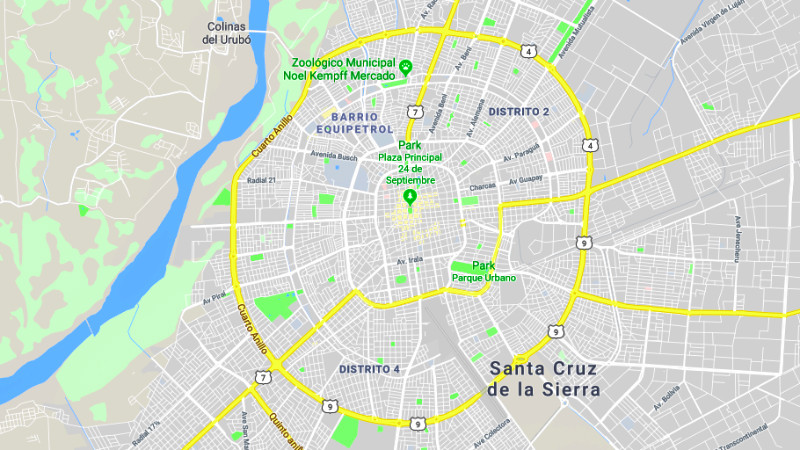 If you imagine the city’s road plan as a giant spider web of four concentric rings, and spokes radiating out from the centre, that’s roughly it with grid sections cut and pasted here and there. The result is, the longer you stay on a road, the less likely you are of knowing where you are and which direction you are facing. The Sun had moved my shadow from left to right. Stopping to check the map, I found I’d gone from the 9 o’clock position to the 4 o’ clock position already. I was travelling anticlockwise around the second to inner road and wanted to turn left across the traffic. Junction after junction was signed “no left turn” and I gave up trying to see the centre and, instead, aimed for the bridge back at about the 10 o’clock position to Santa Cruz. I was tired of the urban battle with the taxis and buses, it was getting late and I hadn’t yet established my campsite.
If you imagine the city’s road plan as a giant spider web of four concentric rings, and spokes radiating out from the centre, that’s roughly it with grid sections cut and pasted here and there. The result is, the longer you stay on a road, the less likely you are of knowing where you are and which direction you are facing. The Sun had moved my shadow from left to right. Stopping to check the map, I found I’d gone from the 9 o’clock position to the 4 o’ clock position already. I was travelling anticlockwise around the second to inner road and wanted to turn left across the traffic. Junction after junction was signed “no left turn” and I gave up trying to see the centre and, instead, aimed for the bridge back at about the 10 o’clock position to Santa Cruz. I was tired of the urban battle with the taxis and buses, it was getting late and I hadn’t yet established my campsite.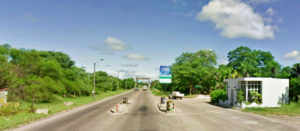 entrepreneur who set up toll gates to recoupe the ten million US dollars he had invested. Apparently, the government told him he couldn’t do that and the crossing had to be free of charge. As a result, the man killed himself and the remains of the toll gates lay inactive, becoming his personal tragic memorial each time I passed. Even more bizarre is the number of government tollgates along the half-built highways across Bolivia. The logic of Latin bureaucracy eludes me…
entrepreneur who set up toll gates to recoupe the ten million US dollars he had invested. Apparently, the government told him he couldn’t do that and the crossing had to be free of charge. As a result, the man killed himself and the remains of the toll gates lay inactive, becoming his personal tragic memorial each time I passed. Even more bizarre is the number of government tollgates along the half-built highways across Bolivia. The logic of Latin bureaucracy eludes me…
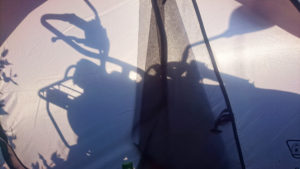 THE MORNING BROUGHT the eastern sun to project the shadow of the bike on the tent wall and I was gently warmed out of my sleeping bag. The night had been chilly but nowhere near as cold as the Altiplano. I drank water but ate no breakfast then decamped at leisure, making sure I left nothing hidden in the leafy undergrowth and hit the road shortly before ten. I only made a hundred km yesterday an I had two hundred and fifty to do today to make Samaipata. It could well mean another night out in the sticks.
THE MORNING BROUGHT the eastern sun to project the shadow of the bike on the tent wall and I was gently warmed out of my sleeping bag. The night had been chilly but nowhere near as cold as the Altiplano. I drank water but ate no breakfast then decamped at leisure, making sure I left nothing hidden in the leafy undergrowth and hit the road shortly before ten. I only made a hundred km yesterday an I had two hundred and fifty to do today to make Samaipata. It could well mean another night out in the sticks.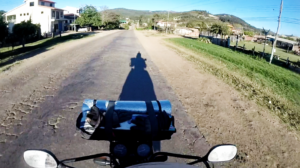 I made good progress and my lengthening shadow led the way into Samaipata shortly before sunset. El Jardin is its name: the camp-ground recommended by Marwa at Samay. She said it was up the hill from Jaguar Azul, which is 0ne possible description of where I was, looking at the map for its location. A guy on a motorbike pulled alongside and spoke some Spanish and I recognised the words Jaguar Azul. “No, El Jardin,” I replied. He thought for a minute and indicated to follow him and so was led to the gate of El Jardin Hostel.
I made good progress and my lengthening shadow led the way into Samaipata shortly before sunset. El Jardin is its name: the camp-ground recommended by Marwa at Samay. She said it was up the hill from Jaguar Azul, which is 0ne possible description of where I was, looking at the map for its location. A guy on a motorbike pulled alongside and spoke some Spanish and I recognised the words Jaguar Azul. “No, El Jardin,” I replied. He thought for a minute and indicated to follow him and so was led to the gate of El Jardin Hostel.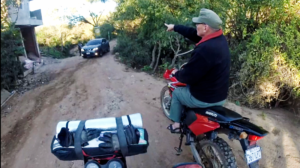 El Jardin has a rustic self-sufficiency feel about it. Cobb walls with bottles inset to make multicoloured windows. The young volunteer booked me in for two nights and introduced herself. “That’s a nice name. Easy to remember” I said, and forgot what it was by the next morning. It wasn’t a problem as I never saw her again.
El Jardin has a rustic self-sufficiency feel about it. Cobb walls with bottles inset to make multicoloured windows. The young volunteer booked me in for two nights and introduced herself. “That’s a nice name. Easy to remember” I said, and forgot what it was by the next morning. It wasn’t a problem as I never saw her again. guitar. I picked a spot as far to the end of the lawn as possible not noticing that the French couple next to me had a dog that would favour laying in the shade of my tent during the day and chew a bone not far from my ears in the middle of the night. “Bonjour,” I said as I was pitching the tent. After a glance at me for a second, they turned away, silent.
guitar. I picked a spot as far to the end of the lawn as possible not noticing that the French couple next to me had a dog that would favour laying in the shade of my tent during the day and chew a bone not far from my ears in the middle of the night. “Bonjour,” I said as I was pitching the tent. After a glance at me for a second, they turned away, silent.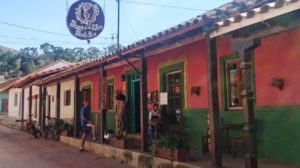 Samaipata is about the same size as Coroico but has readily available WiFi – and is without the steep streets. Breakfast at La Chakana on the main plaza quickly became my regular treat. Round the corner at Tierra Libre, they were showing the World Cup games. Tomorrow would be England v Colombia. Normally, they are closed Tuesdays but the wife of the owner is Colombian and they would be opening for the match.
Samaipata is about the same size as Coroico but has readily available WiFi – and is without the steep streets. Breakfast at La Chakana on the main plaza quickly became my regular treat. Round the corner at Tierra Libre, they were showing the World Cup games. Tomorrow would be England v Colombia. Normally, they are closed Tuesdays but the wife of the owner is Colombian and they would be opening for the match.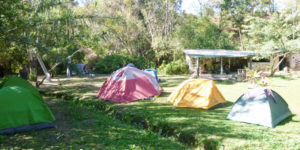 The circus hippies at the El Jardin are as warm and welcoming as a fish pond in February. I approach a Woman wearing a floral dress sitting in a deckchair slurping soup from a spoon and attempt to break the ice. “Hi, where are you from?” She turns to face me. The face is in its late forties or late fifties with a cotton pad taped over one eye and answers in a deep German accent “Where are any of us from?” and I notice the two or three-day stubble on his/her face. The question was intended as an introduction: an extended greeting, not an existential inquiry. I wish him/her Bon appetite and climb the oversize crazy paved steps in suitably long strides towards La Chakana.
The circus hippies at the El Jardin are as warm and welcoming as a fish pond in February. I approach a Woman wearing a floral dress sitting in a deckchair slurping soup from a spoon and attempt to break the ice. “Hi, where are you from?” She turns to face me. The face is in its late forties or late fifties with a cotton pad taped over one eye and answers in a deep German accent “Where are any of us from?” and I notice the two or three-day stubble on his/her face. The question was intended as an introduction: an extended greeting, not an existential inquiry. I wish him/her Bon appetite and climb the oversize crazy paved steps in suitably long strides towards La Chakana.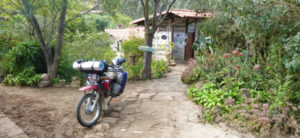 I get back and book a third night at Samaipata and feel it’s enough, I’m done and I’m happy to leave the circus hippies in the garden. One more breakfast at La Chakana with the loaded bike parked where I can see it from my table and then ride to Hostel Serena for the promised tea. I meet Bert coming down the lane on his 250 motorcycle and he tells me to let myself in at
I get back and book a third night at Samaipata and feel it’s enough, I’m done and I’m happy to leave the circus hippies in the garden. One more breakfast at La Chakana with the loaded bike parked where I can see it from my table and then ride to Hostel Serena for the promised tea. I meet Bert coming down the lane on his 250 motorcycle and he tells me to let myself in at 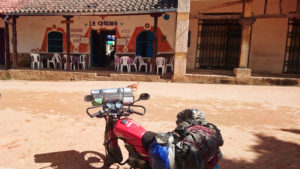 his hostel, he’ll only be 15 minutes. Hostel Serena is an immaculate place with views over the Samaipata rooftops. Camping here costs twice El Jardin but includes breakfast. Adding El Jardin to La Chakana brings it on a par… The place feels like a retreat for unwinding. I was tempted to stay but reluctant to unpack the bike again and so I stuck with my plan toward Las Cuevas on the way to Santa Cruz.
his hostel, he’ll only be 15 minutes. Hostel Serena is an immaculate place with views over the Samaipata rooftops. Camping here costs twice El Jardin but includes breakfast. Adding El Jardin to La Chakana brings it on a par… The place feels like a retreat for unwinding. I was tempted to stay but reluctant to unpack the bike again and so I stuck with my plan toward Las Cuevas on the way to Santa Cruz.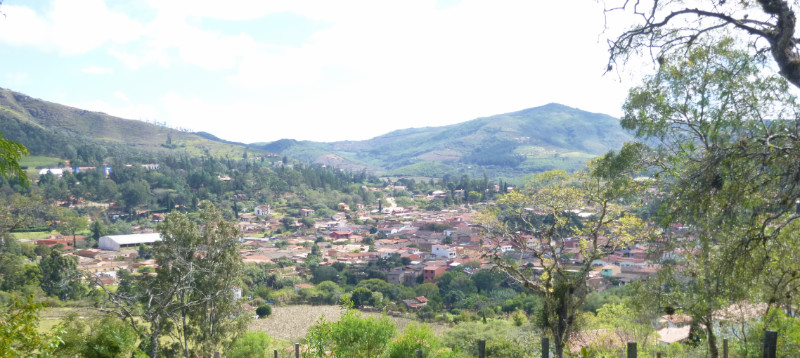
 THE SAMAY HOSTEL bustles with young twenty-somethings and me. I have the last available bunk in an eight-bed dorm. The bed is wide and covered sheets and one thin bedspread. Warm enough for the climate and light on my body, so comfortable, that the next morning, I book another 3 nights.
THE SAMAY HOSTEL bustles with young twenty-somethings and me. I have the last available bunk in an eight-bed dorm. The bed is wide and covered sheets and one thin bedspread. Warm enough for the climate and light on my body, so comfortable, that the next morning, I book another 3 nights.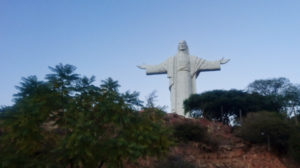 Up the hill is the Cristo de la Concordia. A monument to JC himself, a metre taller than the famous monument in Rio de Janiero. The Teleferic up the hill is closed for maintenance with no sign of maintenance activity as I walk past shortly before 5pm and head for the stairs up the hillside to catch the sunset.
Up the hill is the Cristo de la Concordia. A monument to JC himself, a metre taller than the famous monument in Rio de Janiero. The Teleferic up the hill is closed for maintenance with no sign of maintenance activity as I walk past shortly before 5pm and head for the stairs up the hillside to catch the sunset.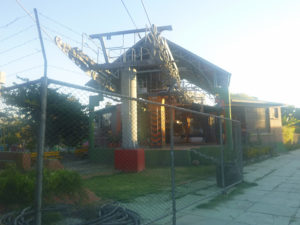 The sun maybe above the horizon but is already behind a hill in the distance. I climb the stairs rapidly to see if I can catch it but the sun is sinking faster than I am rising and I stop to catch my breath. The climb takes about thirty minutes and is a fair workout for the legs and cardio system. With the cable car out of action, there are no elderly or infirm visitors here but a good smattering of families and couples taking pictures and admiring the cityscape light up through the balmy dusk.
The sun maybe above the horizon but is already behind a hill in the distance. I climb the stairs rapidly to see if I can catch it but the sun is sinking faster than I am rising and I stop to catch my breath. The climb takes about thirty minutes and is a fair workout for the legs and cardio system. With the cable car out of action, there are no elderly or infirm visitors here but a good smattering of families and couples taking pictures and admiring the cityscape light up through the balmy dusk.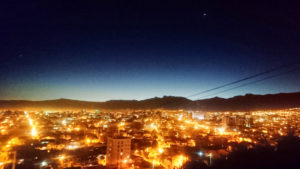 Darkness falls before I descend and I quietly tread the steps down through the chirp of tropical treefrogs and crickets. Dark but not cold feels like a dream after La Paz: like it shouldn’t be possible in reality. No-one is around between the descent and arriving at the hostel.
Darkness falls before I descend and I quietly tread the steps down through the chirp of tropical treefrogs and crickets. Dark but not cold feels like a dream after La Paz: like it shouldn’t be possible in reality. No-one is around between the descent and arriving at the hostel.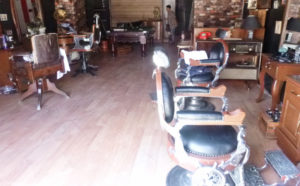 Will, an English Ski instructor who works 6 months and takes 6 months off, on his mission to make it a full 12 months, a year is in the bunk below me. Directs me to useful shops and cafes within walking distance and recommends a barber that gives a good straight shave. I’ve never had one before so I head there first thing in the morning. I arrive less than a minute before the young latin owner turns up to raise the anonymous-looking matt black shutters revealing what looks like an immaculate looking fifties style film set of a barber shop.
Will, an English Ski instructor who works 6 months and takes 6 months off, on his mission to make it a full 12 months, a year is in the bunk below me. Directs me to useful shops and cafes within walking distance and recommends a barber that gives a good straight shave. I’ve never had one before so I head there first thing in the morning. I arrive less than a minute before the young latin owner turns up to raise the anonymous-looking matt black shutters revealing what looks like an immaculate looking fifties style film set of a barber shop.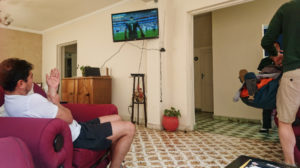 Over the next 10 days. I enjoy Marwa’s breakfasts and getting to know some of the travellers that pass through the hostel and following the World Cup qualifiers and the Argentina France match in the initial knock out stages with two Argentines and two French people.
Over the next 10 days. I enjoy Marwa’s breakfasts and getting to know some of the travellers that pass through the hostel and following the World Cup qualifiers and the Argentina France match in the initial knock out stages with two Argentines and two French people. Out and about revealed the opulent Recoleta area, with the gem of a ‘Game of Thrones’ themed cafe named the Coffee of Westeros.
Out and about revealed the opulent Recoleta area, with the gem of a ‘Game of Thrones’ themed cafe named the Coffee of Westeros.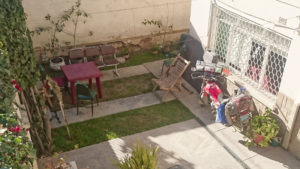 And so, I found myself eastbound on Route 4. After a far too leisurely morning packing and then talking to a German couple that rode in on 150 Hondas from Chile. 3 pm and I was only just exiting Cochabamba with the sun on my back. Glancing over my shoulder the distant Cristo on the hill had his back to me. I didn’t expect him to wave, but still… I could have stayed longer, in fact, I wanted to but I’d hit my
And so, I found myself eastbound on Route 4. After a far too leisurely morning packing and then talking to a German couple that rode in on 150 Hondas from Chile. 3 pm and I was only just exiting Cochabamba with the sun on my back. Glancing over my shoulder the distant Cristo on the hill had his back to me. I didn’t expect him to wave, but still… I could have stayed longer, in fact, I wanted to but I’d hit my 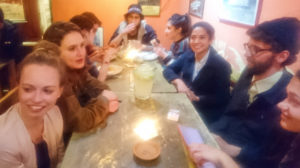 visa limit in Bolivia in short enough time. 90 days a year, Bolivia allows tourists. 3 months in, 9 months out. I needed to save some time for the return trip… or take 9 months through Braazil, Paraguay, Uruguay and Argentina.
visa limit in Bolivia in short enough time. 90 days a year, Bolivia allows tourists. 3 months in, 9 months out. I needed to save some time for the return trip… or take 9 months through Braazil, Paraguay, Uruguay and Argentina.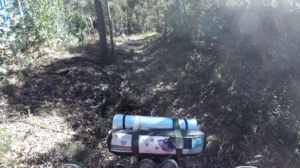 Five kilometres down the road, trees on a hilltop. A track leading down to the river between a roadside cemetery and the wooded hill. Turning right of the road thirty metres down the dirt track I veered into a clearing up the hill discovering a Plateau that was level and fairly hidden from the road and the view from the settlements on the surrounded hills.
Five kilometres down the road, trees on a hilltop. A track leading down to the river between a roadside cemetery and the wooded hill. Turning right of the road thirty metres down the dirt track I veered into a clearing up the hill discovering a Plateau that was level and fairly hidden from the road and the view from the settlements on the surrounded hills.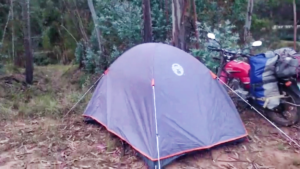 I took off my orange jacket to make myself less conspicuous while I deployed the silver tent as discreetly as possible. Clouds were brushing the green peaks of the surrounding mountains. A farmer was burning fields further up the mountainside to my Northeast. I could make out a figure in the doorway of their farmhouse. Were they looking at me? No, I was in the shade of the tree and they would be busy with the fire. Dogs were barking in the distance, as they seem to all over South America. A continent of a continuous network of barking.
I took off my orange jacket to make myself less conspicuous while I deployed the silver tent as discreetly as possible. Clouds were brushing the green peaks of the surrounding mountains. A farmer was burning fields further up the mountainside to my Northeast. I could make out a figure in the doorway of their farmhouse. Were they looking at me? No, I was in the shade of the tree and they would be busy with the fire. Dogs were barking in the distance, as they seem to all over South America. A continent of a continuous network of barking.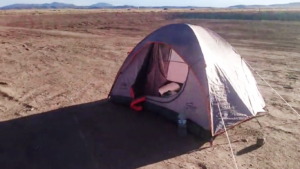 I AWOKE AT four unable to get back to sleep for the cold. Not as cold as Titicaca but still not comfortable and the sun was still more than two hours away.
I AWOKE AT four unable to get back to sleep for the cold. Not as cold as Titicaca but still not comfortable and the sun was still more than two hours away.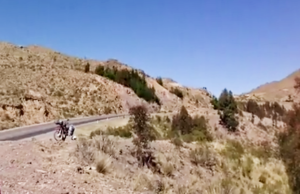 I pass through Caihuasi and spot the fuel station on the edge of the village on my right. Problem is, the access has been bisected by the carriageway construction. Even if I could cross it, the station is closed and unattended. It would be tight making it to Cochabamba with what my fuel gauge had to offer. It depended on how much up, down, rough, smooth and gear changing would be involved. All I could do was watch what happens along the way.
I pass through Caihuasi and spot the fuel station on the edge of the village on my right. Problem is, the access has been bisected by the carriageway construction. Even if I could cross it, the station is closed and unattended. It would be tight making it to Cochabamba with what my fuel gauge had to offer. It depended on how much up, down, rough, smooth and gear changing would be involved. All I could do was watch what happens along the way.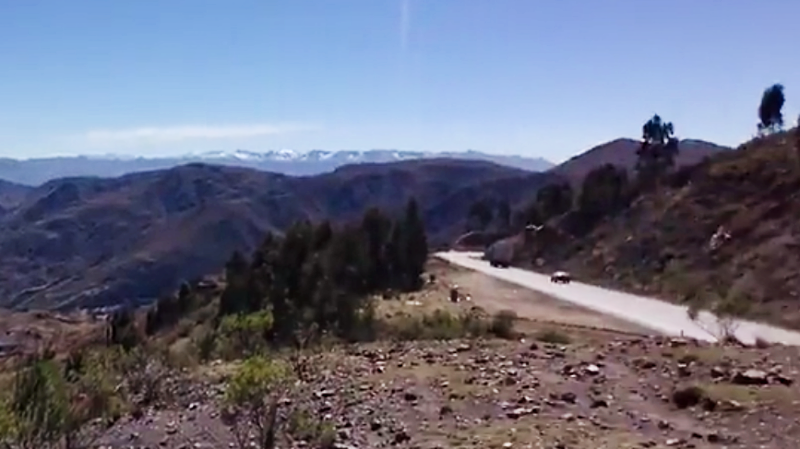 I’m over the peaks now as I can see far into the east, the mountain peaks, islands in a hazy white sea as humidity… or smog… and I can see I’m now a lot lower than the snow line on the distant peaks. The air becomes noticeably warmer as the day progresses. The heat of the day is accumulated and reflected around the mountain passes and aided by gradually reducing altitude.
I’m over the peaks now as I can see far into the east, the mountain peaks, islands in a hazy white sea as humidity… or smog… and I can see I’m now a lot lower than the snow line on the distant peaks. The air becomes noticeably warmer as the day progresses. The heat of the day is accumulated and reflected around the mountain passes and aided by gradually reducing altitude.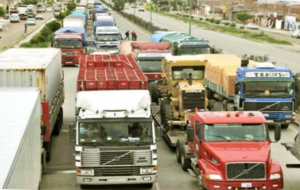 trucks, a queue of unknown length, as I start to filter down the middle. The trucks become less organized and block my way. Doors are open and drivers are missing and I weave on and off the verge. Progress is slow and I notice a gap in the central reservation and pass through to ride down the opposite carriageway. A handful of vehicles pass the other way, southbound and I continue a couple of miles past the queue to another blockade and sit with the motor ticking over considering my plan. To my left is a restaurant, in the shade of the early afternoon sun and I turn off the road, park the bike under a tree and take a table on the patio in front of the restaurant, order some lunch and scroll through the map on my phone…
trucks, a queue of unknown length, as I start to filter down the middle. The trucks become less organized and block my way. Doors are open and drivers are missing and I weave on and off the verge. Progress is slow and I notice a gap in the central reservation and pass through to ride down the opposite carriageway. A handful of vehicles pass the other way, southbound and I continue a couple of miles past the queue to another blockade and sit with the motor ticking over considering my plan. To my left is a restaurant, in the shade of the early afternoon sun and I turn off the road, park the bike under a tree and take a table on the patio in front of the restaurant, order some lunch and scroll through the map on my phone…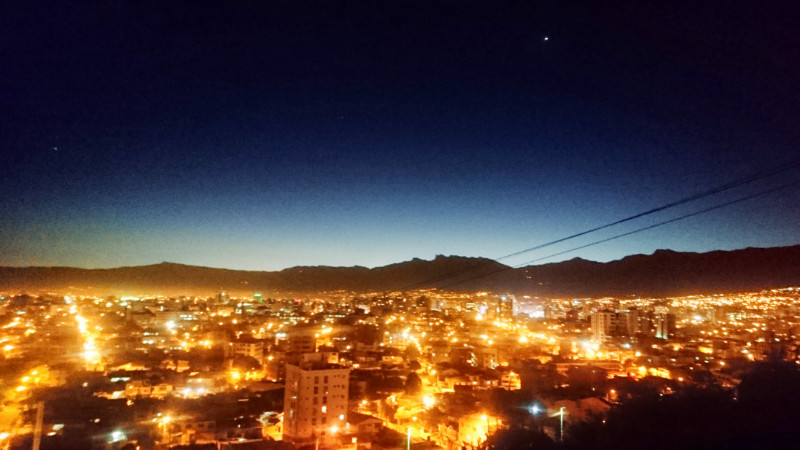
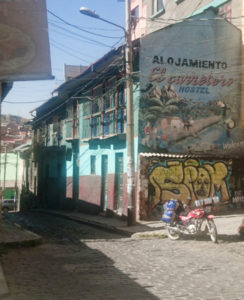 RATTLING ALONG THE cobbles, I had the sun on my back finally riding to Cochabamba. The warm dry morning eased my thoughts about camping out in the chilly nights of the Altiplano and I set my focus on the weaving taxis and buses as I threaded my way through them out of La Paz onto the escalating loop into El Alto.
RATTLING ALONG THE cobbles, I had the sun on my back finally riding to Cochabamba. The warm dry morning eased my thoughts about camping out in the chilly nights of the Altiplano and I set my focus on the weaving taxis and buses as I threaded my way through them out of La Paz onto the escalating loop into El Alto. Trapped between the barriers of the dual carriageway, I noticed a coned off gap in the central reservation. Over the other side of the road, a lane filtering off into El Alto was congested by inbound minibuses. Cutting through the cones and past the buses exchanging passengers for pedestrians through their sliding doors, I found myself back on route 1 and the sporadic drag races from traffic light to
Trapped between the barriers of the dual carriageway, I noticed a coned off gap in the central reservation. Over the other side of the road, a lane filtering off into El Alto was congested by inbound minibuses. Cutting through the cones and past the buses exchanging passengers for pedestrians through their sliding doors, I found myself back on route 1 and the sporadic drag races from traffic light to 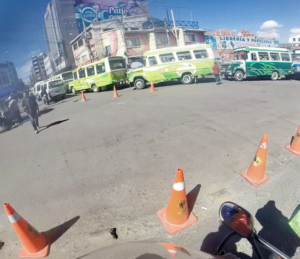 traffic light. The fuel gauge was nudging ‘E’. With the pressure off battling urban traffic, I could divert my focus to watching for a fuels station.
traffic light. The fuel gauge was nudging ‘E’. With the pressure off battling urban traffic, I could divert my focus to watching for a fuels station.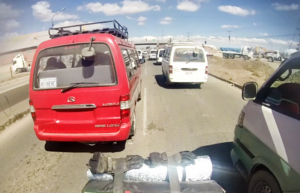 Pulling out of the Fuel station, heading south on route 1, the urban sprawl was slowly dissolving into flat plains. The air was noticeably cooler as my cruising speed was increasing through the heights of El Alto. With the disappearance of the city suburbs, the plains looked like desert but there was evidence of crops planted in vaguely marked fields. Dry and barren looking, I wondered how anything managed to grow under the radiant, parching sun and the ice-cool moon.
Pulling out of the Fuel station, heading south on route 1, the urban sprawl was slowly dissolving into flat plains. The air was noticeably cooler as my cruising speed was increasing through the heights of El Alto. With the disappearance of the city suburbs, the plains looked like desert but there was evidence of crops planted in vaguely marked fields. Dry and barren looking, I wondered how anything managed to grow under the radiant, parching sun and the ice-cool moon.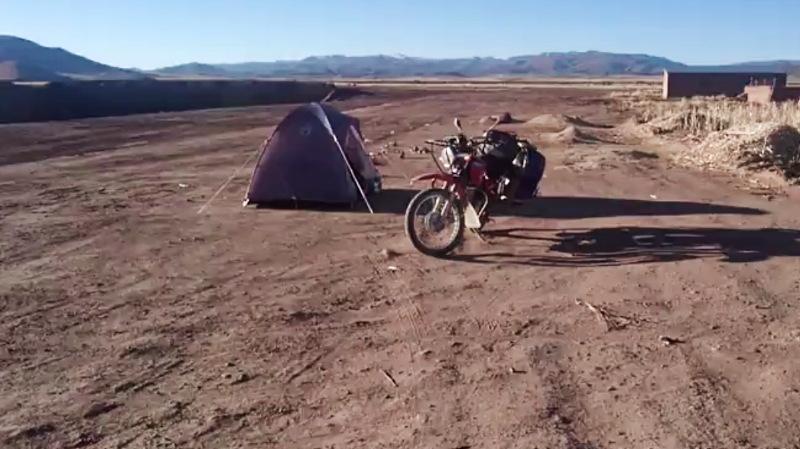 Just over the river were two hostels: Alojamiento Panamerica and Pension Villa Puente. Too early to turn in and too late to set off. I decided to head to the wild camping spot a few kilometres down the road, apparently next to a giant gravel mound at a quarry. Turning off route 4 onto a farm track and travelling about five hundred metres across the flat featureless landscape, I came across a giant hole in the ground about a hundred and fifty metres long and a hundred metres wide, with a few farm shacks to the eastern edge. I rode around to that side and found nobody there. The place seemed deserted for miles around and the hard flat area surrounding the hole was a perfect pitch and I broke out camp right there with the tent’s entrance estimated to the part of the sky that the sun would rise.
Just over the river were two hostels: Alojamiento Panamerica and Pension Villa Puente. Too early to turn in and too late to set off. I decided to head to the wild camping spot a few kilometres down the road, apparently next to a giant gravel mound at a quarry. Turning off route 4 onto a farm track and travelling about five hundred metres across the flat featureless landscape, I came across a giant hole in the ground about a hundred and fifty metres long and a hundred metres wide, with a few farm shacks to the eastern edge. I rode around to that side and found nobody there. The place seemed deserted for miles around and the hard flat area surrounding the hole was a perfect pitch and I broke out camp right there with the tent’s entrance estimated to the part of the sky that the sun would rise.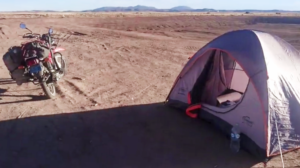 The afternoon was late but the sun was still about an hour off the horizon. The breeze was light but getting colder and I found sanctuary inside the tent – a perfect temperature in which to rest, warmed by the falling sun. Checking the map, I found I was only halfway to the marked wild camping spot. I could still see no mound or quarry. No matter, I would be gone early in the morning. I would stay here.
The afternoon was late but the sun was still about an hour off the horizon. The breeze was light but getting colder and I found sanctuary inside the tent – a perfect temperature in which to rest, warmed by the falling sun. Checking the map, I found I was only halfway to the marked wild camping spot. I could still see no mound or quarry. No matter, I would be gone early in the morning. I would stay here.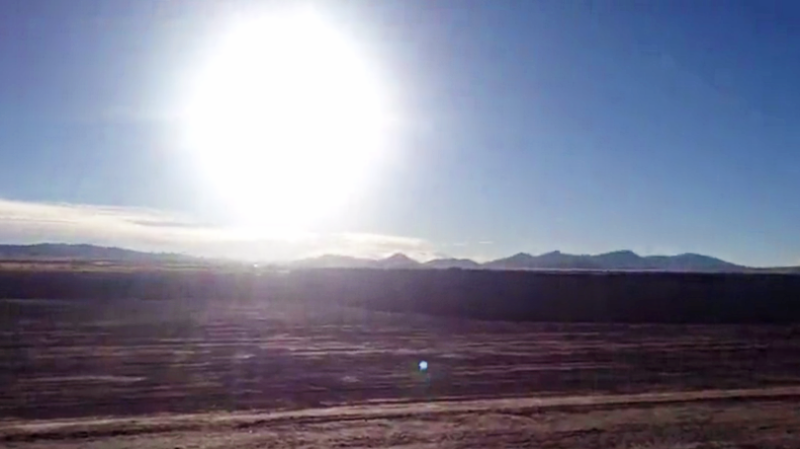
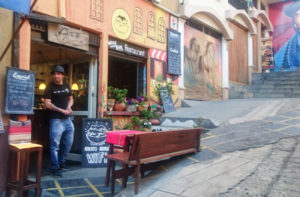 FINDING EXCUSES TO stay in La Paz wasn’t difficult. The WiFi drought in Coroico gave me some catching up to do online. The Higher Ground Cafe became a sanctuary of warmth, inspiration and productivity in the daylight hours. Even so, the evening cold was beginning to bother me in the hostel. I would kick off my boots tuck myself under the blankets with the hood up on my coat and either read, write, surf or watch a movie until I was tired enough to sleep.
FINDING EXCUSES TO stay in La Paz wasn’t difficult. The WiFi drought in Coroico gave me some catching up to do online. The Higher Ground Cafe became a sanctuary of warmth, inspiration and productivity in the daylight hours. Even so, the evening cold was beginning to bother me in the hostel. I would kick off my boots tuck myself under the blankets with the hood up on my coat and either read, write, surf or watch a movie until I was tired enough to sleep.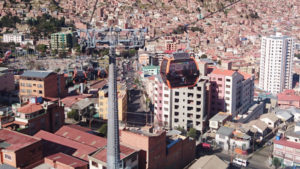 My
My  Univida s.a. We had communication problems but hammered out some sort of understanding using language going back to the stone age. No international insurance possible for foreign vehicles, although he gave me a piece of paper that looked like cover in Bolivia until December. I’d check with the Embassy, tomorrow… no rush…
Univida s.a. We had communication problems but hammered out some sort of understanding using language going back to the stone age. No international insurance possible for foreign vehicles, although he gave me a piece of paper that looked like cover in Bolivia until December. I’d check with the Embassy, tomorrow… no rush… me and the security guard. After a conversation mentioning “no comprendo” and “Manchester United” I’m offered the reception phone and speak to an Englishman and get directed to the Vice Consul on the third floor. She calls La Positiva, the Peruvian insurance company, who tells her that I should arrange insurance online and I leave with a URL written on the back of her business card… it doesn’t seem to be a big deal since 30 days SOAT free immunity is granted in Bolivia.
me and the security guard. After a conversation mentioning “no comprendo” and “Manchester United” I’m offered the reception phone and speak to an Englishman and get directed to the Vice Consul on the third floor. She calls La Positiva, the Peruvian insurance company, who tells her that I should arrange insurance online and I leave with a URL written on the back of her business card… it doesn’t seem to be a big deal since 30 days SOAT free immunity is granted in Bolivia. I walk three kilometres to the Yellow Teleferico on the rim of El Alto, which gets me closest to the immigration office, and pause for lunch overlooking the cityscape of La Paz. Does it really matter, spending all this time chasing paper? What else would I be doing? It’s all part of the adventure so not worth getting irritated about… these series of unfulfilled expectations. Embrace the uncertainty is what Susan Jeffers says in her book. Why not, let’s call it adventures in bureaucracy?
I walk three kilometres to the Yellow Teleferico on the rim of El Alto, which gets me closest to the immigration office, and pause for lunch overlooking the cityscape of La Paz. Does it really matter, spending all this time chasing paper? What else would I be doing? It’s all part of the adventure so not worth getting irritated about… these series of unfulfilled expectations. Embrace the uncertainty is what Susan Jeffers says in her book. Why not, let’s call it adventures in bureaucracy?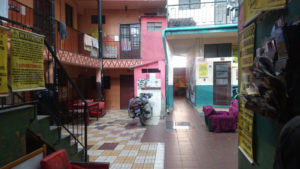 Tuesday came and I didn’t really feel like getting up and packing. I didn’t really feel like doing anything else either, so I stopped thinking about it and got up, showered under lukewarm water in the cold air, packed and stacked the bike ready to go.
Tuesday came and I didn’t really feel like getting up and packing. I didn’t really feel like doing anything else either, so I stopped thinking about it and got up, showered under lukewarm water in the cold air, packed and stacked the bike ready to go.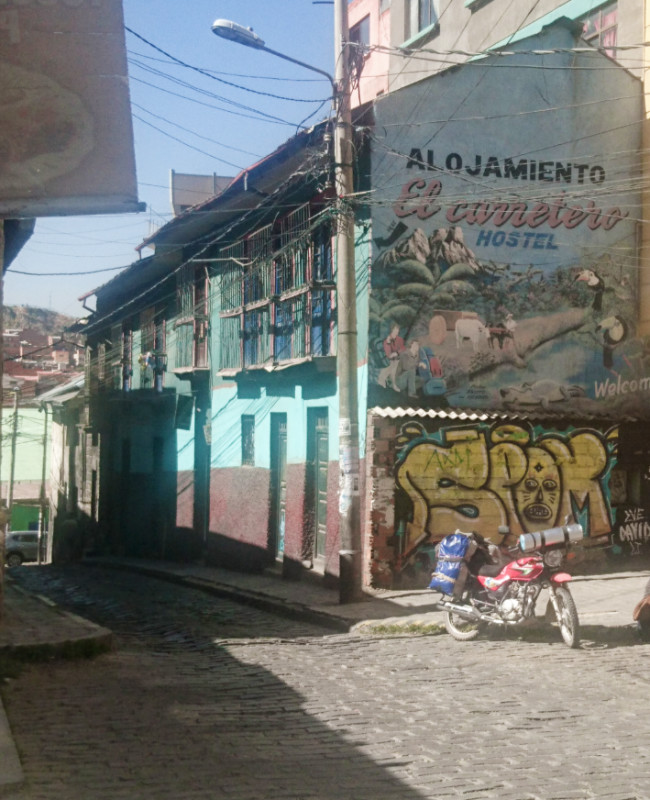
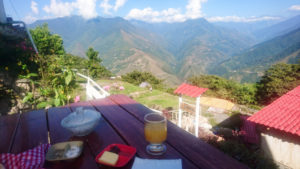 BREAKFAST AND LOADING up the bike in the morning, I say my final farewells to Luis and Fernando, fine hosts who I’ll miss. Fernando seems to think I can make the hill up to the town, but I’m still doubtful. I roll down the hill to get a run up the steep cobbles. Keeping the revs up I’m fast across the rough surface and the bike attacks the base of the incline and jumps around the oversize cobbles up the hill. I’m standing on the footpegs fully committed now. Stopping would be a disaster and end in a
BREAKFAST AND LOADING up the bike in the morning, I say my final farewells to Luis and Fernando, fine hosts who I’ll miss. Fernando seems to think I can make the hill up to the town, but I’m still doubtful. I roll down the hill to get a run up the steep cobbles. Keeping the revs up I’m fast across the rough surface and the bike attacks the base of the incline and jumps around the oversize cobbles up the hill. I’m standing on the footpegs fully committed now. Stopping would be a disaster and end in a  certain spill at this incline on this surface. Barking dogs start the chase but give up about twenty metres later with the bike leaping over the boulder-sized cobbles. the engine note starts to wane but all I can do is hang on for the ride holding the throttle fully open. And I make the top with momentum and revs to spare. Reaching the
certain spill at this incline on this surface. Barking dogs start the chase but give up about twenty metres later with the bike leaping over the boulder-sized cobbles. the engine note starts to wane but all I can do is hang on for the ride holding the throttle fully open. And I make the top with momentum and revs to spare. Reaching the  junction at the top of the hill, I’m carrying on whatever ‘s coming. Parked cars were all there were. There was no round of applause from the onlookers watching me bounding up to the junction, but I got the impression that not many fully loaded 125s are seen taking this particular route and I cruised around the corner without bothering to stop.
junction at the top of the hill, I’m carrying on whatever ‘s coming. Parked cars were all there were. There was no round of applause from the onlookers watching me bounding up to the junction, but I got the impression that not many fully loaded 125s are seen taking this particular route and I cruised around the corner without bothering to stop. The gloves are off; partly for the challenge of offroading across Bolivia and partly because my hands are warm. My jacket is packed away and I wear combat trousers and cotton top to enjoy the warm dry weather while I have it.
The gloves are off; partly for the challenge of offroading across Bolivia and partly because my hands are warm. My jacket is packed away and I wear combat trousers and cotton top to enjoy the warm dry weather while I have it.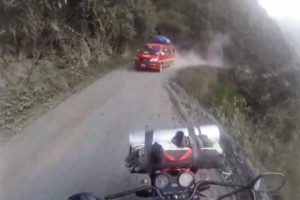 The track is often wide but sometimes narrows as it winds its way around the contours of the mountains, not as high as the North Yungas Road but every bit as dangerous. Speed humps are camouflaged by the dust in the villages but I’ve come to expect them and slow as a matter of course. Chickens scatter between the huts and lazy dogs lift their heads and sometimes move out of the way, sometimes not, as I drift by either side.
The track is often wide but sometimes narrows as it winds its way around the contours of the mountains, not as high as the North Yungas Road but every bit as dangerous. Speed humps are camouflaged by the dust in the villages but I’ve come to expect them and slow as a matter of course. Chickens scatter between the huts and lazy dogs lift their heads and sometimes move out of the way, sometimes not, as I drift by either side.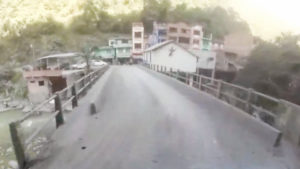 Eventually, I cross the bridge to Puente Villa. Despite Luis’ assurances that it is a good road to Cochabamba, there is no indication that it improves any past Puente Villa. I’m not certain Luis has even seen a paved road. I’m already beige with trail dust and taking half a day to travel fifty kilometres could mean taking a dirty and gruelling week to Cochabamba. I hang a U-turn and cross the bridge to pick up the westbound South Yungas road towards La Paz.
Eventually, I cross the bridge to Puente Villa. Despite Luis’ assurances that it is a good road to Cochabamba, there is no indication that it improves any past Puente Villa. I’m not certain Luis has even seen a paved road. I’m already beige with trail dust and taking half a day to travel fifty kilometres could mean taking a dirty and gruelling week to Cochabamba. I hang a U-turn and cross the bridge to pick up the westbound South Yungas road towards La Paz.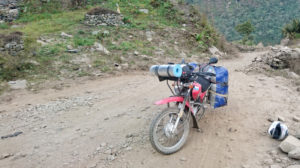 The earth was red and loose with large rocks scattered along its surface. I had to keep the revs high to stay in the power band in order to climb the hill. Jumping and bucking over the rough ground, I made the first couple of slopes but, on the third slope, the engine bogged down on the steepest section at the top of the third slope. I stepped off the bike and left it resting for a few minutes to cool down. A minibus came bouncing down around the bend and rocked its way down around the last bend I managed and disappeared into the valley. Looking up, I could see where the bends were dug away. There were at least another four more, as the road climbed like a ladder up the mountain.
The earth was red and loose with large rocks scattered along its surface. I had to keep the revs high to stay in the power band in order to climb the hill. Jumping and bucking over the rough ground, I made the first couple of slopes but, on the third slope, the engine bogged down on the steepest section at the top of the third slope. I stepped off the bike and left it resting for a few minutes to cool down. A minibus came bouncing down around the bend and rocked its way down around the last bend I managed and disappeared into the valley. Looking up, I could see where the bends were dug away. There were at least another four more, as the road climbed like a ladder up the mountain.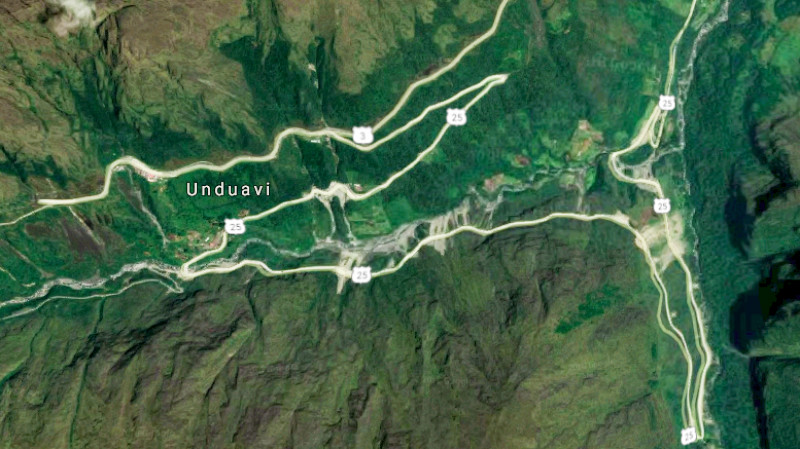 Options from here? forty-five kilometres back to Puente Villa, one hundred back to Coroico, five hundred to Cochabamba. The Coroico route was the only other to La Paz and it had already taken most of the day to get here. It would be dark soon. There was no other choice: this dirt ladder or nothing. After a brief rest and more contemplation, I fired up the bike and did the same as I did in La Paz. Used the engine as well as push at the same time to get the bike up to the apex of the bend. It’s a difficult skill to regulate either the revs or the bike speed without dropping it but I was getting the hang of it. I felt better past that steep section and on the more level ground at the outer apex of the bend and I rested and stopped to think a bit more.
Options from here? forty-five kilometres back to Puente Villa, one hundred back to Coroico, five hundred to Cochabamba. The Coroico route was the only other to La Paz and it had already taken most of the day to get here. It would be dark soon. There was no other choice: this dirt ladder or nothing. After a brief rest and more contemplation, I fired up the bike and did the same as I did in La Paz. Used the engine as well as push at the same time to get the bike up to the apex of the bend. It’s a difficult skill to regulate either the revs or the bike speed without dropping it but I was getting the hang of it. I felt better past that steep section and on the more level ground at the outer apex of the bend and I rested and stopped to think a bit more.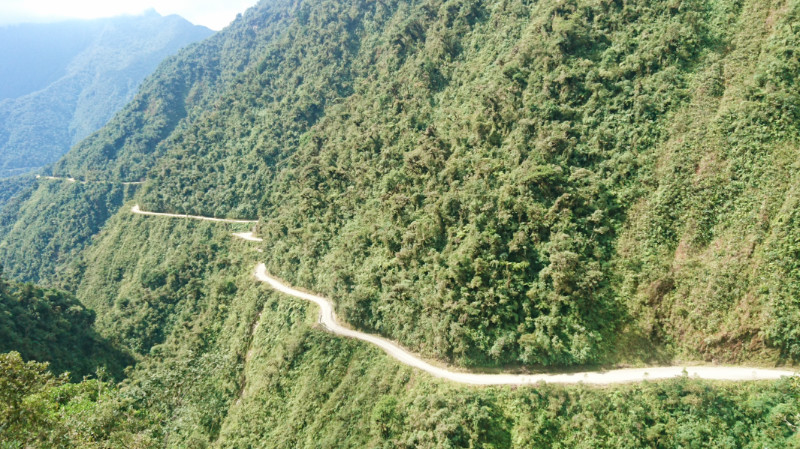 AS THE TYRES left the smooth black asphalt of route 3 and crunched the gravel of El Camino de la Muerte, first impressions were that it was very similar to the Santa Teresa road in Peru, only higher and strikingly more beautiful. At a height of up to 800 metres (2000ft) above the river in the jungle below the mountains, it was a gut-churning experience seeing the road and mountain rush pass in relation to my motion and the distant jungle floor, being so far away, appearing to not move at all.
AS THE TYRES left the smooth black asphalt of route 3 and crunched the gravel of El Camino de la Muerte, first impressions were that it was very similar to the Santa Teresa road in Peru, only higher and strikingly more beautiful. At a height of up to 800 metres (2000ft) above the river in the jungle below the mountains, it was a gut-churning experience seeing the road and mountain rush pass in relation to my motion and the distant jungle floor, being so far away, appearing to not move at all.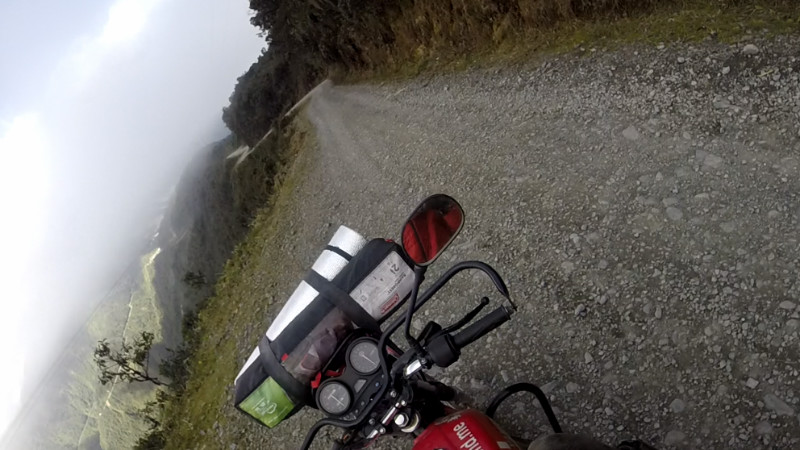 The cloud was left far behind, clinging to the peak near the start of the road and I was warmed by the sun as I slowly descended. The road weaved in and out of the mountains, some edges having crumbled away revealing the vertical landscape. Cooling splashes from waterfalls that landed over the road and continued along and over the edges. So beautiful is the scenery that it distracts your gaze. With the road at as narrow as three metres in places, distraction wasn’t wise, with death a metre or two away.
The cloud was left far behind, clinging to the peak near the start of the road and I was warmed by the sun as I slowly descended. The road weaved in and out of the mountains, some edges having crumbled away revealing the vertical landscape. Cooling splashes from waterfalls that landed over the road and continued along and over the edges. So beautiful is the scenery that it distracts your gaze. With the road at as narrow as three metres in places, distraction wasn’t wise, with death a metre or two away.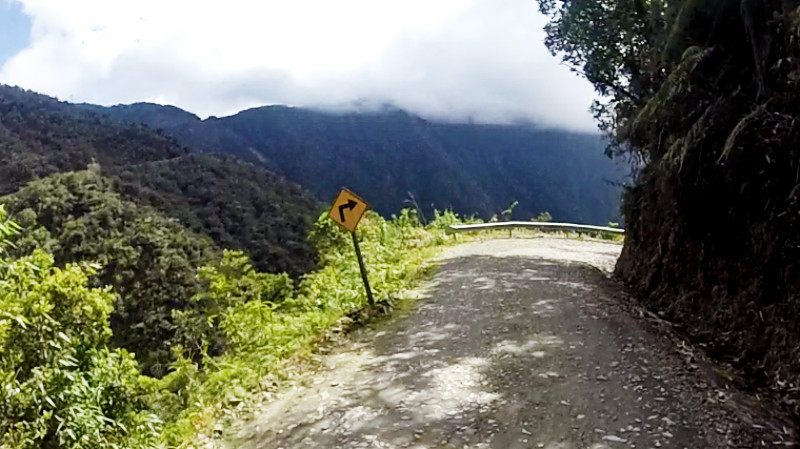 Some way down the road, I was stopped at a toll gate, You pay to get in these days. like a fairground ride except you bring your own equipment. Further down: traffic. a tour group on mountain bikes, lycra clad adventurers on a briefing watched me and my luggage idle by and out of sight.
Some way down the road, I was stopped at a toll gate, You pay to get in these days. like a fairground ride except you bring your own equipment. Further down: traffic. a tour group on mountain bikes, lycra clad adventurers on a briefing watched me and my luggage idle by and out of sight.
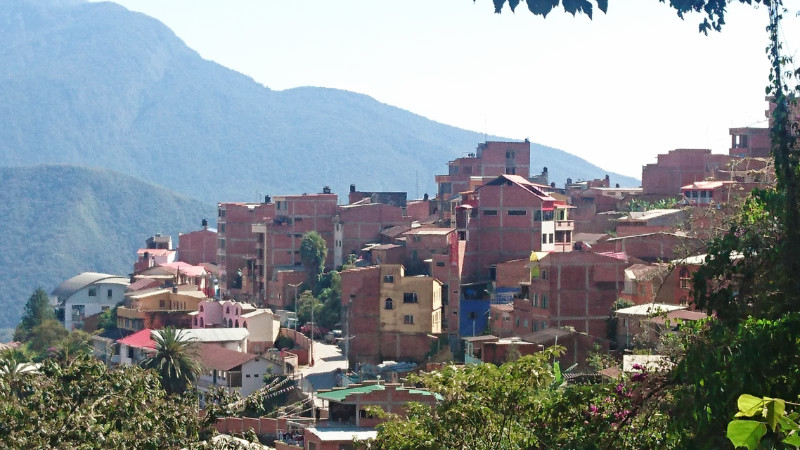 Plaza and down the steep cobbles the other side, brought me to the gate of the El Gecko campsite. A family-run hostel and campsite with stunning views over the valley at the end of El Camino de la Muerte, North Yungas.
Plaza and down the steep cobbles the other side, brought me to the gate of the El Gecko campsite. A family-run hostel and campsite with stunning views over the valley at the end of El Camino de la Muerte, North Yungas.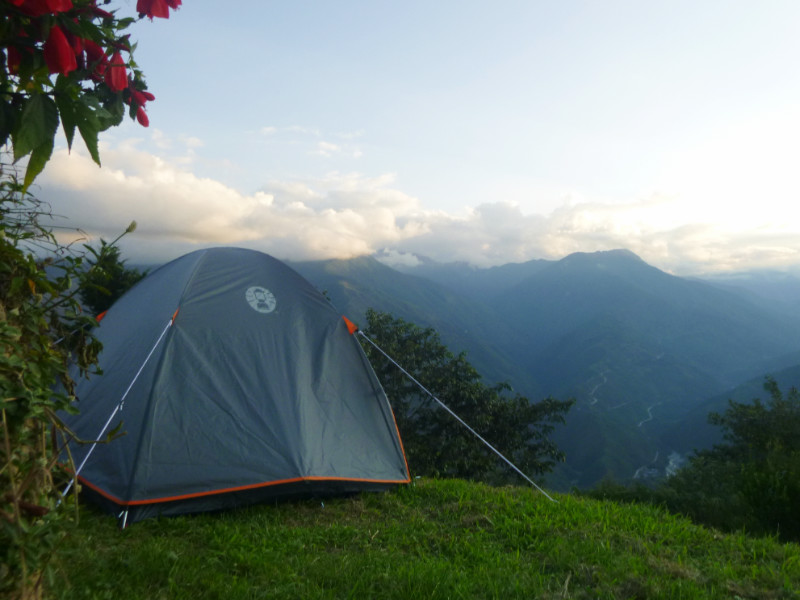 Once base camp on the lawn was established. I collected my laptop and notepads together in a satchel and set about climbing the cobbles to the village. It wasn’t too far but still arduous. At 1700 metres, the altitude was noticeably easier to on the lungs compared to Titicaca or La Paz. I was out of breath but I could still carry on climbing.
Once base camp on the lawn was established. I collected my laptop and notepads together in a satchel and set about climbing the cobbles to the village. It wasn’t too far but still arduous. At 1700 metres, the altitude was noticeably easier to on the lungs compared to Titicaca or La Paz. I was out of breath but I could still carry on climbing.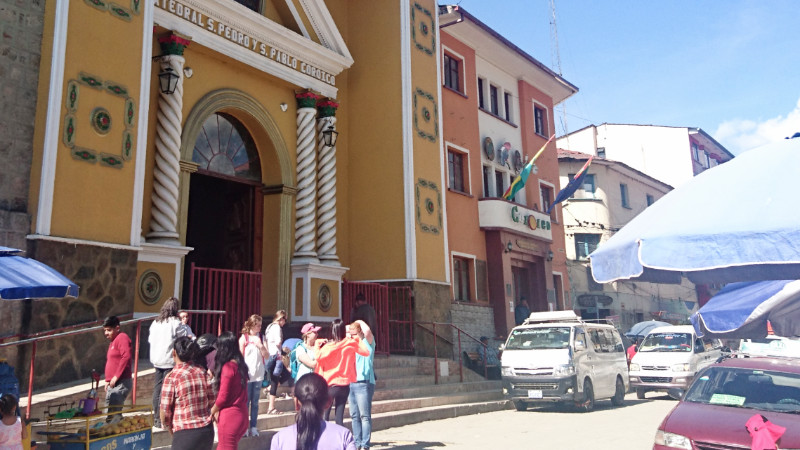 I’d left my phone with Fernando to charge. I’d be glad of that later: no book, no light, no wifi or PC. I’d look forward to reading the Kindle. My equipment list needs some tweaking to accommodate ‘vida sin electricidad.’ A quartet of young French travellers had arrived and pitched their tents not far from mine. “Bonjour!” I call. They turn… nothing and they look away. What am I invisible? They stick amongst themselves and we share the campsite as separate factions. Me in my group of one and them in their group of four.
I’d left my phone with Fernando to charge. I’d be glad of that later: no book, no light, no wifi or PC. I’d look forward to reading the Kindle. My equipment list needs some tweaking to accommodate ‘vida sin electricidad.’ A quartet of young French travellers had arrived and pitched their tents not far from mine. “Bonjour!” I call. They turn… nothing and they look away. What am I invisible? They stick amongst themselves and we share the campsite as separate factions. Me in my group of one and them in their group of four.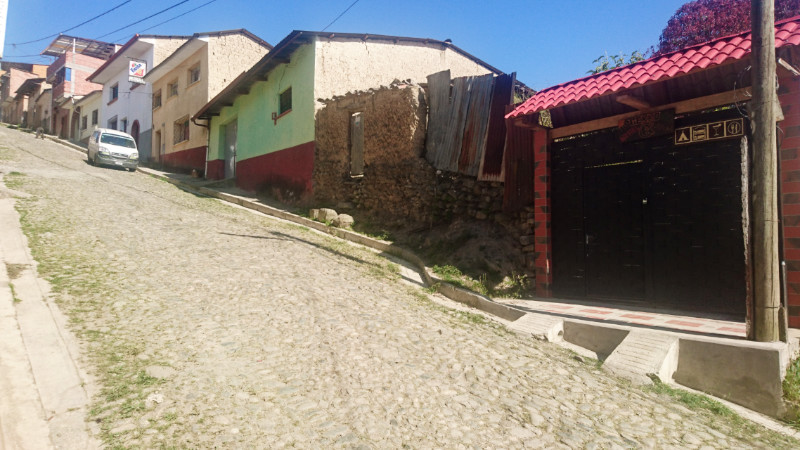 After dinner around the Plaza, I return to El Gecko about an hour after sunset. The French quartet are socialising around the table about fifteen feet from my tent. I secretly hope they aren’t going to be long, or loud, and I retrieve the phone from Fernando and retreat to the tent with my Kindle app, tucked up in my sleeping bag reading against the gentle murmur of muted conversation and laughter.
After dinner around the Plaza, I return to El Gecko about an hour after sunset. The French quartet are socialising around the table about fifteen feet from my tent. I secretly hope they aren’t going to be long, or loud, and I retrieve the phone from Fernando and retreat to the tent with my Kindle app, tucked up in my sleeping bag reading against the gentle murmur of muted conversation and laughter.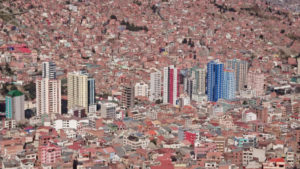 The pure blue sky of La Paz hides a secret spring-like climate behind its weather statistics. On paper, the temperature and rainfall averages look similar to the UK. In reality, the brighter sun, clearer skies and lower humidity provide a radiant heat easier to contain beneath clothing.
The pure blue sky of La Paz hides a secret spring-like climate behind its weather statistics. On paper, the temperature and rainfall averages look similar to the UK. In reality, the brighter sun, clearer skies and lower humidity provide a radiant heat easier to contain beneath clothing.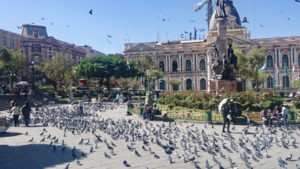 Plaza Murillo holds the seat of government and a bird feeding station. It’s thick with police, military guards and pigeons. The University staff with their shockingly loud fireworks for protesting for higher wages have intensified the police presence without doing anything about thinning out the pigeons. I have to find my way around this inconvenient obstruction. Mostly, the demos have been peaceful but the longer they continue, the more fractious they get.
Plaza Murillo holds the seat of government and a bird feeding station. It’s thick with police, military guards and pigeons. The University staff with their shockingly loud fireworks for protesting for higher wages have intensified the police presence without doing anything about thinning out the pigeons. I have to find my way around this inconvenient obstruction. Mostly, the demos have been peaceful but the longer they continue, the more fractious they get.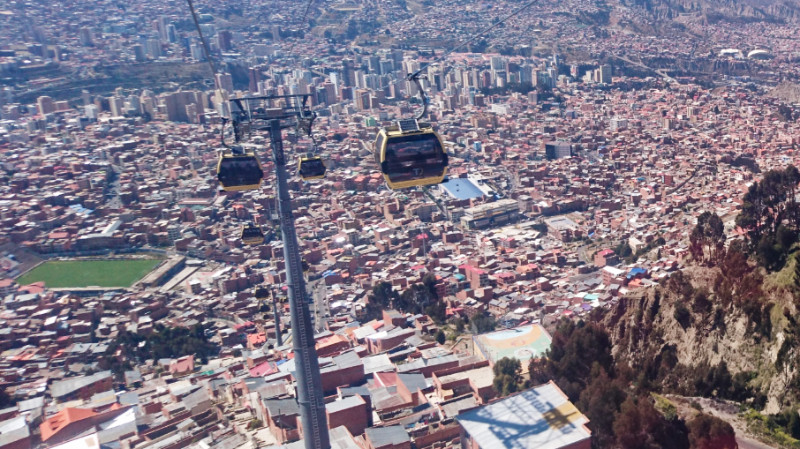 A real gem of La Paz is the ‘Mi Telferico’ Cable car system. There appears to be no practical map available for the system and how it all links together to be able to explore the city. By trial and error, I spend the day moving from one line to another until the whole system has been explored and I have an overview of how the city is covered.
A real gem of La Paz is the ‘Mi Telferico’ Cable car system. There appears to be no practical map available for the system and how it all links together to be able to explore the city. By trial and error, I spend the day moving from one line to another until the whole system has been explored and I have an overview of how the city is covered.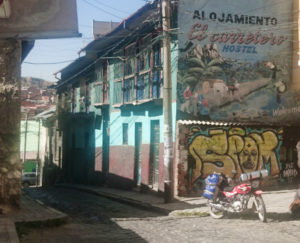 I loaded up the bike and squeezed its swollen bags through the Hostel doors onto the pale sunlit cobbles on the lane outside. Checking the map, it’s simply a right turn at the crossroads and straight on over the hill to route 3. The cobbled road was steep and the bike steadily rumbled its way upwards before reaching the smooth bleached concrete slopes that became so steep that the bike could no longer grunt its way another inch.
I loaded up the bike and squeezed its swollen bags through the Hostel doors onto the pale sunlit cobbles on the lane outside. Checking the map, it’s simply a right turn at the crossroads and straight on over the hill to route 3. The cobbled road was steep and the bike steadily rumbled its way upwards before reaching the smooth bleached concrete slopes that became so steep that the bike could no longer grunt its way another inch.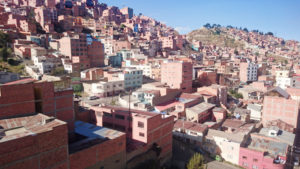 Turning the bike around and rolling downhill on brakes and low gear was easier but no less dangerous. The white concrete was smooth and with barely enough grip. Stopping would be a challenge and my prayers for no traffic were answered, at least until the cobbles where the slope eased off to manageable levels,
Turning the bike around and rolling downhill on brakes and low gear was easier but no less dangerous. The white concrete was smooth and with barely enough grip. Stopping would be a challenge and my prayers for no traffic were answered, at least until the cobbles where the slope eased off to manageable levels,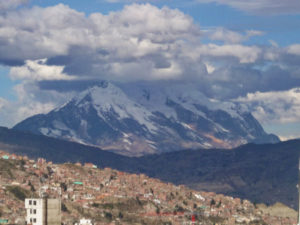 At the city limits, there was me, a coach and two heavy trucks belching black smoke against the force of gravity; all making our way out of La Paz’s bowl in the sky, from 3700 metres uphill toward La Cumbre Pass at 4600 metres. There was little power available for overtaking and a maximum speed of 40km/h but I took advantage of the unnecessary outward bound speed humps and potholes to maintain my speed by standing on the footpegs to roll over the obstacles and get ahead to breathe diesel free mountain air, while the trucks were forced to slow for the speed humps.
At the city limits, there was me, a coach and two heavy trucks belching black smoke against the force of gravity; all making our way out of La Paz’s bowl in the sky, from 3700 metres uphill toward La Cumbre Pass at 4600 metres. There was little power available for overtaking and a maximum speed of 40km/h but I took advantage of the unnecessary outward bound speed humps and potholes to maintain my speed by standing on the footpegs to roll over the obstacles and get ahead to breathe diesel free mountain air, while the trucks were forced to slow for the speed humps.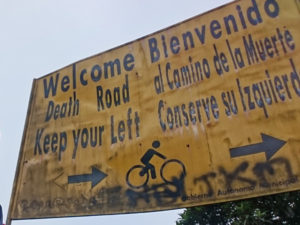 Less than two miles in the grey foggy mist. There it was, the entrance to the Death Road. Heralded by a tired and solemn-looking information board and a sign instructing traffic to now pass on the left so the drivers are able to see how soon their wheels will be going over the edge.
Less than two miles in the grey foggy mist. There it was, the entrance to the Death Road. Heralded by a tired and solemn-looking information board and a sign instructing traffic to now pass on the left so the drivers are able to see how soon their wheels will be going over the edge.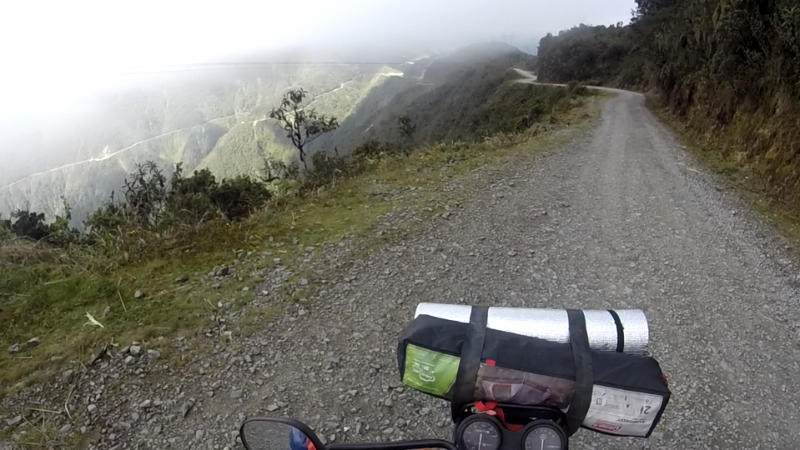
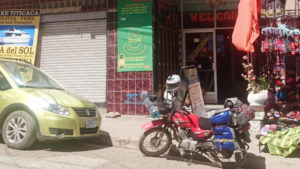 The bike started on the first blip of the starter button after 5 days of inactivity and I walked it over the steps under engine power into the street before loading up the bags. One more visit to El Condor and the Eagle Cafe to pass away the morning and I was off to Huatajata on the way to La Paz via the picturesque peninsular track toward Isla Del Sol.
The bike started on the first blip of the starter button after 5 days of inactivity and I walked it over the steps under engine power into the street before loading up the bags. One more visit to El Condor and the Eagle Cafe to pass away the morning and I was off to Huatajata on the way to La Paz via the picturesque peninsular track toward Isla Del Sol. As usual, the track was rough to the point of requiring a flagpole to mark a particularly deep pothole. The afternoon, bright, dry and warm with dust hanging in the air stirred up by the balding tyres of long passed taxis.
As usual, the track was rough to the point of requiring a flagpole to mark a particularly deep pothole. The afternoon, bright, dry and warm with dust hanging in the air stirred up by the balding tyres of long passed taxis.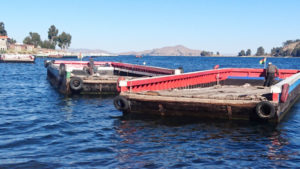 Tiquina saw fleets of rectangular wooden ferries. Square bow, powered by outboards. Perfectly aligned with the height of the ramps, I follow a taxi and a camper van without having to wait. Three empty ferries patiently drift awaiting the ramp with no traffic behind me. I put the side stand down but stay on the bike to brace against the swell on the lake, as small as it was. Facing the stern I watched
Tiquina saw fleets of rectangular wooden ferries. Square bow, powered by outboards. Perfectly aligned with the height of the ramps, I follow a taxi and a camper van without having to wait. Three empty ferries patiently drift awaiting the ramp with no traffic behind me. I put the side stand down but stay on the bike to brace against the swell on the lake, as small as it was. Facing the stern I watched 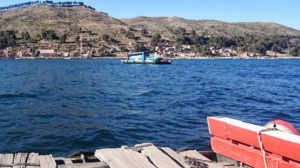 the ferry flexing with the waves. The strait is narrow, probably half a mile at the most but it took a while, the poor outboards pushing the square bow wave across the channel.
the ferry flexing with the waves. The strait is narrow, probably half a mile at the most but it took a while, the poor outboards pushing the square bow wave across the channel.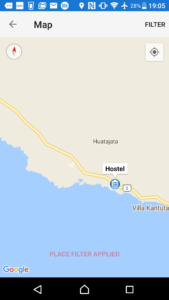 Missing the narrow gravel junction to the tiny plaza of Huatajata, I turned back after about half a mile past and found nowhere, not even a campsite. Not only did the plaza appear deserted, it appeared abandoned.
Missing the narrow gravel junction to the tiny plaza of Huatajata, I turned back after about half a mile past and found nowhere, not even a campsite. Not only did the plaza appear deserted, it appeared abandoned.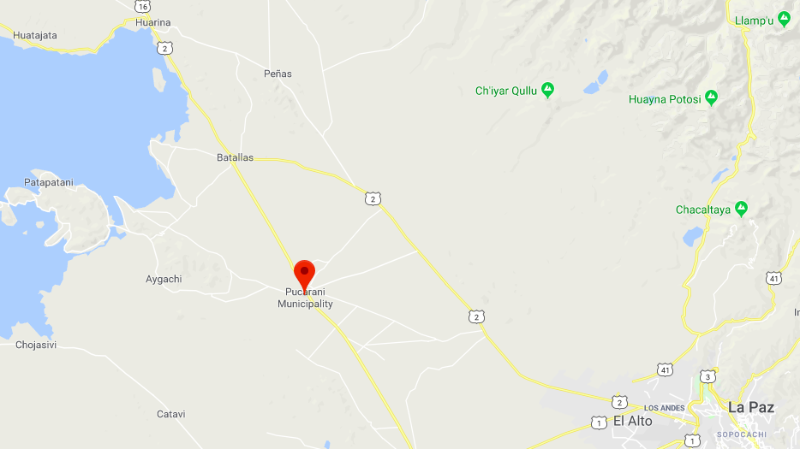 The straight bright yellow line on the map between Batillas and Pucarani promised a fast smooth ride but delivered white rock and dust with long straight furrows ploughed by car tyres for thirteen kilometres. No grip and loose uneven surface in fading light made for a treacherous journey. At my top speed of twenty to thirty kph, it would be dark before I arrived. Farms and at fields,fl some waterlogged lined the rail straight trail all the way along. I was noting plan ‘Bs’ all the way. A walled cemetery here some grassland at the side of a bridge there.
The straight bright yellow line on the map between Batillas and Pucarani promised a fast smooth ride but delivered white rock and dust with long straight furrows ploughed by car tyres for thirteen kilometres. No grip and loose uneven surface in fading light made for a treacherous journey. At my top speed of twenty to thirty kph, it would be dark before I arrived. Farms and at fields,fl some waterlogged lined the rail straight trail all the way along. I was noting plan ‘Bs’ all the way. A walled cemetery here some grassland at the side of a bridge there.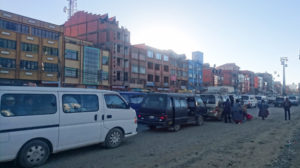 A half-hour later, I was in El Alto. Low sun but now full-beam daylight. Traffic was building and becoming ever more competitive for the diminishing road space. This is what I wanted to avoid by planning to stop in Huatajata, arriving in LaPaz in peak traffic.
A half-hour later, I was in El Alto. Low sun but now full-beam daylight. Traffic was building and becoming ever more competitive for the diminishing road space. This is what I wanted to avoid by planning to stop in Huatajata, arriving in LaPaz in peak traffic.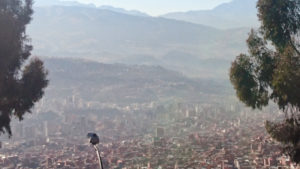 The junction to F1 toward La Paz remained undiscovered as I found myself diverted into the Centre of El Alto by traffic flow and one-way signs.I was thrilled, once I had discovered myself actually on the F1 but in the wrong direction. Hanging a U-turn at some traffic lights I was riding into the Sun toward the giant loop that descends the crater that is La Paz.
The junction to F1 toward La Paz remained undiscovered as I found myself diverted into the Centre of El Alto by traffic flow and one-way signs.I was thrilled, once I had discovered myself actually on the F1 but in the wrong direction. Hanging a U-turn at some traffic lights I was riding into the Sun toward the giant loop that descends the crater that is La Paz.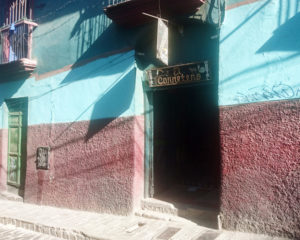 The next mission: to find an affordable hostel that can accommodate a bike. I’d read a few reviews on iOverlander and by chance found myself close to the Carretero, all be it thirty metres the wrong way down a busy one-way street. I parked up and walked to it and found it perfect for my needs. I wasn’t risking losing myself around the one-way system so the next gap in the traffic I rode down the street and powered the bike over the tall step and with a helping push into the lobby.
The next mission: to find an affordable hostel that can accommodate a bike. I’d read a few reviews on iOverlander and by chance found myself close to the Carretero, all be it thirty metres the wrong way down a busy one-way street. I parked up and walked to it and found it perfect for my needs. I wasn’t risking losing myself around the one-way system so the next gap in the traffic I rode down the street and powered the bike over the tall step and with a helping push into the lobby. Now I was here, I could unwind and look back at the journey from a warm and comfortable perspective. I hadn’t been happy about leaving at six but the side benefit was now it was only ten. I had the whole day to explore La Paz and stepped out into streets now bathed in strong, warm sunshine.
Now I was here, I could unwind and look back at the journey from a warm and comfortable perspective. I hadn’t been happy about leaving at six but the side benefit was now it was only ten. I had the whole day to explore La Paz and stepped out into streets now bathed in strong, warm sunshine.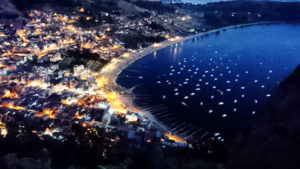 3AM, Cold enough to wake the Zombie White-walkers of Game of Thrones. The fleece blankets had slipped off the Teflon-slick polyester sleeping bag and needed constant readjustment to maximise heat retention.
3AM, Cold enough to wake the Zombie White-walkers of Game of Thrones. The fleece blankets had slipped off the Teflon-slick polyester sleeping bag and needed constant readjustment to maximise heat retention.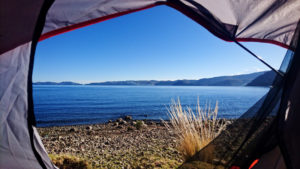 I awoke before sunrise, cheered to see the shadow of Senor Yamaha’s front wheel and mudguard cast on the tent wall. If not yet warm, I could feel the morning chill receding. I nestled down for an extra hour or two’s bone-warming sleep.
I awoke before sunrise, cheered to see the shadow of Senor Yamaha’s front wheel and mudguard cast on the tent wall. If not yet warm, I could feel the morning chill receding. I nestled down for an extra hour or two’s bone-warming sleep.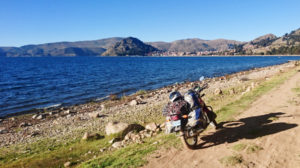 This time of year, the night temperature drops to between 2 and -2C. Back in the UK, Everything would be dripping with condensation. Not here, I couldn’t even see the mist of my breath. Everything felt as dry as it had been in the daytime. I squatted at the waterside with my toothbrush, unsteady over cricket ball sized pebbles and football sized boulders. The water was like liquid glass, completely clear, sparkling in the bright Andean sun. It tasted like spring water as I washed and cleaned my teeth on the sunlit beach. I expected the water to be icy cold but it was about the same as the sea in the UK but of course without the salt. Plastic bottles and litter lined the shore, as bad as anywhere I’ve seen here, even along the roadsides. I picked a few bits up, maintaining my policy of leaving a place better than I found it but it made little visual impact.
This time of year, the night temperature drops to between 2 and -2C. Back in the UK, Everything would be dripping with condensation. Not here, I couldn’t even see the mist of my breath. Everything felt as dry as it had been in the daytime. I squatted at the waterside with my toothbrush, unsteady over cricket ball sized pebbles and football sized boulders. The water was like liquid glass, completely clear, sparkling in the bright Andean sun. It tasted like spring water as I washed and cleaned my teeth on the sunlit beach. I expected the water to be icy cold but it was about the same as the sea in the UK but of course without the salt. Plastic bottles and litter lined the shore, as bad as anywhere I’ve seen here, even along the roadsides. I picked a few bits up, maintaining my policy of leaving a place better than I found it but it made little visual impact.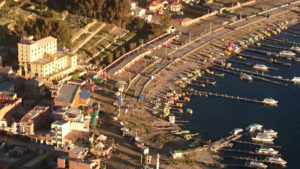 I rolled into Hostel Gabriel at Avenue 6 de Agosto. Saloman speaks as much English as I speak Spanish and between us we communicate quite well. He gives my bike a helping push up the high kerb and the bike idles into the lobby. The tarrif is 30BOB (£3.36) a night, for a shared room or 40Bop for a private. My shared room up on the first floor has two beds and there is no sign of anyone else here. For my 5 night stay, I have the ‘shared’ room to myself.
I rolled into Hostel Gabriel at Avenue 6 de Agosto. Saloman speaks as much English as I speak Spanish and between us we communicate quite well. He gives my bike a helping push up the high kerb and the bike idles into the lobby. The tarrif is 30BOB (£3.36) a night, for a shared room or 40Bop for a private. My shared room up on the first floor has two beds and there is no sign of anyone else here. For my 5 night stay, I have the ‘shared’ room to myself.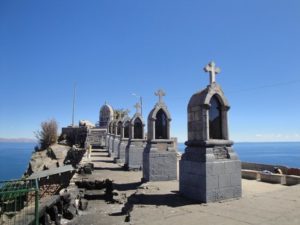 Out front and squinting up at the peak of Cerro Calvario, the crosses of the monuments give the impression of a cemetery: boot hill would be my nickname for it. The short but steep climb takes probably twenty minutes to half an hour up irregular stone steps. The altitude challenges the lungs. The intention is to take some pictures of the sunset over the lake but ignorance of the fact that Bolivia’s time zone is an hour ahead of Peru puts me an hour too early and a leisurely hour and a half is spent at the summit in meditation and contemplation while the sun slowly drags its warmth and light below the horizon.
Out front and squinting up at the peak of Cerro Calvario, the crosses of the monuments give the impression of a cemetery: boot hill would be my nickname for it. The short but steep climb takes probably twenty minutes to half an hour up irregular stone steps. The altitude challenges the lungs. The intention is to take some pictures of the sunset over the lake but ignorance of the fact that Bolivia’s time zone is an hour ahead of Peru puts me an hour too early and a leisurely hour and a half is spent at the summit in meditation and contemplation while the sun slowly drags its warmth and light below the horizon.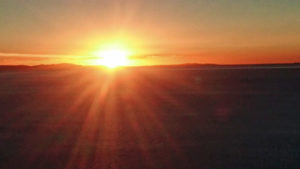 Down the Avenue toward the lake on the left is a cafe called El Condor and the Eagle. A fascinating Irish cafe run By Don, from Ireland and his Bolivian wife. He makes his own bread which makes for an irresistible breakfast sandwich. Don is full of local information and gives me tips on local bureaucracy, residency, La Paz as well as Isla Del Sol. There is a stack of handwritten notebooks where customers are invited to share their wisdom, experiences, favourite books, poems and song lyrics. It becomes the ideal office for planning the day…
Down the Avenue toward the lake on the left is a cafe called El Condor and the Eagle. A fascinating Irish cafe run By Don, from Ireland and his Bolivian wife. He makes his own bread which makes for an irresistible breakfast sandwich. Don is full of local information and gives me tips on local bureaucracy, residency, La Paz as well as Isla Del Sol. There is a stack of handwritten notebooks where customers are invited to share their wisdom, experiences, favourite books, poems and song lyrics. It becomes the ideal office for planning the day…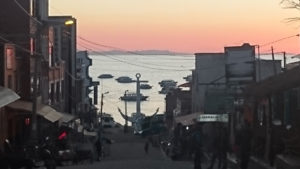 Closing the door behind me entering El Condor and the Eagle, I assume I’m the first customer of the day since they open at 7 and it’s still well before 8. Don, explains a bit about the blockade at the northern part of the island. Which was a blow, as I had planned to land at the north port and hike the ridge path to the south. Not currently possible. Something to do with the inland community not getting a share of the tourist profits. Even so, at the ticket booth at Copacabana harbour, I ask for a ticket to the north. The vendor says nothing and ticks the south box on my ticket and I wander along the wooden jetty to join the queue for the boat.
Closing the door behind me entering El Condor and the Eagle, I assume I’m the first customer of the day since they open at 7 and it’s still well before 8. Don, explains a bit about the blockade at the northern part of the island. Which was a blow, as I had planned to land at the north port and hike the ridge path to the south. Not currently possible. Something to do with the inland community not getting a share of the tourist profits. Even so, at the ticket booth at Copacabana harbour, I ask for a ticket to the north. The vendor says nothing and ticks the south box on my ticket and I wander along the wooden jetty to join the queue for the boat.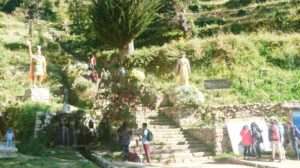 The Isla Del Sol port of Yumani is an area about one hundred metres wide by thirty metres deep between water and Inca Wall. To the right are the Inca steps which lead up to Yumani Pueblo nearly two hundred metres above the lake. I hoick my backpack containing only water bottle and jacket onto one shoulder and stride to the steps. Some young German girls were laden with full touring kit, were occupying the full width of the path bent forward step by slow step and I quickly skipped around them on the steps, as they gasped for scarce oxygen with the effort, and I steadily climbed into the village.
The Isla Del Sol port of Yumani is an area about one hundred metres wide by thirty metres deep between water and Inca Wall. To the right are the Inca steps which lead up to Yumani Pueblo nearly two hundred metres above the lake. I hoick my backpack containing only water bottle and jacket onto one shoulder and stride to the steps. Some young German girls were laden with full touring kit, were occupying the full width of the path bent forward step by slow step and I quickly skipped around them on the steps, as they gasped for scarce oxygen with the effort, and I steadily climbed into the village. Max was Portuguese but sounded Italian. He was fifty four but looked a lot younger and we shared similar philosophies for life and travel: mainly a preference for solitude but in this case an exception in sharing these stunning views over the lake and distant mountains. It made for a pleasant change.
Max was Portuguese but sounded Italian. He was fifty four but looked a lot younger and we shared similar philosophies for life and travel: mainly a preference for solitude but in this case an exception in sharing these stunning views over the lake and distant mountains. It made for a pleasant change.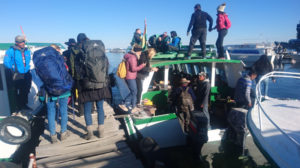 For the return cruise, I nabbed a seat on the roof. High altitude, full sun reflected by the lake, people were breaking out the sunscreen. I just pull my hat down further and covered up with long sleeves. It turns out I’m in a group of four Brits and an Aussie. An hour and a half break from struggling with the
For the return cruise, I nabbed a seat on the roof. High altitude, full sun reflected by the lake, people were breaking out the sunscreen. I just pull my hat down further and covered up with long sleeves. It turns out I’m in a group of four Brits and an Aussie. An hour and a half break from struggling with the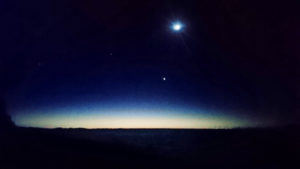 I had based my original estimate of 400Km a day on smooth roads and big bikes that could sit happily at 120 km/h and even 180km/h, not that you would like to hit one of the unmarked speed humps here at that speed.
I had based my original estimate of 400Km a day on smooth roads and big bikes that could sit happily at 120 km/h and even 180km/h, not that you would like to hit one of the unmarked speed humps here at that speed.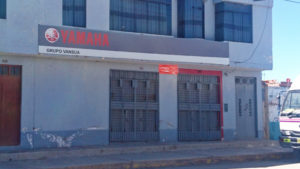 getting to my knees and fingers. Ilave rang a bell. I had prepared my documents earlier ready for the border ceremony, into Bolivia, and checked the insurance details. La Positiva, There was a La Positiva across the road at the Yamaha shop which was closed. Well, well, if it wasn’t the exact same place as the address on the document. I still had three weeks to run on it so not worth hanging around for, besides it appears it can be done online decoding the Spanish notes.
getting to my knees and fingers. Ilave rang a bell. I had prepared my documents earlier ready for the border ceremony, into Bolivia, and checked the insurance details. La Positiva, There was a La Positiva across the road at the Yamaha shop which was closed. Well, well, if it wasn’t the exact same place as the address on the document. I still had three weeks to run on it so not worth hanging around for, besides it appears it can be done online decoding the Spanish notes.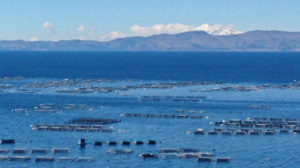 The farms weren’t solely confined to the land. Cresting a rise on a bend, Lake Titicaca once again presented its full fresh water blueness in the early afternoon sun, supporting floating frames far along the shoreline with fish farmers in their boats tending to their trout cages. I pulled over in a layby for a while, sitting my cold carcass on the ground leaning back on a rock absorbing the sun’s rays.
The farms weren’t solely confined to the land. Cresting a rise on a bend, Lake Titicaca once again presented its full fresh water blueness in the early afternoon sun, supporting floating frames far along the shoreline with fish farmers in their boats tending to their trout cages. I pulled over in a layby for a while, sitting my cold carcass on the ground leaning back on a rock absorbing the sun’s rays.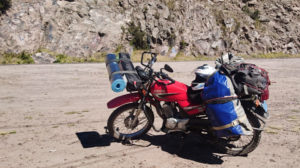 When my blood temperature rose above reptilian levels, I set off to Copacabana. It was only 45Km away so I would be there early afternoon. Time enough to get across the border and find a reasonable hostel. It was too cold to camp.
When my blood temperature rose above reptilian levels, I set off to Copacabana. It was only 45Km away so I would be there early afternoon. Time enough to get across the border and find a reasonable hostel. It was too cold to camp.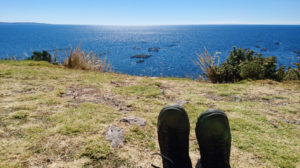 Today’s ride was decorated by the proximity of the lake under a deep blue sky over a deeper blue water. The anonymous-looking unmarked junction east to Copacabana almost slipped by unconsciously, disguised by a shanty looking town. I only recognised it by the curved triangle that each lane made with the main route. Checking the sat nav I doubled back the twenty metres plus braking distance.
Today’s ride was decorated by the proximity of the lake under a deep blue sky over a deeper blue water. The anonymous-looking unmarked junction east to Copacabana almost slipped by unconsciously, disguised by a shanty looking town. I only recognised it by the curved triangle that each lane made with the main route. Checking the sat nav I doubled back the twenty metres plus braking distance.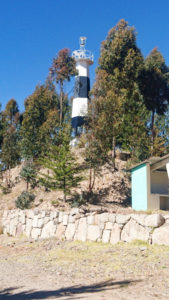 The border town of Kasani was a handful of Kilometres and I was at the border control by 2pm. Two offices required my visit to depart Peru, one for me and one for the Yamaha (Khamakha, they confusingly pronounce over here.)
The border town of Kasani was a handful of Kilometres and I was at the border control by 2pm. Two offices required my visit to depart Peru, one for me and one for the Yamaha (Khamakha, they confusingly pronounce over here.)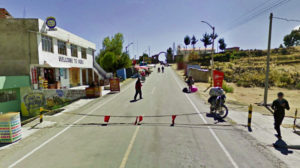 The border complex resembled an abandoned barracks with assorted militarised looking individuals meandering as if searching for significance in their lives. I viewed them as sharks in a pool. If I showed no fear they might not feel the need to justify their existence and attack.
The border complex resembled an abandoned barracks with assorted militarised looking individuals meandering as if searching for significance in their lives. I viewed them as sharks in a pool. If I showed no fear they might not feel the need to justify their existence and attack.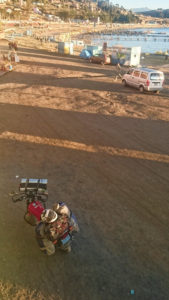 After dinner at Totara’s roof terrace watching the sun plummet toward the horizon, chased by the invisible chill of night, I delicately ride across the dust and boulders lining the shore back to where I hoped I remembered. Dogs leapt unseen out of the darkness under the trees, barking and chasing the bike almost knocking me over. One bit my leg and got a mouth full of shin protector before letting go and disappearing somewhere behind. Ignoring dogs is my only strategy for staying upright, so far it’s working.
After dinner at Totara’s roof terrace watching the sun plummet toward the horizon, chased by the invisible chill of night, I delicately ride across the dust and boulders lining the shore back to where I hoped I remembered. Dogs leapt unseen out of the darkness under the trees, barking and chasing the bike almost knocking me over. One bit my leg and got a mouth full of shin protector before letting go and disappearing somewhere behind. Ignoring dogs is my only strategy for staying upright, so far it’s working.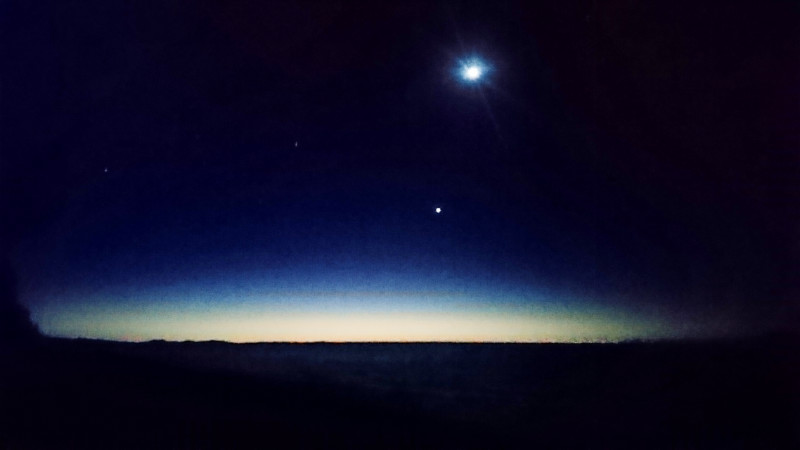
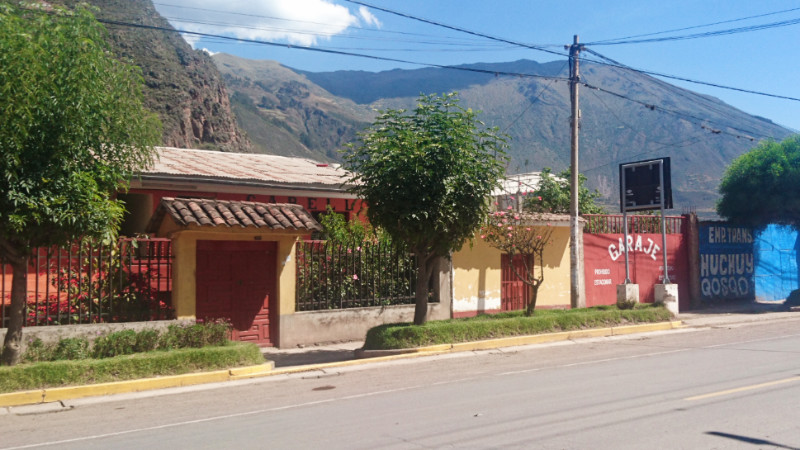 Three days later, I checked out of Hospedaje Cabell and rode into Plaza de Armas for a final omelette and latte at the cafe on the Plaza and hit route 28B down the Sacred Valley of the Incas through Pisac and down route PE3S toward Ayaviri, 268 km south-east closer to Bolivia and a thousand metres further away from sea level.
Three days later, I checked out of Hospedaje Cabell and rode into Plaza de Armas for a final omelette and latte at the cafe on the Plaza and hit route 28B down the Sacred Valley of the Incas through Pisac and down route PE3S toward Ayaviri, 268 km south-east closer to Bolivia and a thousand metres further away from sea level.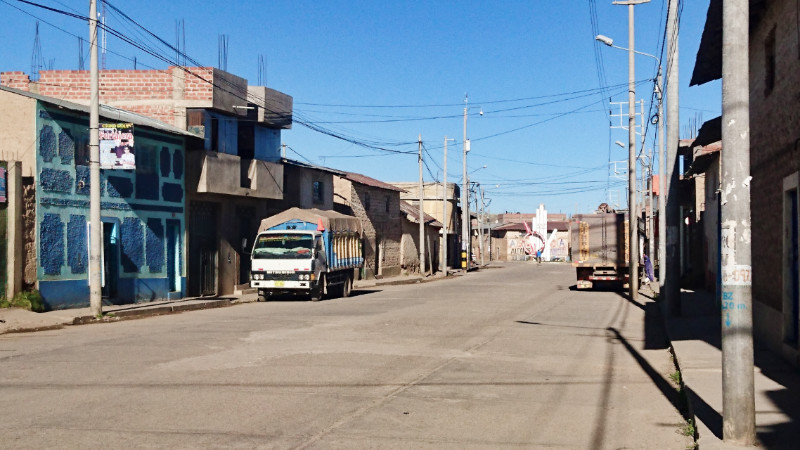 mountain passes around Ollantaytambo and became straighter the further south I went. The scenery changed from steep alpine rocky giants left and right creating a natural channel, to rolling wispy grass hills and wide open, flat plains. It didn’t seem like planet Earth at all. Arriving in Ayaviri felt like landing at a moonbase. I had an option of campsite here or hostels. The air felt so cold, even in this clear blue sky with the suns rays irradiating me, that I opted for the relative warmth of a building rather than nylon shelter.
mountain passes around Ollantaytambo and became straighter the further south I went. The scenery changed from steep alpine rocky giants left and right creating a natural channel, to rolling wispy grass hills and wide open, flat plains. It didn’t seem like planet Earth at all. Arriving in Ayaviri felt like landing at a moonbase. I had an option of campsite here or hostels. The air felt so cold, even in this clear blue sky with the suns rays irradiating me, that I opted for the relative warmth of a building rather than nylon shelter. Walking around the town and looking at the landscape, it wasn’t the moon I was on, it was Mars. No vegetation apart from thin grass lining the hills, dust stirred up by the three-wheeled motor rickshaws and a sky bluer than I’ve ever seen. It was noticeably harder to breathe simply walking about. Mars has a thin atmosphere too. The altitude here is just short of 4km above sea level. Staying in the sun to absorb the warmth through my jacket, I grabbed an early dinner at a Polleria and retreated to the hostel.
Walking around the town and looking at the landscape, it wasn’t the moon I was on, it was Mars. No vegetation apart from thin grass lining the hills, dust stirred up by the three-wheeled motor rickshaws and a sky bluer than I’ve ever seen. It was noticeably harder to breathe simply walking about. Mars has a thin atmosphere too. The altitude here is just short of 4km above sea level. Staying in the sun to absorb the warmth through my jacket, I grabbed an early dinner at a Polleria and retreated to the hostel.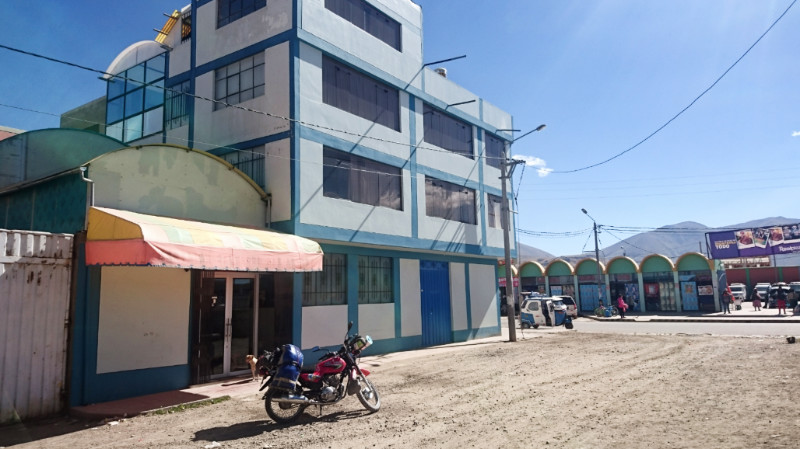 At half past six, the warming influence of the sun is subtracted from the day’s equation, I get ready for bed. My urine is dark amber, reminding me I need to drink more water if I am going to avoid a dehydration episode like I had in Bogota. I climb into bed still wearing my jacket with the hood up. There are three thick blankets and my feet soon warm up. My room is cold, as it’s on the side facing away from the afternoon sun. If I’m lucky, I’ll catch the early morning sun’s rays through the windows. I’m going to need some windshields for my hands on the bike and start wearing my rain gear for insulation. Tomorrow I’m bound for Puno, only 167km, or if it’s going well, Copacabana 284km plus a border crossing on the Bolivian shore of Lake Titicaca. We’ll See…
At half past six, the warming influence of the sun is subtracted from the day’s equation, I get ready for bed. My urine is dark amber, reminding me I need to drink more water if I am going to avoid a dehydration episode like I had in Bogota. I climb into bed still wearing my jacket with the hood up. There are three thick blankets and my feet soon warm up. My room is cold, as it’s on the side facing away from the afternoon sun. If I’m lucky, I’ll catch the early morning sun’s rays through the windows. I’m going to need some windshields for my hands on the bike and start wearing my rain gear for insulation. Tomorrow I’m bound for Puno, only 167km, or if it’s going well, Copacabana 284km plus a border crossing on the Bolivian shore of Lake Titicaca. We’ll See…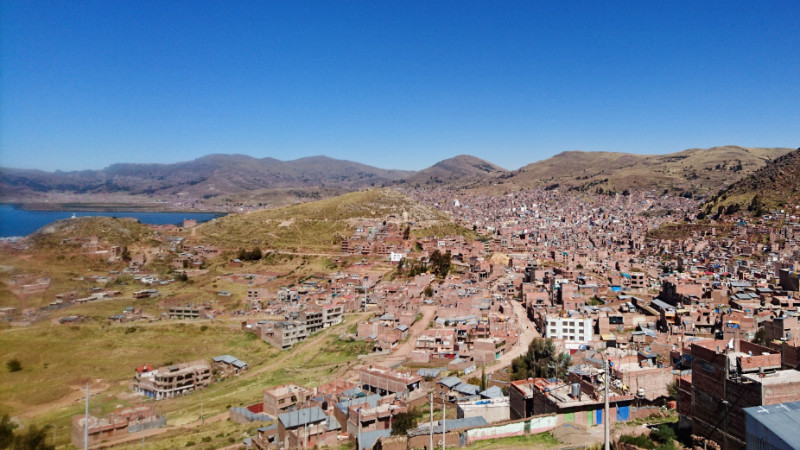 The roads began to curve and undulate and suddenly, Puno presented itself in its full mediocrity while rounding a bend over a rise and descending into the suburbs. The beauty of the place was wholly dependent on its proximity to the lake. Peru’s version of Skegness or Margate, with its fairgrounds and sparse, ramshackle attractions.
The roads began to curve and undulate and suddenly, Puno presented itself in its full mediocrity while rounding a bend over a rise and descending into the suburbs. The beauty of the place was wholly dependent on its proximity to the lake. Peru’s version of Skegness or Margate, with its fairgrounds and sparse, ramshackle attractions.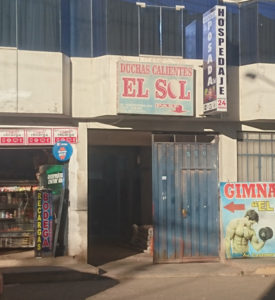 I cruised along the city’s coast and spotted a hostel sign among many I ignored. “WiFi y Aguas Calientes” Perfecto and, with permission, I rode into the courtyard reception and unloaded the bike. My room was upstairs. The WiFi only worked outside and I was in the shade which made it a short and chilly session. I tried the shower: cold dribble. The duchas calientes were not included in my ensuite, they were in a block downstairs past the building site that was pouring concrete into vertical wooden cases laced with steel rods, making columns. I skipped it, I wasn’t sweating in this climate. I’d keep…
I cruised along the city’s coast and spotted a hostel sign among many I ignored. “WiFi y Aguas Calientes” Perfecto and, with permission, I rode into the courtyard reception and unloaded the bike. My room was upstairs. The WiFi only worked outside and I was in the shade which made it a short and chilly session. I tried the shower: cold dribble. The duchas calientes were not included in my ensuite, they were in a block downstairs past the building site that was pouring concrete into vertical wooden cases laced with steel rods, making columns. I skipped it, I wasn’t sweating in this climate. I’d keep…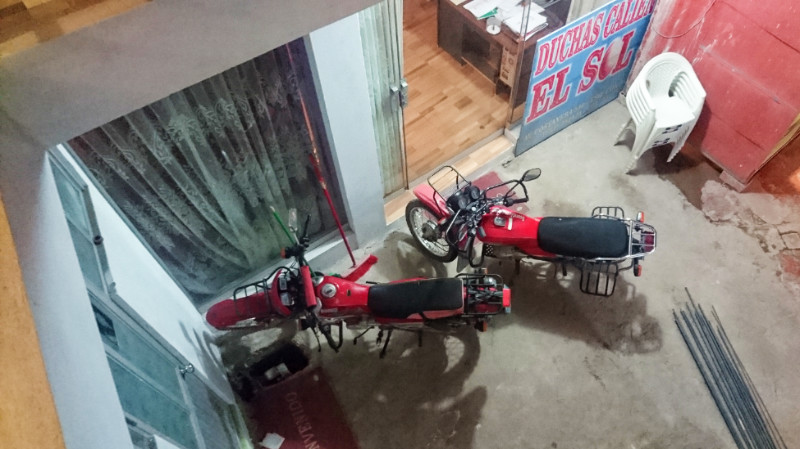 My room was room No 1 at the back, away from the road but next to a fairground that would spark up Gangnam Style and La Macarena as soon as the sun went down. Ah well, what else to expect from previous experience. The bed was warmer than the one in Ayaviri, with its 5 heavy woollen blankets and apparently uninhabited by creatures other than me. The double bed meant I had two pillows so was able to sit comfortably and type up some notes. The ambient temperature was warmer than last night too… and I began to get comfortable, which had been a warning
My room was room No 1 at the back, away from the road but next to a fairground that would spark up Gangnam Style and La Macarena as soon as the sun went down. Ah well, what else to expect from previous experience. The bed was warmer than the one in Ayaviri, with its 5 heavy woollen blankets and apparently uninhabited by creatures other than me. The double bed meant I had two pillows so was able to sit comfortably and type up some notes. The ambient temperature was warmer than last night too… and I began to get comfortable, which had been a warning 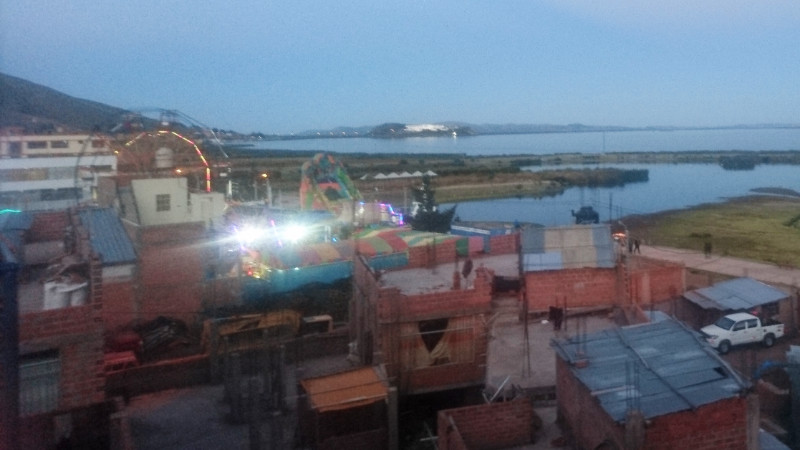 from mother Ayahuasca not to settle for, and I abandoned the temptation to stay one more night. Anyhow, Copacabana was only 145Km away. It doesn’t sound much but the bike is slow. Even on a loaded YB125 that does a maximum of 80km/h on a level road and an average of 50km/h, it means sitting 3 hours in cold wind.
from mother Ayahuasca not to settle for, and I abandoned the temptation to stay one more night. Anyhow, Copacabana was only 145Km away. It doesn’t sound much but the bike is slow. Even on a loaded YB125 that does a maximum of 80km/h on a level road and an average of 50km/h, it means sitting 3 hours in cold wind.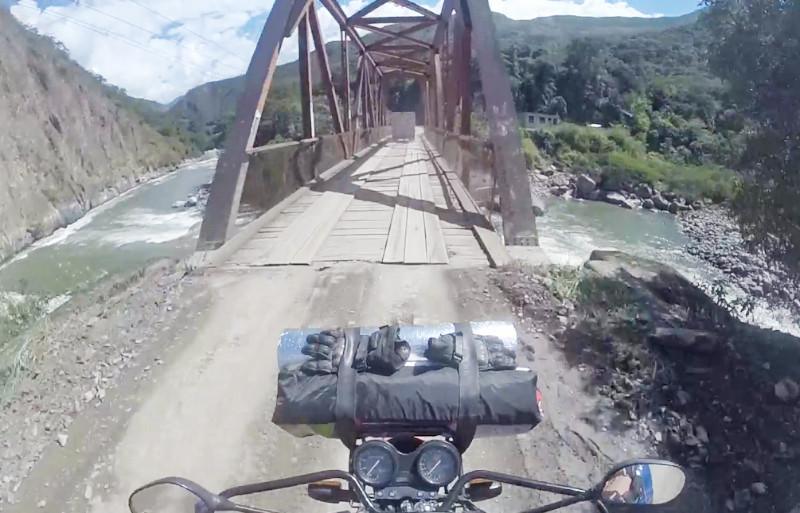 Saturday 12th May, The Aussie chatter in the morning woke me early before the sun had a chance to warm the tent. I doze and wait for the sun to smile on me.
Saturday 12th May, The Aussie chatter in the morning woke me early before the sun had a chance to warm the tent. I doze and wait for the sun to smile on me. This time I drive straight through Santa Maria and continue toward Ollantaytambo. Abra Malaga wasn’t quite as wet and cloudy at the peak but it was bloody cold. The road was drier too and I felt more confident leaning around the 61 hairpin bends without fear of sliding under the barrier and down a couple of thousand feet of vertical rock.
This time I drive straight through Santa Maria and continue toward Ollantaytambo. Abra Malaga wasn’t quite as wet and cloudy at the peak but it was bloody cold. The road was drier too and I felt more confident leaning around the 61 hairpin bends without fear of sliding under the barrier and down a couple of thousand feet of vertical rock. I checked the maps.me app. Arin. That’s where one of the people lived I was planning to hook up with. A friend of a friend. I rattled my fillings over Ollantaytambo’s coarse cobbled roads and out onto the asphalt to the east toward Arin and Pisac.
I checked the maps.me app. Arin. That’s where one of the people lived I was planning to hook up with. A friend of a friend. I rattled my fillings over Ollantaytambo’s coarse cobbled roads and out onto the asphalt to the east toward Arin and Pisac.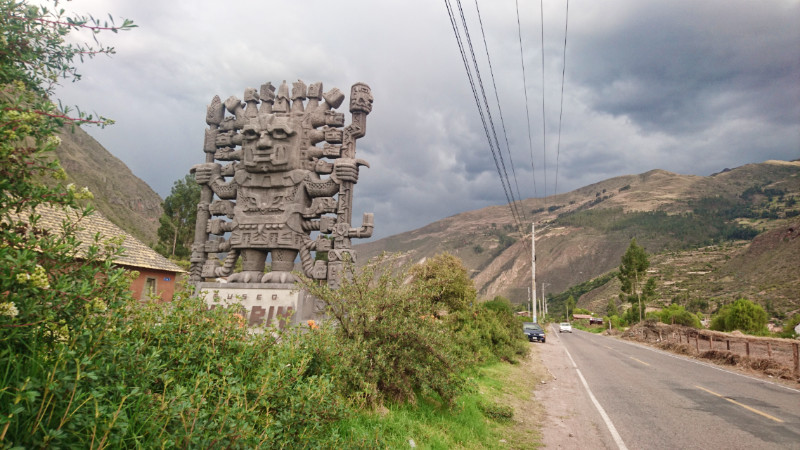 I rolled into Arin just before 4pm and I was hungry. Stopping at a cafe, I looked for accommodation on the apps on the phone. Campo Verde Pitusiray was just down the road just before the Inkariy Museum. I’d stay there. I finished my coffee and got back on the bike.
I rolled into Arin just before 4pm and I was hungry. Stopping at a cafe, I looked for accommodation on the apps on the phone. Campo Verde Pitusiray was just down the road just before the Inkariy Museum. I’d stay there. I finished my coffee and got back on the bike.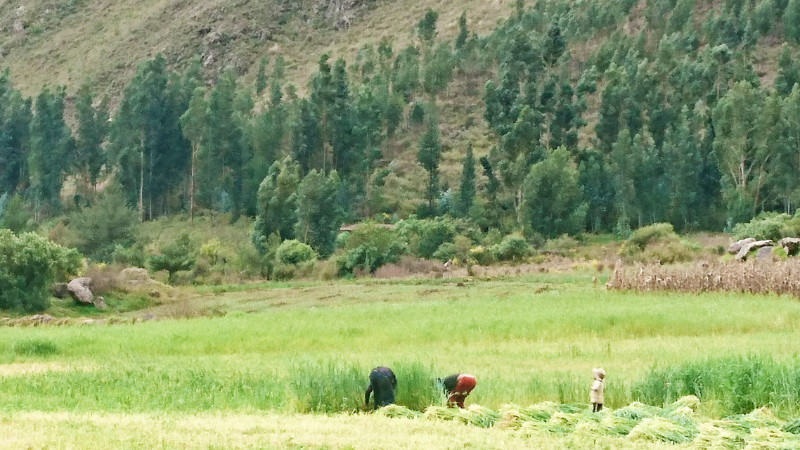 Pulling into Campo Verde, it didn’t look like a campsite. I rode up the grass lane to the farmhouse, the family were out with their harvest of Maize spread out on tarps in the field looking at me quizzically. The youngest woman approached and I showed here the camping emblem asking if this was ‘aqui’? She pointed at the peak of Pitusiray and said no motioning over the peak. Apologising, I got back on the bike and started to leave but hesitated after glancing at the gathering clouds. Rain was on its way. Grey streaks painting the sky between the peaks sandwiching the valley. The direction I was riding.
Pulling into Campo Verde, it didn’t look like a campsite. I rode up the grass lane to the farmhouse, the family were out with their harvest of Maize spread out on tarps in the field looking at me quizzically. The youngest woman approached and I showed here the camping emblem asking if this was ‘aqui’? She pointed at the peak of Pitusiray and said no motioning over the peak. Apologising, I got back on the bike and started to leave but hesitated after glancing at the gathering clouds. Rain was on its way. Grey streaks painting the sky between the peaks sandwiching the valley. The direction I was riding.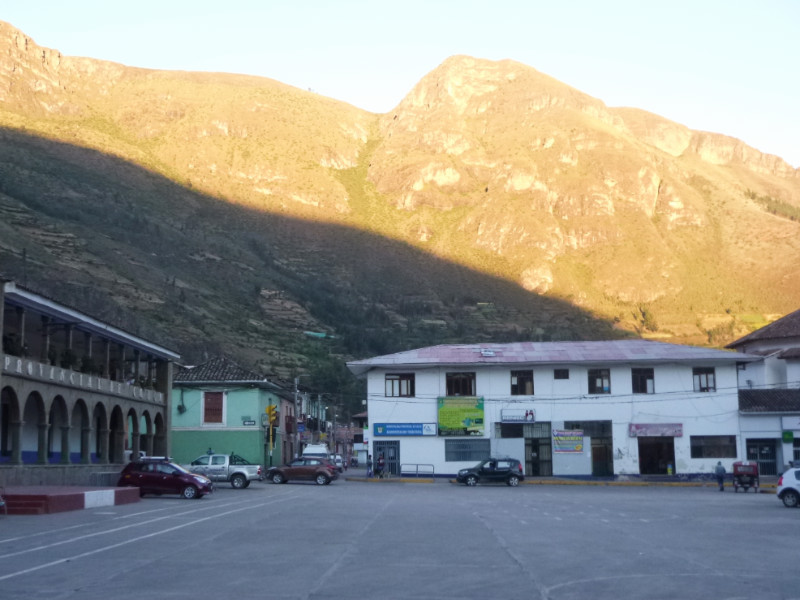 Sunday 13th May, I woke at dawn, cold even with the two fleece blankets over the sleeping bag. I buried my head to minimise heat loss and waited for the sun to warm the tent. I opened the flap of the door to help dry out the condensation. The family drove a few head of cattle by the tent toward their maize field, I waved and bid them buenas dias. When I emerged from the tent I could see the cattle had already set about eating the stalks and leaves left from the harvest. In a way, this seemed a backward way of life but at the same time, so much more holistic than what I knew back in the UK. No unemployment, fewer rules and regulations, the family happily working together, they had everything they needed, Self-sufficient, like.
Sunday 13th May, I woke at dawn, cold even with the two fleece blankets over the sleeping bag. I buried my head to minimise heat loss and waited for the sun to warm the tent. I opened the flap of the door to help dry out the condensation. The family drove a few head of cattle by the tent toward their maize field, I waved and bid them buenas dias. When I emerged from the tent I could see the cattle had already set about eating the stalks and leaves left from the harvest. In a way, this seemed a backward way of life but at the same time, so much more holistic than what I knew back in the UK. No unemployment, fewer rules and regulations, the family happily working together, they had everything they needed, Self-sufficient, like.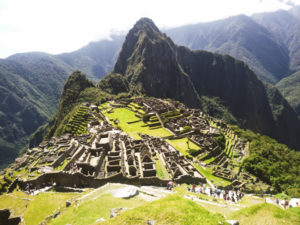 Thursday 10th May. Nobody warned me of the enormous queue at the bus station. The hundred metre line hadn’t moved for twenty minutes until a convoy of four buses arrived at the same time. A flurry of activity and we were soon tacking up the hairpin bends up the mountainside for the next half hour towards Machu Picchu. There was little information or apparent organisation at the gate. A long queue at the entrance was confusing the issue but when I asked one of the guides about Machu Picchu mountain, he pointed for me to edge around the crowd and I bypassed the queue into the site. He advised I should go to the toilet before the tour but also that I wouldn’t have time and I should hurry if I was going to make it at all. So “why mention it,?” I thought.
Thursday 10th May. Nobody warned me of the enormous queue at the bus station. The hundred metre line hadn’t moved for twenty minutes until a convoy of four buses arrived at the same time. A flurry of activity and we were soon tacking up the hairpin bends up the mountainside for the next half hour towards Machu Picchu. There was little information or apparent organisation at the gate. A long queue at the entrance was confusing the issue but when I asked one of the guides about Machu Picchu mountain, he pointed for me to edge around the crowd and I bypassed the queue into the site. He advised I should go to the toilet before the tour but also that I wouldn’t have time and I should hurry if I was going to make it at all. So “why mention it,?” I thought.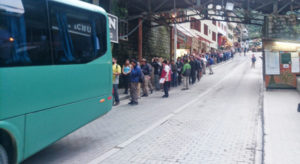 Asking the way a couple of times ensured I was hurrying my way up the right set of steps alongside the citadel and up to the checkpoint where I signed in at 7.45. With relief, I paused for a minute to recover from the climb and catch my breath. Up ahead were a couple and their guide about 20 meters up the steps. I caught them up and asked If I could tag along. Kalwant and his daughter, Laura, from Florida were finishing up their four day Inca Trail experience.
Asking the way a couple of times ensured I was hurrying my way up the right set of steps alongside the citadel and up to the checkpoint where I signed in at 7.45. With relief, I paused for a minute to recover from the climb and catch my breath. Up ahead were a couple and their guide about 20 meters up the steps. I caught them up and asked If I could tag along. Kalwant and his daughter, Laura, from Florida were finishing up their four day Inca Trail experience.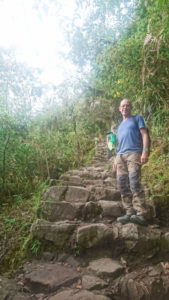 The Inca Trail is an exclusive selection of guided treks throughout the Sacred Valley of the Incas and has limited numbers, which creates a long waiting list. You can’t just turn up a and walk the trail. Kalwant and Laura had booked this trip seven months previous in October. Kalwant at seventy years old was a comparative gazelle moving up the mountain. It would be hard to allow myself to appear feeble in such company. Laura confessed they were training for months on fully inclined treadmills but were unable to simulate the thin atmosphere. Me? I trained for nothing. Adventure itself was my exercise.
The Inca Trail is an exclusive selection of guided treks throughout the Sacred Valley of the Incas and has limited numbers, which creates a long waiting list. You can’t just turn up a and walk the trail. Kalwant and Laura had booked this trip seven months previous in October. Kalwant at seventy years old was a comparative gazelle moving up the mountain. It would be hard to allow myself to appear feeble in such company. Laura confessed they were training for months on fully inclined treadmills but were unable to simulate the thin atmosphere. Me? I trained for nothing. Adventure itself was my exercise.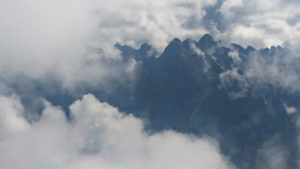 About halfway up, we began to catch glimpses of the citadel below through breaks in the cloud. The weather was perfect for the climb, the cloud shielding us from the heat of the sun. I frequently removed my hat to wipe the sweat from my forehead and allow the high mountain air to cool me in the shade. By the time we had reached the peak after the two hours climb, the morning sun had burned away the cloud, leaving us a perfect view.
About halfway up, we began to catch glimpses of the citadel below through breaks in the cloud. The weather was perfect for the climb, the cloud shielding us from the heat of the sun. I frequently removed my hat to wipe the sweat from my forehead and allow the high mountain air to cool me in the shade. By the time we had reached the peak after the two hours climb, the morning sun had burned away the cloud, leaving us a perfect view.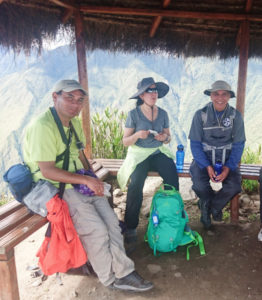 At the peak, there is a thatched shelter and wide viewing areas. There were already about 15 people up here in various stages of taking selfies and getting in the way of each other’s panoramic video sweeps. Kalwant gave me a bag of trail mix and we took photos of us all around the summit.
At the peak, there is a thatched shelter and wide viewing areas. There were already about 15 people up here in various stages of taking selfies and getting in the way of each other’s panoramic video sweeps. Kalwant gave me a bag of trail mix and we took photos of us all around the summit.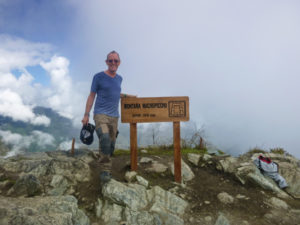 We signed out at 11.15. Three and a half hours after starting the climb. Machu Picchu Mountain is 650 meters higher than Machu Picchu Citadel, which itself is 400 metres above Aguas Calientes.
We signed out at 11.15. Three and a half hours after starting the climb. Machu Picchu Mountain is 650 meters higher than Machu Picchu Citadel, which itself is 400 metres above Aguas Calientes.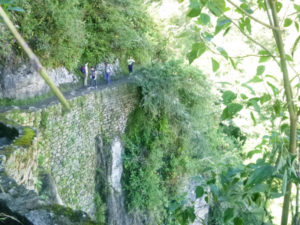 This short trek is not for the fearful of heights: a narrow path with sheer drops and no guard rail. It was a personal challenge which I could not let beat me. Seeing some people standing on the edge looking straight down turned my stomach. I passed those sections close to the rock face head turned away from the drop, trying to focus on other things.
This short trek is not for the fearful of heights: a narrow path with sheer drops and no guard rail. It was a personal challenge which I could not let beat me. Seeing some people standing on the edge looking straight down turned my stomach. I passed those sections close to the rock face head turned away from the drop, trying to focus on other things.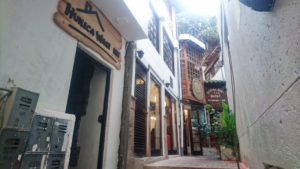 The shower in my room had a hot and cold tap but left me only a selection of cold left or cold right. There are hot springs on the edge of town from which the town gets its name Aguas Calientes (Hot Waters). I borrowed the hotel’s towel and marched up the hill to the thermal baths.
The shower in my room had a hot and cold tap but left me only a selection of cold left or cold right. There are hot springs on the edge of town from which the town gets its name Aguas Calientes (Hot Waters). I borrowed the hotel’s towel and marched up the hill to the thermal baths.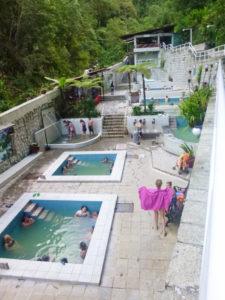 “Eases muscle aches and gets rid of toxins,” the sign says as I soak in the warm waters. “Where do these toxins go?” I wonder looking at the dozen people in this murky greenish water. The warm waters certainly ease muscle aches and pains and I felt refreshed heading back into town for dinner.
“Eases muscle aches and gets rid of toxins,” the sign says as I soak in the warm waters. “Where do these toxins go?” I wonder looking at the dozen people in this murky greenish water. The warm waters certainly ease muscle aches and pains and I felt refreshed heading back into town for dinner.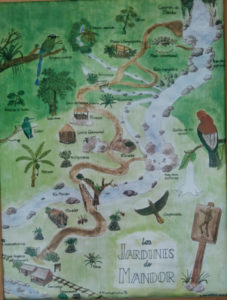 A couple of kilometres along the track is Jardines de Mandor. The name was written in my notebook from recommendations I picked up a while ago. I paid the entrance fee and left my bag in their storage room and meandered around their gardens. A small river of pure crystal mountain water runs through the Gardens into the Urubamba. The river Mandor, barely bigger than a brook with crystal clear water too good not to taste. Pure cool mountain water with a natural sweetness.
A couple of kilometres along the track is Jardines de Mandor. The name was written in my notebook from recommendations I picked up a while ago. I paid the entrance fee and left my bag in their storage room and meandered around their gardens. A small river of pure crystal mountain water runs through the Gardens into the Urubamba. The river Mandor, barely bigger than a brook with crystal clear water too good not to taste. Pure cool mountain water with a natural sweetness.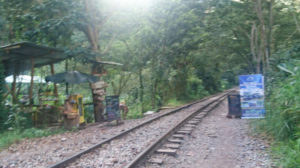 Collecting my backpack and crunching along the loose ballast along the track back towards Hydra Electrica, I was back at the Inti Watana restaurant within a couple of hours for rest, refreshment and another two nachos and blob of guacamole.
Collecting my backpack and crunching along the loose ballast along the track back towards Hydra Electrica, I was back at the Inti Watana restaurant within a couple of hours for rest, refreshment and another two nachos and blob of guacamole.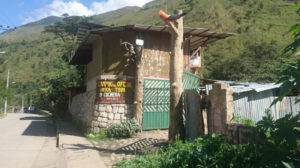 “Aqui, por favor!” the bus stops and I step out and cross the road into the Inka Tours campsite. The tents were out again and crowds of twenty-something Brits and Aussies were milling about. The WiFi was on but there was no internet connection. Not an environment I was keen on hanging around in.
“Aqui, por favor!” the bus stops and I step out and cross the road into the Inka Tours campsite. The tents were out again and crowds of twenty-something Brits and Aussies were milling about. The WiFi was on but there was no internet connection. Not an environment I was keen on hanging around in.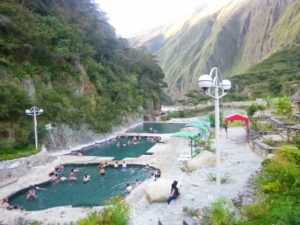 These springs were the same temperature as Aguas Calientes, around 36C, but were crystal clear, flowing from one pool to the other, finally overflowing into ornate showers where we could use soap and shampoo before the water drained into the river. This site was far bigger and more natural with a large cafe area where groups of hikers were chilling out. I stayed for a couple of hours. I hadn’t realised there was a campsite here. Much quieter than Inka Tours.
These springs were the same temperature as Aguas Calientes, around 36C, but were crystal clear, flowing from one pool to the other, finally overflowing into ornate showers where we could use soap and shampoo before the water drained into the river. This site was far bigger and more natural with a large cafe area where groups of hikers were chilling out. I stayed for a couple of hours. I hadn’t realised there was a campsite here. Much quieter than Inka Tours. Darkness had fallen by the time my wrinkled fingers dressed my cleansed and soothed body and then sipped a Pisco Sour listening to the blend of the sound of the river between the mountains and the murmur of conversations around the baths. Returning to a tent just here would have been the perfect finale to the day. I could have been tempted to relocate but I was off tomorrow anyway.
Darkness had fallen by the time my wrinkled fingers dressed my cleansed and soothed body and then sipped a Pisco Sour listening to the blend of the sound of the river between the mountains and the murmur of conversations around the baths. Returning to a tent just here would have been the perfect finale to the day. I could have been tempted to relocate but I was off tomorrow anyway.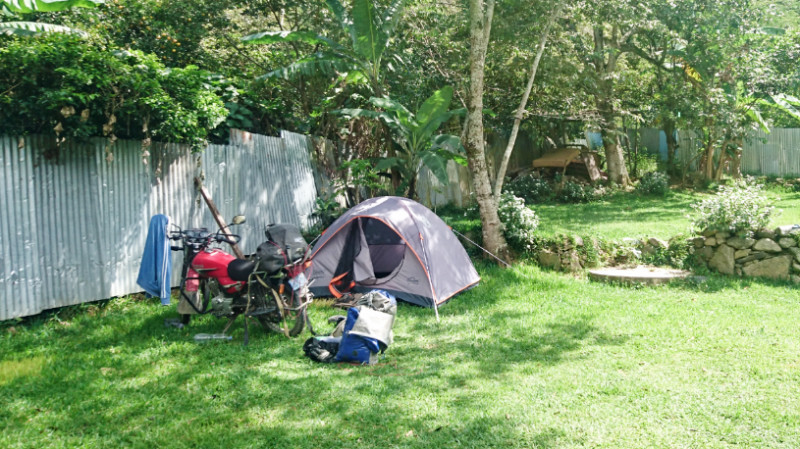 Wednesday, 9th of May, after a sleepless night, listening to the kindergarten crowd shouting along to Gangnam Style, La Macarena and various blaring popular banalities, I emerged when the sun began to warm my tent to find a deserted campsite with the staff packing away the tents. Presumably, the hikers were now nursing a hangover through the Sacred Valley, Gangnam Style.
Wednesday, 9th of May, after a sleepless night, listening to the kindergarten crowd shouting along to Gangnam Style, La Macarena and various blaring popular banalities, I emerged when the sun began to warm my tent to find a deserted campsite with the staff packing away the tents. Presumably, the hikers were now nursing a hangover through the Sacred Valley, Gangnam Style.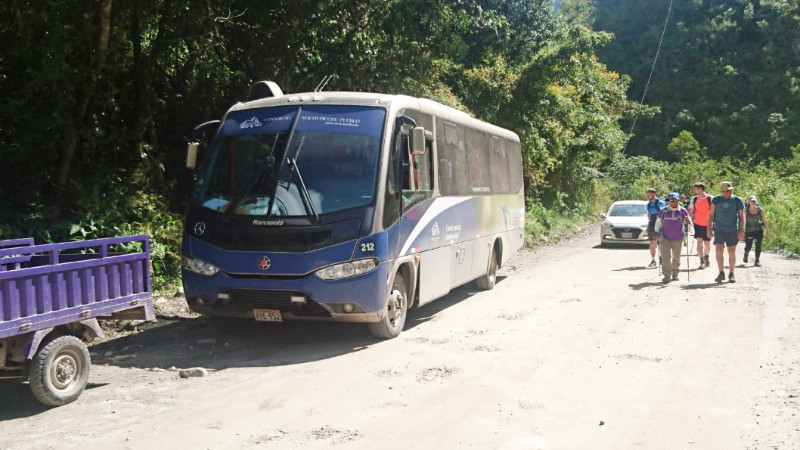 I packed the basics in the rucksack and stepped out of the campsite to follow the road that followed the river toward Machu Picchu. A car pulled up next to me and asked where I wanted to go. He wanted S/30, about £8. I declined the offer and the price dropped to S/20. No, I’ll walk. I crossed the river and the sun beat down on the pale shadeless track. After a kilometre, I rested under a solitary tree for a drink of water. Putting the bottle away, I noticed a bus coming round the corner. I watched it approach and stood up as it pulled up next to me. The driver asked “Hydro Electrica?” “Si, quanto es?” Six Soles! Result. I climbed aboard.
I packed the basics in the rucksack and stepped out of the campsite to follow the road that followed the river toward Machu Picchu. A car pulled up next to me and asked where I wanted to go. He wanted S/30, about £8. I declined the offer and the price dropped to S/20. No, I’ll walk. I crossed the river and the sun beat down on the pale shadeless track. After a kilometre, I rested under a solitary tree for a drink of water. Putting the bottle away, I noticed a bus coming round the corner. I watched it approach and stood up as it pulled up next to me. The driver asked “Hydro Electrica?” “Si, quanto es?” Six Soles! Result. I climbed aboard. Hydro Electrica was not what I expected: something like a mini Hoover dam in Nevada. It’s actually a car park at the end of a railway siding with a few buildings scattered along the valley and a railway siding lined by cafe and souvenir stalls. I could hear the horn of a train echoing around the mountains, followed five minutes later by the train itself.
Hydro Electrica was not what I expected: something like a mini Hoover dam in Nevada. It’s actually a car park at the end of a railway siding with a few buildings scattered along the valley and a railway siding lined by cafe and souvenir stalls. I could hear the horn of a train echoing around the mountains, followed five minutes later by the train itself.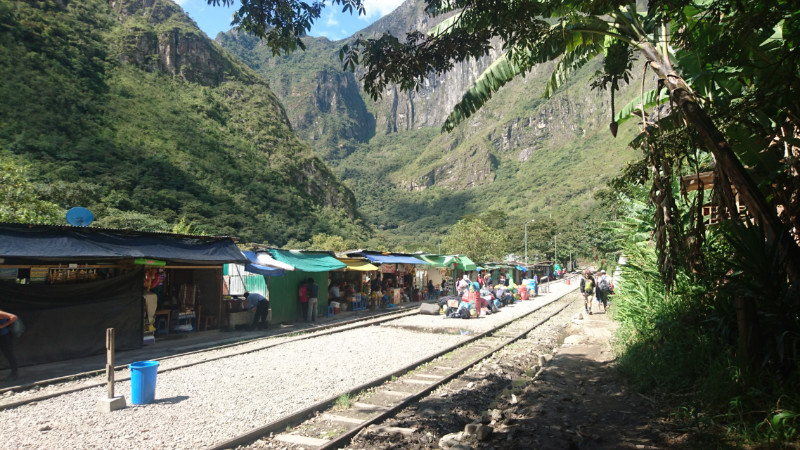 After watching the shunting and activity at this make-shift station, I headed down the track ignoring a sign next to a rail-side hostel that pointed out a pathway up through the woods to Machu Picchu. I thought it easier along the tracks and continued around the bend following a pair of Swedes until we came to a dead end. It looked as if there had been a landslide some years ago and it was left here abandoned on the tracks.
After watching the shunting and activity at this make-shift station, I headed down the track ignoring a sign next to a rail-side hostel that pointed out a pathway up through the woods to Machu Picchu. I thought it easier along the tracks and continued around the bend following a pair of Swedes until we came to a dead end. It looked as if there had been a landslide some years ago and it was left here abandoned on the tracks.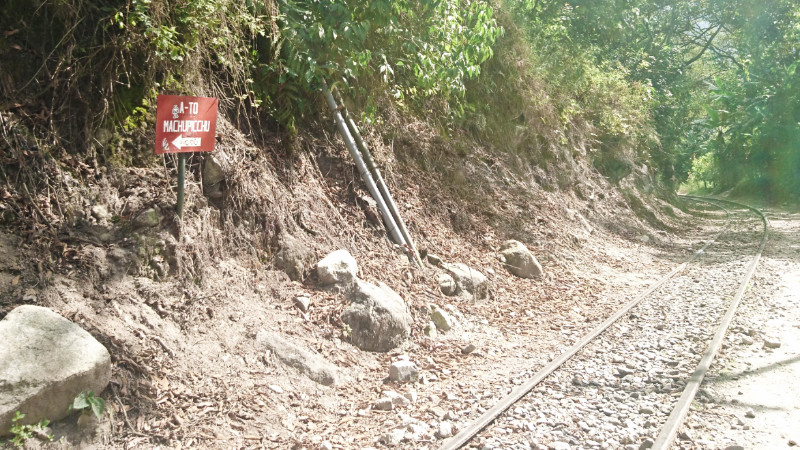 Backtracking the 200 metres or so to the footpath, the ascent through the trees emerged on the main line and I turned left to follow the sign to Machu Picchu. Passing another cafe, Inti Watana the menu caught my eye “Nachos con Guacamole” followed by soup and a main course. S/10 bargain. Not what I expected. Two nachos ‘con’ (being the operative word) guacamole… Still, there was plenty of soup and a decent main course.
Backtracking the 200 metres or so to the footpath, the ascent through the trees emerged on the main line and I turned left to follow the sign to Machu Picchu. Passing another cafe, Inti Watana the menu caught my eye “Nachos con Guacamole” followed by soup and a main course. S/10 bargain. Not what I expected. Two nachos ‘con’ (being the operative word) guacamole… Still, there was plenty of soup and a decent main course.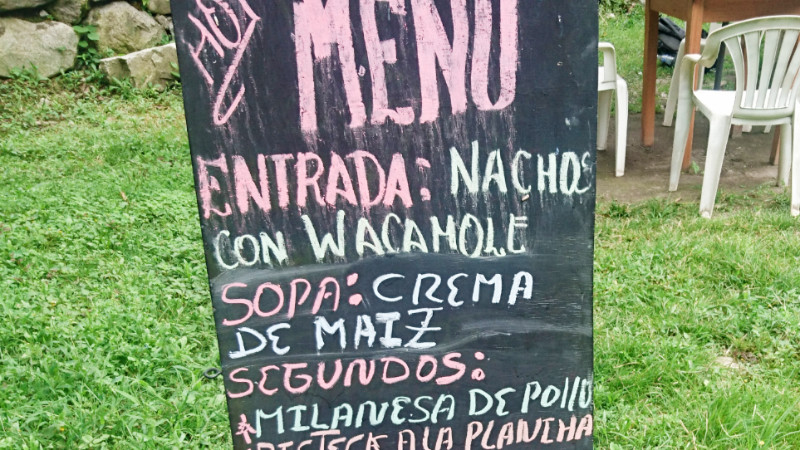
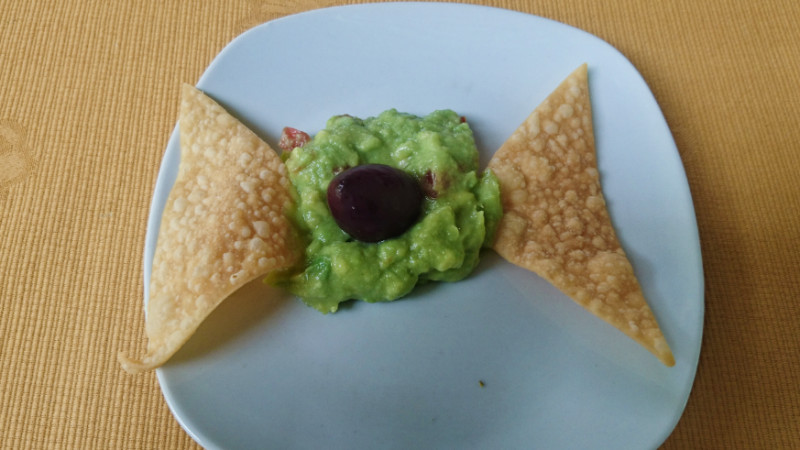 It was gone 2pm by the time I set off. The 10km walk is reckoned to take 2 hours. It’s not a lonely trek, this one. The walk to Aguas Calientes is a popular one saving $33US each way for a 10km ride. There were a lot of people walking towards me. Presumably the Machu Picchu morning crowd on their way home.
It was gone 2pm by the time I set off. The 10km walk is reckoned to take 2 hours. It’s not a lonely trek, this one. The walk to Aguas Calientes is a popular one saving $33US each way for a 10km ride. There were a lot of people walking towards me. Presumably the Machu Picchu morning crowd on their way home. Scattered along the railway are food shacks and vendors, campsites and hostels. Everything you’d normally expect along a roadside. It’s a bizarre arrangement but it works well to regulate tourism and preserve the site.
Scattered along the railway are food shacks and vendors, campsites and hostels. Everything you’d normally expect along a roadside. It’s a bizarre arrangement but it works well to regulate tourism and preserve the site. A few trains passed me both ways on the single track. A delicate act of scheduling, I imagine, so as they cross at the very few passing places.
A few trains passed me both ways on the single track. A delicate act of scheduling, I imagine, so as they cross at the very few passing places.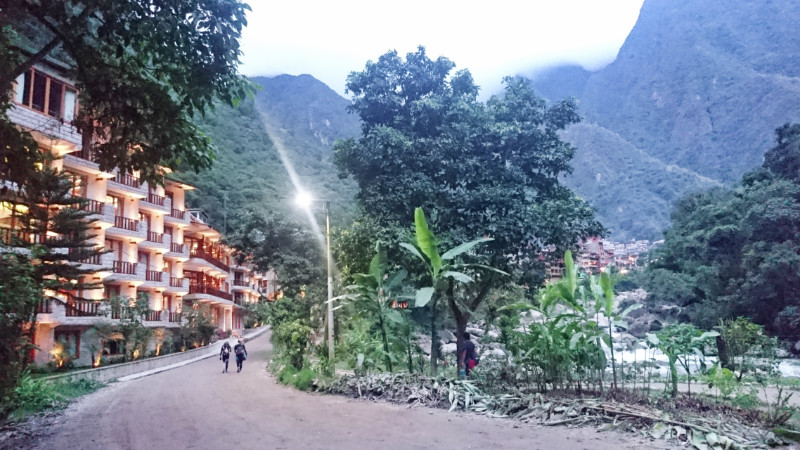 I ducked into the first hostel I found to try my luck at finding a dorm. The young receptionist could not understand my Spanish or English but worked out I wanted somewhere to stay the night. Presumably, as I was standing at the reception of a hostel. “S/30?” I agreed and she beckoned me outside, leading me to the main square and up an alley to another hostel, Huillca Wasi. A private room with a view out to the mountains and ensuite. It was more than I hoped for and only about £8 a night.
I ducked into the first hostel I found to try my luck at finding a dorm. The young receptionist could not understand my Spanish or English but worked out I wanted somewhere to stay the night. Presumably, as I was standing at the reception of a hostel. “S/30?” I agreed and she beckoned me outside, leading me to the main square and up an alley to another hostel, Huillca Wasi. A private room with a view out to the mountains and ensuite. It was more than I hoped for and only about £8 a night. The girl helped me check in and led me to the bus station kiosk to buy tomorrow’s bus ticket up the hill to Machu Picchu and then to the ticket office to the attraction itself. Walking to Machu Picchu is a 400m scale up rocky stairs, taking about one and a half to two hours. I wanted to be fresh at the site so opted for the S/40 single; more expensive than the hotel.
The girl helped me check in and led me to the bus station kiosk to buy tomorrow’s bus ticket up the hill to Machu Picchu and then to the ticket office to the attraction itself. Walking to Machu Picchu is a 400m scale up rocky stairs, taking about one and a half to two hours. I wanted to be fresh at the site so opted for the S/40 single; more expensive than the hotel.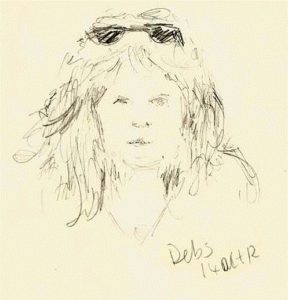
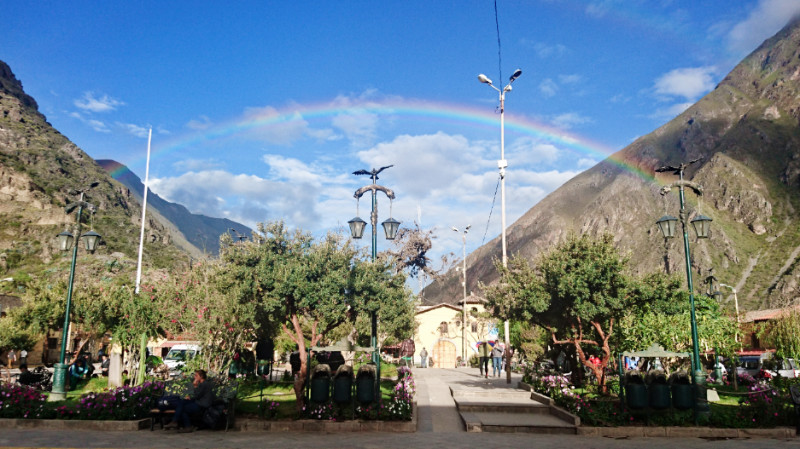 Over the next two weeks, I explore Ollantaytambo, mainly the coffee shops and tackle the rugged Pinkuylluna walk I chickened out of crossing the narrow, cliff path to the triple gabled granary to the south and instead explored the one on the northern promontory.
Over the next two weeks, I explore Ollantaytambo, mainly the coffee shops and tackle the rugged Pinkuylluna walk I chickened out of crossing the narrow, cliff path to the triple gabled granary to the south and instead explored the one on the northern promontory.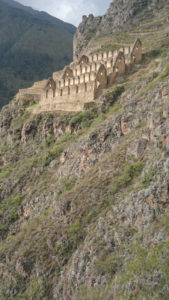 The views are stunning, even as the dark clouds bring flecks of rain over the southern peaks and threaten a storm.
The views are stunning, even as the dark clouds bring flecks of rain over the southern peaks and threaten a storm.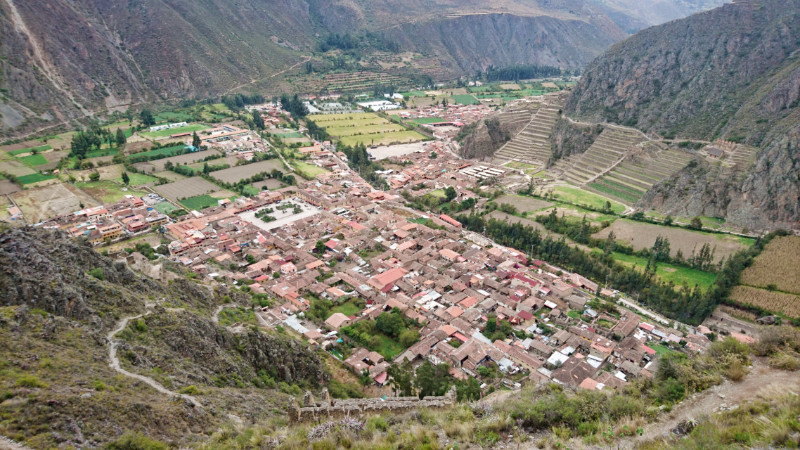 Once I had arrived at the point that my jellied knees convinced me to quit before, it didn’t seem quite as bad as I remembered. Looking straight ahead and filming with the phone, I strode ahead. At the ruin, I met Andrew from York, an ex-soldier enjoying a day off by climbing over rocky crags. He said he was going up to the ruin overlooking where we were, was I coming. How could I refuse? It was a challenge for completion.
Once I had arrived at the point that my jellied knees convinced me to quit before, it didn’t seem quite as bad as I remembered. Looking straight ahead and filming with the phone, I strode ahead. At the ruin, I met Andrew from York, an ex-soldier enjoying a day off by climbing over rocky crags. He said he was going up to the ruin overlooking where we were, was I coming. How could I refuse? It was a challenge for completion.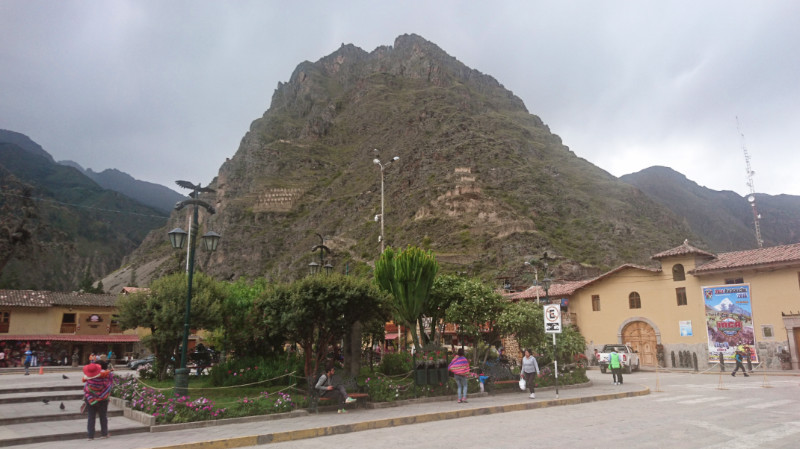 I found a place full of locals the food, good and cheap, before heading back to the campsite. The bike was all set so I said farewell to the proprietors, Ed and Laura, and rattled along the giant cobbles out on to the highway. Maps.me indicated a Fuel station not far to the west but I couldn’t find it and did a U-turn at the hotel at Phiry. There was no way I could make Santa Maria with the fuel I had in my tank. I pulled into the plaza in Ollantaytambo intending to interrogate the tourist office. A guy approached with intention of getting me to move my bike which saved me getting off the bike. Either 20 minutes east or 5 minutes west. As it turned out, the fuel station was about half a kilometre further from the point I turned around.
I found a place full of locals the food, good and cheap, before heading back to the campsite. The bike was all set so I said farewell to the proprietors, Ed and Laura, and rattled along the giant cobbles out on to the highway. Maps.me indicated a Fuel station not far to the west but I couldn’t find it and did a U-turn at the hotel at Phiry. There was no way I could make Santa Maria with the fuel I had in my tank. I pulled into the plaza in Ollantaytambo intending to interrogate the tourist office. A guy approached with intention of getting me to move my bike which saved me getting off the bike. Either 20 minutes east or 5 minutes west. As it turned out, the fuel station was about half a kilometre further from the point I turned around.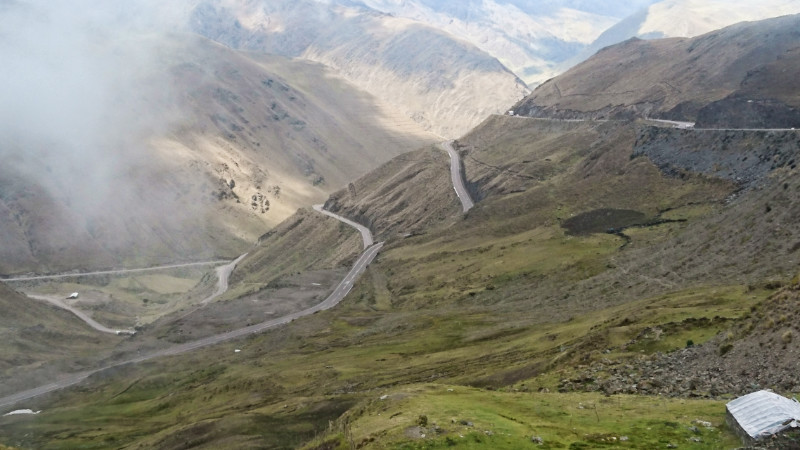 The road was smooth and swept through the Andean valleys in and out of the shade of the afternoon sun. The gentle incline was peppered with hairpin turns as I climbed further towards Abra Malaga. I didn’t know it at the time but the road is quite well
The road was smooth and swept through the Andean valleys in and out of the shade of the afternoon sun. The gentle incline was peppered with hairpin turns as I climbed further towards Abra Malaga. I didn’t know it at the time but the road is quite well 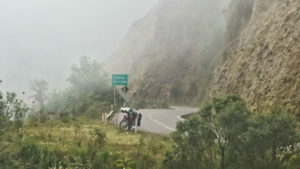 known. You can read more about it here at
known. You can read more about it here at 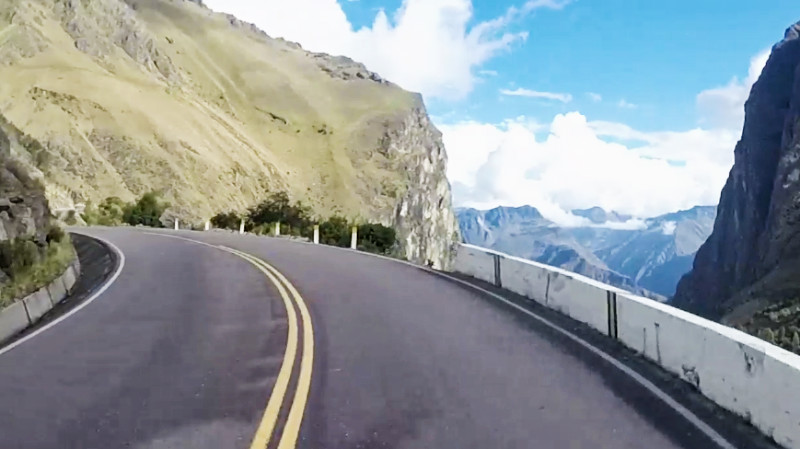 Below the clouds, I began to dry out and see through my glasses. Sunny spells returned to the day. I found myself tailing the fuel truck I had passed earlier. I had no desire to overtake it now, I was admiring the scenery, I felt like a pilot descending, looping around the hairpins. Dusk was falling by the time I reached Santa Maria, It was a long haul to get here, in endurance rather than distance.
Below the clouds, I began to dry out and see through my glasses. Sunny spells returned to the day. I found myself tailing the fuel truck I had passed earlier. I had no desire to overtake it now, I was admiring the scenery, I felt like a pilot descending, looping around the hairpins. Dusk was falling by the time I reached Santa Maria, It was a long haul to get here, in endurance rather than distance. My room had a small glassless window. Fine because it wasn’t cold or raining but useless for shielding the sound of the cockerel next door that started crowing at 3.15 and every hour after.
My room had a small glassless window. Fine because it wasn’t cold or raining but useless for shielding the sound of the cockerel next door that started crowing at 3.15 and every hour after. The campsite I noticed on maps.me is called Inka Tours and while it seemed a quiet corner of paradise, it later became a constant barrage of minibuses of hikers: hence the name, I guess. Hikers resting during their exclusive Inca Trail excursions over the Andes and through the Sacred Valley. S/10 a night felt a bargain. “Can you tell me the Wifi password?” “Si, five Soles…” “Is there anywhere to charge my laptop?” “Si, One Soles…” Took the shine off the place.
The campsite I noticed on maps.me is called Inka Tours and while it seemed a quiet corner of paradise, it later became a constant barrage of minibuses of hikers: hence the name, I guess. Hikers resting during their exclusive Inca Trail excursions over the Andes and through the Sacred Valley. S/10 a night felt a bargain. “Can you tell me the Wifi password?” “Si, five Soles…” “Is there anywhere to charge my laptop?” “Si, One Soles…” Took the shine off the place.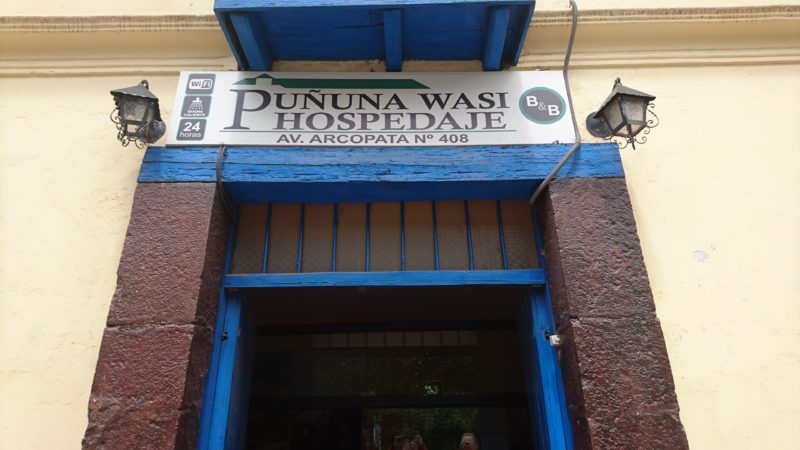 I’d been at the hostel so long that I felt at home and not that motivated to get moving. I’d been trying to mentally figure out optimal packing of the bike with my gear and the new stuff that came with the bike. I couldn’t do it without physically giving it a go and getting it wrong so that was the plan: experience was my best teacher. I packed the bags and pushed the bike out onto the street to start loading. The
I’d been at the hostel so long that I felt at home and not that motivated to get moving. I’d been trying to mentally figure out optimal packing of the bike with my gear and the new stuff that came with the bike. I couldn’t do it without physically giving it a go and getting it wrong so that was the plan: experience was my best teacher. I packed the bags and pushed the bike out onto the street to start loading. The 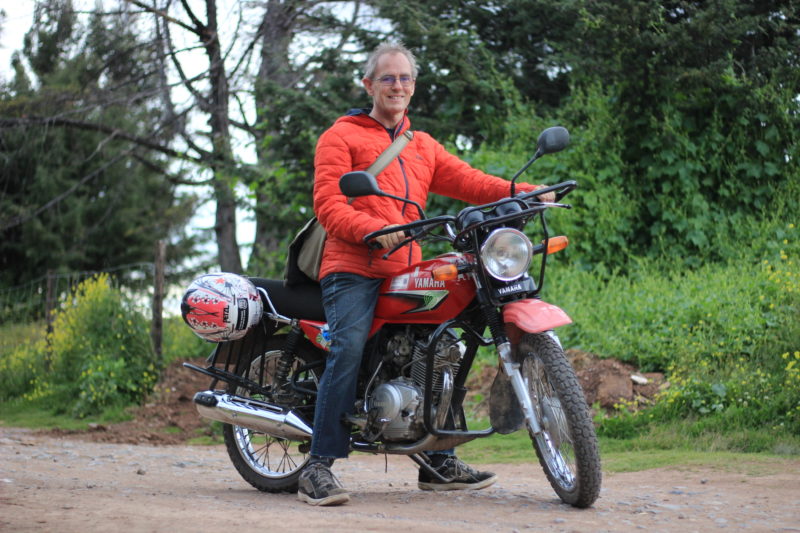 sun was already high and hot and the effort of lugging and repacking the bike in the hot thin atmosphere was parching my throat. I had already packed away the water, mental note for next time. First stop? The store a hundred metres up the road to quench it my thirst.
sun was already high and hot and the effort of lugging and repacking the bike in the hot thin atmosphere was parching my throat. I had already packed away the water, mental note for next time. First stop? The store a hundred metres up the road to quench it my thirst.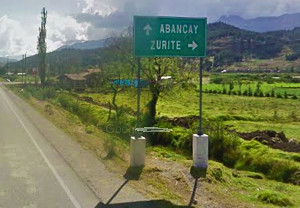 Up ahead is a right turn to Zurite, a track cuts across through Zurite to the road to Ollantaytambo. Packing my phone away and donning my gloves I turn along a shale track. Zurite isn’t too far off the main road but looks like a village from the third world. Laid out in a grid, the village is laced together with mud tracks and a suggestion of a central square.
Up ahead is a right turn to Zurite, a track cuts across through Zurite to the road to Ollantaytambo. Packing my phone away and donning my gloves I turn along a shale track. Zurite isn’t too far off the main road but looks like a village from the third world. Laid out in a grid, the village is laced together with mud tracks and a suggestion of a central square.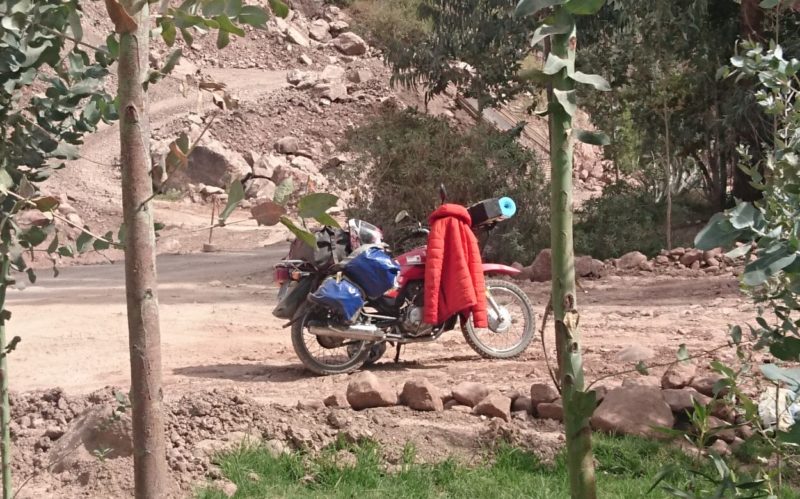 Cu-110 had degraded into a gravel track and I stop and remove my jacket to dry my jacket and me in my Tshirt, off in the sun. The satnav app tells me to turn right, parallel to the Urubamba river, the opposite direction from Ollantaytambo. The track takes me a quarter of a mile to a steel bridge and a T junction that was buzzing with tour buses and taxis: the main road between Cusco and Ollantaytambo and Machu Picchu beyond. Turning left, I joined the flow and tried to keep up, watching the more aggressive vehicles gain in my mirrors so I could wave them pass without a battle.
Cu-110 had degraded into a gravel track and I stop and remove my jacket to dry my jacket and me in my Tshirt, off in the sun. The satnav app tells me to turn right, parallel to the Urubamba river, the opposite direction from Ollantaytambo. The track takes me a quarter of a mile to a steel bridge and a T junction that was buzzing with tour buses and taxis: the main road between Cusco and Ollantaytambo and Machu Picchu beyond. Turning left, I joined the flow and tried to keep up, watching the more aggressive vehicles gain in my mirrors so I could wave them pass without a battle.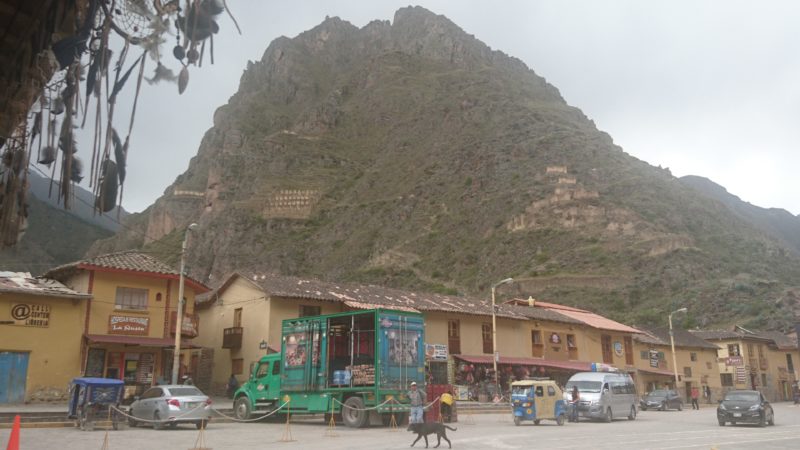 About 10 minutes later I was bucking over Incan cobbles behind a Coach rumbling into Ollantaytambo. I coast through a quaint square bristling with souvenir shops, cafes and tourists. Just past the square I turn left into Estudiante and judder along the coarse cobbles to the Casa Quechua campsite. My moto and I are welcomed through the back gate into the garden and I set about unpacking the bike for the first time. I’ll need to do better since the whole load had shifted forward but not far enough to foul the moving parts of the bike or me.
About 10 minutes later I was bucking over Incan cobbles behind a Coach rumbling into Ollantaytambo. I coast through a quaint square bristling with souvenir shops, cafes and tourists. Just past the square I turn left into Estudiante and judder along the coarse cobbles to the Casa Quechua campsite. My moto and I are welcomed through the back gate into the garden and I set about unpacking the bike for the first time. I’ll need to do better since the whole load had shifted forward but not far enough to foul the moving parts of the bike or me.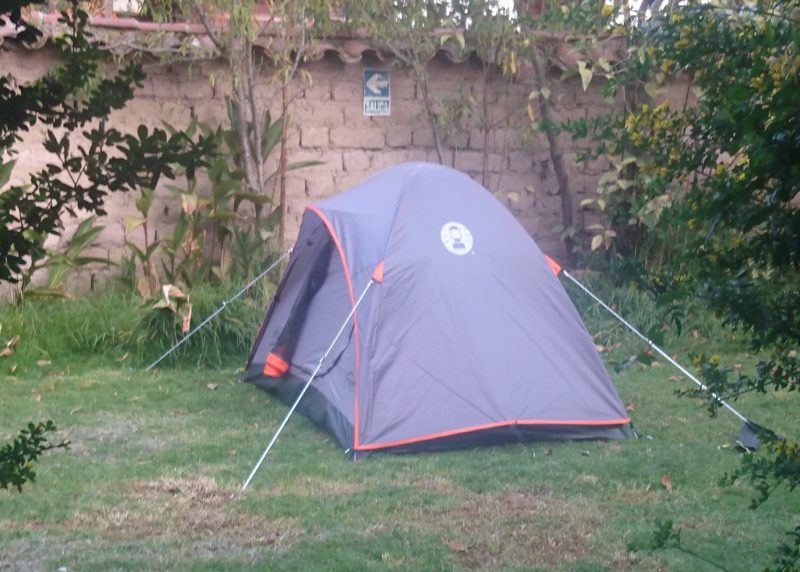 The tent was still in its original packaging, mainly a cardboard box, wet where the rain had penetrated the stitching of its outer bag. It’s a Coleman Rainforest 2, and comes with instructions in English, although the diagrams are self-explanatory. The tent was up in ten minutes, a record that should now easily be broken.
The tent was still in its original packaging, mainly a cardboard box, wet where the rain had penetrated the stitching of its outer bag. It’s a Coleman Rainforest 2, and comes with instructions in English, although the diagrams are self-explanatory. The tent was up in ten minutes, a record that should now easily be broken.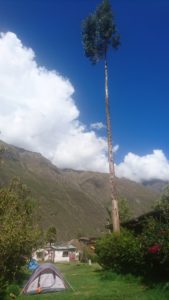 When I bought the tent, I was disappointed I couldn’t find a 2 man but now I was thankful as the luggage now took up quite a bit of room. I had the appetite of a Paris – Dakar competitor. I had skipped breakfast and lunch due to the packing earlier and was keen to shovel some food past my cracked lips and dry throat. Riding at altitude appears to be more dehydrating than normal, as well as exhausting.
When I bought the tent, I was disappointed I couldn’t find a 2 man but now I was thankful as the luggage now took up quite a bit of room. I had the appetite of a Paris – Dakar competitor. I had skipped breakfast and lunch due to the packing earlier and was keen to shovel some food past my cracked lips and dry throat. Riding at altitude appears to be more dehydrating than normal, as well as exhausting.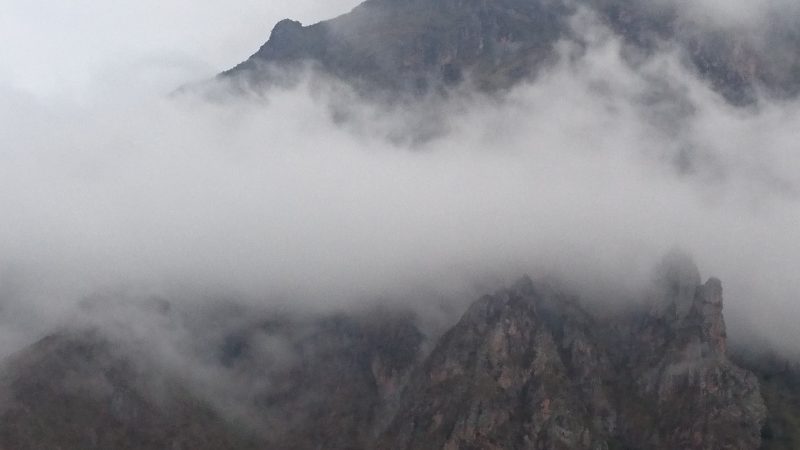 I emerge not long after dawn, grey formless clouds drape the Andean peaks. The morning air has a Celtic chill. No-one else stirs, all is quiet and there appears to be nothing to do, I retreat to the tent and scan for the absent WiFi signal while trying to keep warm.
I emerge not long after dawn, grey formless clouds drape the Andean peaks. The morning air has a Celtic chill. No-one else stirs, all is quiet and there appears to be nothing to do, I retreat to the tent and scan for the absent WiFi signal while trying to keep warm.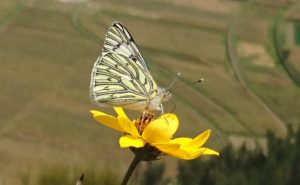 Sun 15th April, 6 days after buying the Motorbike. It’s difficult to gain access to the passageway and wheeling the bike over a plank down the steps, so I’ve been reluctant to move it again until its time to leave. Cusco is a charming city and I have no time pressures so hanging around here is not a bad option. As I get to know my way around, it starts to feel like home.
Sun 15th April, 6 days after buying the Motorbike. It’s difficult to gain access to the passageway and wheeling the bike over a plank down the steps, so I’ve been reluctant to move it again until its time to leave. Cusco is a charming city and I have no time pressures so hanging around here is not a bad option. As I get to know my way around, it starts to feel like home.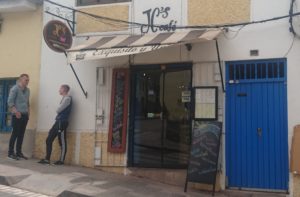 Mon 16th April, JC’s Cafe is at the end of the street. One of the best cafes I’ve ever visited. Needless to say, It’s the first destination for the day for breakfast and coffee. Abierto 8:30. Which means opening time randomly between half eight and nine. This morning I delay my breakfast and order a coffee anticipating company, Engrossed online, I’m suddenly swamped by curly hair and a warm hug. I had my back to the door and hadn’t noticed Rosalie’s arrival.
Mon 16th April, JC’s Cafe is at the end of the street. One of the best cafes I’ve ever visited. Needless to say, It’s the first destination for the day for breakfast and coffee. Abierto 8:30. Which means opening time randomly between half eight and nine. This morning I delay my breakfast and order a coffee anticipating company, Engrossed online, I’m suddenly swamped by curly hair and a warm hug. I had my back to the door and hadn’t noticed Rosalie’s arrival.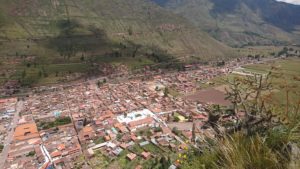 vibe. The market is huge, full of Peruvian colour, but apparently not many customers. Rosalie asks the Tourist Information official about the free options around Pisac. There are two: a Community Museum and a Botanical Garden. We walk up the hill along the cobbles until we get to the ticket office at the foot of the mountain path. 70 Soles for a 2 day ticket along the Sacred Valley. Rosalie emphasises we are only here for one day and, after a pause, the ticket clerk offers us a two for one deal, no one will check tickets on the trail, and we start to climb the path to the Inca ruins of Pisaq Old Town in the mountains.
vibe. The market is huge, full of Peruvian colour, but apparently not many customers. Rosalie asks the Tourist Information official about the free options around Pisac. There are two: a Community Museum and a Botanical Garden. We walk up the hill along the cobbles until we get to the ticket office at the foot of the mountain path. 70 Soles for a 2 day ticket along the Sacred Valley. Rosalie emphasises we are only here for one day and, after a pause, the ticket clerk offers us a two for one deal, no one will check tickets on the trail, and we start to climb the path to the Inca ruins of Pisaq Old Town in the mountains.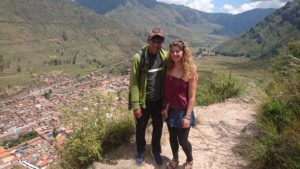 A few minutes up the dusty path, we encounter a young Peruvian with his backpack sitting on a rock in the shade of an outcrop. If this were a movie, it would have been an implausible introduction to a new character. It was almost as if he was placed waiting for us. Inti speaks fluent Quechua, Spanish and English and happens to be a tour guide on his day off. He invites us along to Pisaq Old Town with him and points out places of interest along the mountain path. The Incas built their settlements high in the mountains, the Spanish built theirs in the Valley. The Pisac we see in the valley is a small town of Spanish origin.
A few minutes up the dusty path, we encounter a young Peruvian with his backpack sitting on a rock in the shade of an outcrop. If this were a movie, it would have been an implausible introduction to a new character. It was almost as if he was placed waiting for us. Inti speaks fluent Quechua, Spanish and English and happens to be a tour guide on his day off. He invites us along to Pisaq Old Town with him and points out places of interest along the mountain path. The Incas built their settlements high in the mountains, the Spanish built theirs in the Valley. The Pisac we see in the valley is a small town of Spanish origin.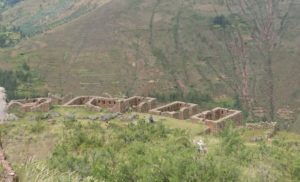 The ceremony ends after about 10 minutes and we part company, promising to visit his shop on the way back to the collectivos. Rosalie and I climb the steps to Intihuatana and then further on to the peak and gazebo with the view of the terraces. Over the stream, behind the terraces in the cliff face there appear to be doorways in the cliff face with no pathway up or down to them. It looks like a vertical community but it turns out it’s an Inca cemetery.
The ceremony ends after about 10 minutes and we part company, promising to visit his shop on the way back to the collectivos. Rosalie and I climb the steps to Intihuatana and then further on to the peak and gazebo with the view of the terraces. Over the stream, behind the terraces in the cliff face there appear to be doorways in the cliff face with no pathway up or down to them. It looks like a vertical community but it turns out it’s an Inca cemetery.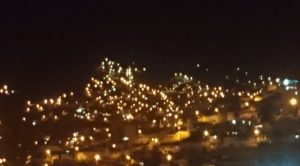 Darkness had fallen on the sparkling cityscape of Cusco. The intention was to end the day with a craft beer at Eusebio & Manalo, except it was closed. Instead, we shared a litre of Cusqueno Trigo wheat beer back at Rosalie’s hostal.
Darkness had fallen on the sparkling cityscape of Cusco. The intention was to end the day with a craft beer at Eusebio & Manalo, except it was closed. Instead, we shared a litre of Cusqueno Trigo wheat beer back at Rosalie’s hostal.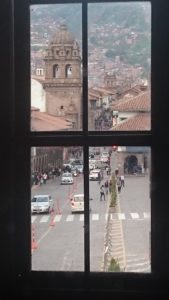 I chose the shortest route from Lima to Cusco via Nazca. Fear mongers related stories of bandits holding up coaches in the Andes where there is no cell signal available for calling for help. The last reported case I could find was in 2013, 5 years previous. Being held up looked extremely unlikely, to me, despite sensational internet reports.
I chose the shortest route from Lima to Cusco via Nazca. Fear mongers related stories of bandits holding up coaches in the Andes where there is no cell signal available for calling for help. The last reported case I could find was in 2013, 5 years previous. Being held up looked extremely unlikely, to me, despite sensational internet reports.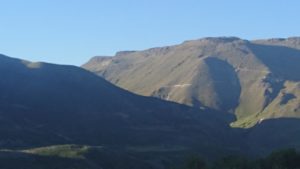 With the light of the dawn, the mountains presented themselves in their majestic beauty. The road lay like spaghetti dropped down mountainsides into the valleys. Pressing my head against the window, I could see traffic ahead and behind. the route is not as deserted as I expected. Any bandits would have a hard time remaining anonymous, at least at this time of day.
With the light of the dawn, the mountains presented themselves in their majestic beauty. The road lay like spaghetti dropped down mountainsides into the valleys. Pressing my head against the window, I could see traffic ahead and behind. the route is not as deserted as I expected. Any bandits would have a hard time remaining anonymous, at least at this time of day.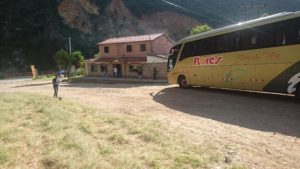 The excitement of stopping for breakfast was brief. I wasn’t hungry and the coffee I looked forward to did not exist. Instead, I kicked over the car park gravel, warmed by the early morning sun until the bus driver was ready to thread us through the Andes again.
The excitement of stopping for breakfast was brief. I wasn’t hungry and the coffee I looked forward to did not exist. Instead, I kicked over the car park gravel, warmed by the early morning sun until the bus driver was ready to thread us through the Andes again.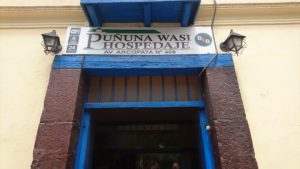 The bus rolled into Cusco Thursday afternoon at 3.30pm. Tour guides thrust leaflets into our hands. “Cheap Hotel 70 Soles?” I wanted cheaper. “40 Soles?” that was OK and I was escorted to an eager taxi and ferried to the hostel Pununa Wasi on Avenue Arcopata.
The bus rolled into Cusco Thursday afternoon at 3.30pm. Tour guides thrust leaflets into our hands. “Cheap Hotel 70 Soles?” I wanted cheaper. “40 Soles?” that was OK and I was escorted to an eager taxi and ferried to the hostel Pununa Wasi on Avenue Arcopata.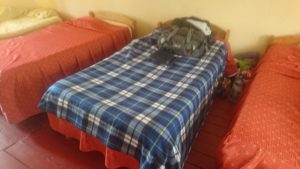 “Lo Siento,” no room. Dorm for “15 Soles?” Perfect, about £3 a night. The dorm was spacious but basic with painted creaky floorboards, 8 single beds and some ill-fitting raggedy curtains limp at the window failing at masking the daylight and the sound of tyres rattling along cobbles of Arcopata, and the random honking of taxis and buses. There appeared to be no more than 2 people currently staying. I later learned that that meant nothing since backpackers arrived at all hours by air and bus for Machu Picchu, stumbling around looking for mains sockets for phone chargers before settling down to sleep.
“Lo Siento,” no room. Dorm for “15 Soles?” Perfect, about £3 a night. The dorm was spacious but basic with painted creaky floorboards, 8 single beds and some ill-fitting raggedy curtains limp at the window failing at masking the daylight and the sound of tyres rattling along cobbles of Arcopata, and the random honking of taxis and buses. There appeared to be no more than 2 people currently staying. I later learned that that meant nothing since backpackers arrived at all hours by air and bus for Machu Picchu, stumbling around looking for mains sockets for phone chargers before settling down to sleep.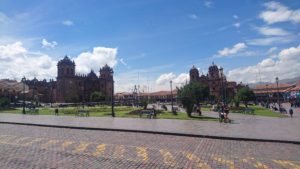 I skate across the polished volcanic cobbles in treadless trainers toward Plaza de Armas, the main square, at noon the next day to meet Nikita. He didn’t recognise me since I hadn’t updated my facebook picture since I had opened my Facebook account 10 years previous. We walked to where the bike was parked and gave me a ride up to Temple de la Luna where his AirBnB overlooked Cusco. Anastasia made me muna tea and we talked about the motorbike before taking it for a test ride.
I skate across the polished volcanic cobbles in treadless trainers toward Plaza de Armas, the main square, at noon the next day to meet Nikita. He didn’t recognise me since I hadn’t updated my facebook picture since I had opened my Facebook account 10 years previous. We walked to where the bike was parked and gave me a ride up to Temple de la Luna where his AirBnB overlooked Cusco. Anastasia made me muna tea and we talked about the motorbike before taking it for a test ride.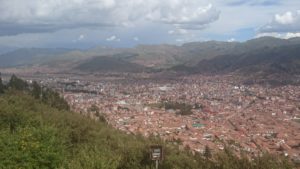 Cusco lies in a long valley at 3,400 m (11,200 ft) elevation and has t shirt weather in the day with a British spring-like chill during the night.
Cusco lies in a long valley at 3,400 m (11,200 ft) elevation and has t shirt weather in the day with a British spring-like chill during the night.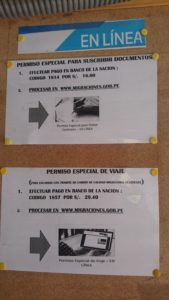 Now we needed a stamp in the passport from Migraciones. The queue eventually delivered us to a Spanish speaking official that told us that a stamp was not necessario and pointed to a notice at the front of the office. We should go to the Nacional Bank and pay 16 Soles where they give us a ticket of code numbers for completing an online form.
Now we needed a stamp in the passport from Migraciones. The queue eventually delivered us to a Spanish speaking official that told us that a stamp was not necessario and pointed to a notice at the front of the office. We should go to the Nacional Bank and pay 16 Soles where they give us a ticket of code numbers for completing an online form.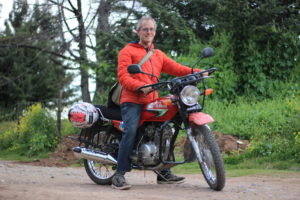 4pm, not a bad days work and now I was the owner of a Yamaha YB125 in Peru. I was set to go. After returning Nikita home, I rode back along the cobbles to the hostel and parked the bike along the passage next to reception.
4pm, not a bad days work and now I was the owner of a Yamaha YB125 in Peru. I was set to go. After returning Nikita home, I rode back along the cobbles to the hostel and parked the bike along the passage next to reception.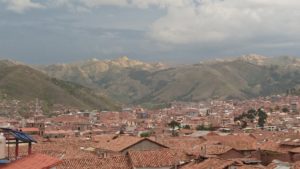 Rosalie was coming to Cusco next week so I thought I’d hang around and enjoy a brief reunion. As it happened, I liked Cusco. There is a lot to see and it has a nice laid back vibe. Besides, the hostel was a quiet place to look into establishing an online income and between bouts of procrastination and idleness, I set about prodding around with that possibility. I soon found out that long periods online sap the spirit and whichever way I was going to go, creating an income without lapsing back into a slave existence was going to be a long haul.
Rosalie was coming to Cusco next week so I thought I’d hang around and enjoy a brief reunion. As it happened, I liked Cusco. There is a lot to see and it has a nice laid back vibe. Besides, the hostel was a quiet place to look into establishing an online income and between bouts of procrastination and idleness, I set about prodding around with that possibility. I soon found out that long periods online sap the spirit and whichever way I was going to go, creating an income without lapsing back into a slave existence was going to be a long haul.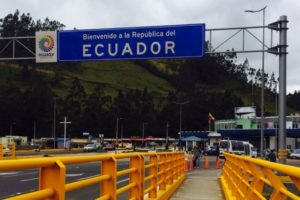 Crossing the Ecuador border was straight forward after the half hour queue. “Occupation?” “Computer Engineer,” after reading a tip that saying writer or journalist can be problematic.
Crossing the Ecuador border was straight forward after the half hour queue. “Occupation?” “Computer Engineer,” after reading a tip that saying writer or journalist can be problematic.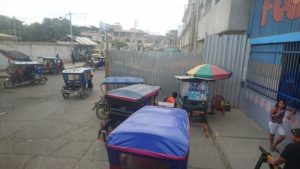 At the terminal, there was no bus to Cusco. Go to Lima and change. 90 Soles, departure at 8:30am. My visa card was rejected by the official and I walked about a mile to the ATM in the town. 6am and the Tumbes traffic was just honking its way to life. Drawing out the soles, I made my way safely back to the terminal and waited.
At the terminal, there was no bus to Cusco. Go to Lima and change. 90 Soles, departure at 8:30am. My visa card was rejected by the official and I walked about a mile to the ATM in the town. 6am and the Tumbes traffic was just honking its way to life. Drawing out the soles, I made my way safely back to the terminal and waited.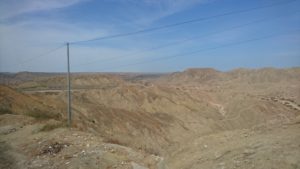 On the bus, through the Tumbes rush hour and we were soon zipping along the Panamerican highway. the land was flat and barren, reminding me of the Sinai, which led to thinking about Deb. Deb and I used to pick up cheap flights and go to her apartment in Sharm el Sheik for a month in the winters. She told me one of her dreams was to go to Machu Picchu. Cusco was the tourist springboard for that. Now she was dead there remained only memories and ‘shoulds’ and my attention resumed to the passing scenery.
On the bus, through the Tumbes rush hour and we were soon zipping along the Panamerican highway. the land was flat and barren, reminding me of the Sinai, which led to thinking about Deb. Deb and I used to pick up cheap flights and go to her apartment in Sharm el Sheik for a month in the winters. She told me one of her dreams was to go to Machu Picchu. Cusco was the tourist springboard for that. Now she was dead there remained only memories and ‘shoulds’ and my attention resumed to the passing scenery.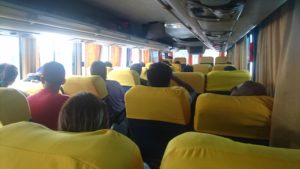 It is warmer here near sea level and this bus, unlike the others, does not engage its air conditioning. And unusually had opening windows.
It is warmer here near sea level and this bus, unlike the others, does not engage its air conditioning. And unusually had opening windows.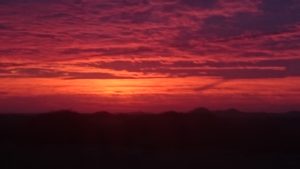 The Panamerican highway changes from dry shrubs to barren hills to flat plains and rice fields. The Pacific shore comes and goes in and out of view and the straight smooth asphalt degrades into gravel track and back again.
The Panamerican highway changes from dry shrubs to barren hills to flat plains and rice fields. The Pacific shore comes and goes in and out of view and the straight smooth asphalt degrades into gravel track and back again.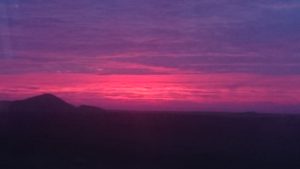 This is probably the oldest and most basic bus I’ve been on so far, with no power or wifi, but the journey seems less tiring without the constant sharp cornering and changes of altitude. The straighter roads make for faster speeds and there’s a real sense of making progress on the thousand kilometre journey to Lima.
This is probably the oldest and most basic bus I’ve been on so far, with no power or wifi, but the journey seems less tiring without the constant sharp cornering and changes of altitude. The straighter roads make for faster speeds and there’s a real sense of making progress on the thousand kilometre journey to Lima.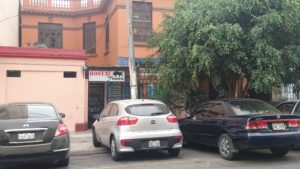 I devise a cunning plan, I notice a Hostel on the maps.me app on my phone not far from the terminal. It’s a 5 minute walk past the stadium and military barracks to an unassuming narrow entrance tucked behind a tree. I ring the bell and a short Peruvian appears rubbing his eyes and yawning. Normally, check in is not until the afternoon at these places but he shows me a double room with ensuite. Perfecto. It has a strong wifi signal as I’m right near the router.
I devise a cunning plan, I notice a Hostel on the maps.me app on my phone not far from the terminal. It’s a 5 minute walk past the stadium and military barracks to an unassuming narrow entrance tucked behind a tree. I ring the bell and a short Peruvian appears rubbing his eyes and yawning. Normally, check in is not until the afternoon at these places but he shows me a double room with ensuite. Perfecto. It has a strong wifi signal as I’m right near the router. The room looks like a prison cell. Looking up at the ceiling reveals daylight around the edges. This must have been an open courtyard at one time. It doesn’t matter, it’s not raining and I have the benefit of fresh air and the full volume of background city noise of horns, car alarms and the whistles of the traffic police. My single pair of socks are beginning to smell so I give them a wash in the sink and drape them over the electric fan, which also acts to mask the noise of the city and the audio from the Peruvian soap opera entertaining the receptionist in the foyer.
The room looks like a prison cell. Looking up at the ceiling reveals daylight around the edges. This must have been an open courtyard at one time. It doesn’t matter, it’s not raining and I have the benefit of fresh air and the full volume of background city noise of horns, car alarms and the whistles of the traffic police. My single pair of socks are beginning to smell so I give them a wash in the sink and drape them over the electric fan, which also acts to mask the noise of the city and the audio from the Peruvian soap opera entertaining the receptionist in the foyer.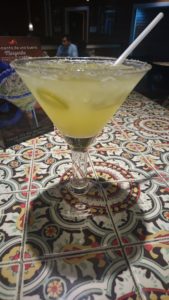 Now, a Mango and Jalapeno Margarita doesn’t sound too appealing but it was one of the most delicious margaritas I’d tasted. A perfect accompaniment to the chicken tacos and watching Real Madrid beat Juventus on three flat screens hanging off the walls of the restaurant.
Now, a Mango and Jalapeno Margarita doesn’t sound too appealing but it was one of the most delicious margaritas I’d tasted. A perfect accompaniment to the chicken tacos and watching Real Madrid beat Juventus on three flat screens hanging off the walls of the restaurant.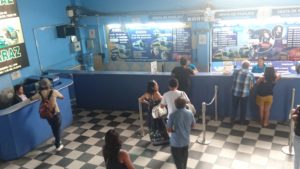 I arrived early at the bus Terminal to make sure I got a seat as I noticed it was busy already yesterday when I arrived before dawn. The bus wasn’t until 5.30. It was 1.30 so I made myself comfortable in the cafeteria for the next four hours…
I arrived early at the bus Terminal to make sure I got a seat as I noticed it was busy already yesterday when I arrived before dawn. The bus wasn’t until 5.30. It was 1.30 so I made myself comfortable in the cafeteria for the next four hours…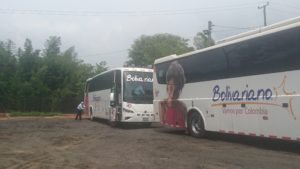 2pm. We pulled into a services for buses. Pulling out my phone and looking at the maps app, we had only covered a small portion of the distance in this 6 hour leg. My info had the journey as 10 hours total.
2pm. We pulled into a services for buses. Pulling out my phone and looking at the maps app, we had only covered a small portion of the distance in this 6 hour leg. My info had the journey as 10 hours total.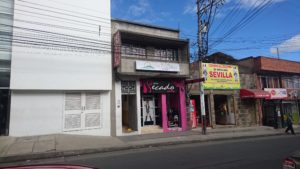 Walking along Calle 13, I stopped at the marker that indicated the hostel on the satnav. Nothing. Checking the email for the address, the numbers suggested it was further down the street – yes, there it was, a narrow doorway like an unread and forgotten book on a bookshelf squeezed between a closed down cafe and a sex shop.
Walking along Calle 13, I stopped at the marker that indicated the hostel on the satnav. Nothing. Checking the email for the address, the numbers suggested it was further down the street – yes, there it was, a narrow doorway like an unread and forgotten book on a bookshelf squeezed between a closed down cafe and a sex shop. Not far down the road, I hopped on a passing collectivo. A collectivo is like a taxi that waits for a full load before moving off only this was a bus with the word ‘Collectivo’ written down the side. It stopped about a mile and a half short of Las Lajas but I could see the sanctuary almost straight away from the road, way down below me in the gorge. The road gently descended the mountainside sweeping around the contours which made for an easy walk. A block paved path eventually forked away from the road and quickly got steeper, scaling down the side of the gorge. I’d lost sight of the sanctuary but the increasing presence of more and more vendors selling nik naks from selfy sticks to plastic virgin marys and religious candles confirmed the route.
Not far down the road, I hopped on a passing collectivo. A collectivo is like a taxi that waits for a full load before moving off only this was a bus with the word ‘Collectivo’ written down the side. It stopped about a mile and a half short of Las Lajas but I could see the sanctuary almost straight away from the road, way down below me in the gorge. The road gently descended the mountainside sweeping around the contours which made for an easy walk. A block paved path eventually forked away from the road and quickly got steeper, scaling down the side of the gorge. I’d lost sight of the sanctuary but the increasing presence of more and more vendors selling nik naks from selfy sticks to plastic virgin marys and religious candles confirmed the route.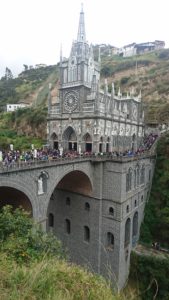 I had the usual meander around the attraction, buying nothing but an ice cream and climbed off the path to record a quick Youtube video before making my way to the cable car station I’d happily noticed on my arrival. Teleferico, they call it here. I was hauled high over the deep gorge up the mountain and returned to near where the bus drop-off was, relieving me of the thought of that long high altitude oxygen depleted climb back up the mountain nursed in the back of my mind all the way down.
I had the usual meander around the attraction, buying nothing but an ice cream and climbed off the path to record a quick Youtube video before making my way to the cable car station I’d happily noticed on my arrival. Teleferico, they call it here. I was hauled high over the deep gorge up the mountain and returned to near where the bus drop-off was, relieving me of the thought of that long high altitude oxygen depleted climb back up the mountain nursed in the back of my mind all the way down.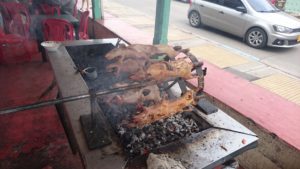 Charco is on the outskirts of Ipiales. It had a mention in Lonely Planet and looked pretty and colourful from a distance with the multicoloured houses stretching up the hillside. But the centre was nothing special apart from restaurants having some kind of rat on a spit over charcoal. It was cuy, later revealed as guinea pig. There wasn’t much else available for lunch here apart for a chicken place around the corner.
Charco is on the outskirts of Ipiales. It had a mention in Lonely Planet and looked pretty and colourful from a distance with the multicoloured houses stretching up the hillside. But the centre was nothing special apart from restaurants having some kind of rat on a spit over charcoal. It was cuy, later revealed as guinea pig. There wasn’t much else available for lunch here apart for a chicken place around the corner.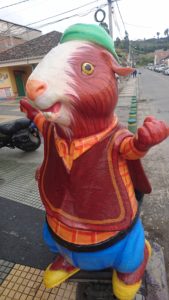 Between leaving the spit and arriving at my table, The cuy appeared to have been opened up and hammered flat. Flipping it over revealed kidneys in tact below a rack of ribs and either side of a thin spine. The skin was tough with the texture of leather but the flavour of pork rind. I threw that to a dog and watched it struggle to chew it into small enough pieces to swallow.
Between leaving the spit and arriving at my table, The cuy appeared to have been opened up and hammered flat. Flipping it over revealed kidneys in tact below a rack of ribs and either side of a thin spine. The skin was tough with the texture of leather but the flavour of pork rind. I threw that to a dog and watched it struggle to chew it into small enough pieces to swallow.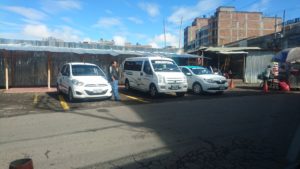 Sunday, I awoke early due to the noise of early rising guests through paper thin walls and lay in until 7.30. The internet wasn’t working which prompted me up for an early shower and to pack for Quito and beyond. I packed and left the Hotel and headed for the frontier taxis via La Taverna for breakfast but, even though the door was ajar and there was activity in the kitchen, it was not yet open. Too impatient to wait, I decided to postpone breakfast until the bus station at Tulcan, just over the border in Ecuador and strode around the corner toward the frontier taxis.
Sunday, I awoke early due to the noise of early rising guests through paper thin walls and lay in until 7.30. The internet wasn’t working which prompted me up for an early shower and to pack for Quito and beyond. I packed and left the Hotel and headed for the frontier taxis via La Taverna for breakfast but, even though the door was ajar and there was activity in the kitchen, it was not yet open. Too impatient to wait, I decided to postpone breakfast until the bus station at Tulcan, just over the border in Ecuador and strode around the corner toward the frontier taxis.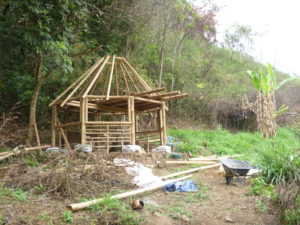 Helping build the cabana was hard work and it was highlighting my lack of fitness. Bending, lifting and climbing was physically draining although regular water intake and mambe helped fuel me for the workday.
Helping build the cabana was hard work and it was highlighting my lack of fitness. Bending, lifting and climbing was physically draining although regular water intake and mambe helped fuel me for the workday. Though the work was hard, working with such a group of positive people was fun and fulfilling.
Though the work was hard, working with such a group of positive people was fun and fulfilling.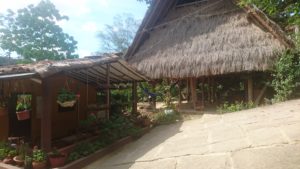 All of us would be staying at La Palmita but I would continue to San Gil the next day to embark on my journey to Cusco, so I packed all my things together with pillow and blanket and took them with me.
All of us would be staying at La Palmita but I would continue to San Gil the next day to embark on my journey to Cusco, so I packed all my things together with pillow and blanket and took them with me.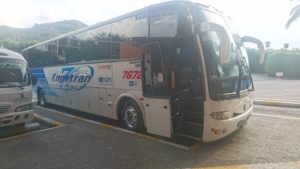 I awoke before 8am and spent some time online before packing. The plan was to catch an early bus to Bogota for making sure of arriving to open ticket offices there. It was gone lunchtime before I finished online and ready to head to the station. In fact, I thought maybe I could stay at El Dorado just one more night and go in the morning but decided to be proactive and just go. There’s a bus every hour to Bogota and I’d missed the 15:00 by four minutes but a fifty six minute wait isn’t too bad, even though it put the departure at 4pm. It’s six or seven hours to Bogota so it was looking like a midnight arrival.
I awoke before 8am and spent some time online before packing. The plan was to catch an early bus to Bogota for making sure of arriving to open ticket offices there. It was gone lunchtime before I finished online and ready to head to the station. In fact, I thought maybe I could stay at El Dorado just one more night and go in the morning but decided to be proactive and just go. There’s a bus every hour to Bogota and I’d missed the 15:00 by four minutes but a fifty six minute wait isn’t too bad, even though it put the departure at 4pm. It’s six or seven hours to Bogota so it was looking like a midnight arrival.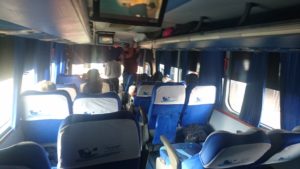 The bus was late and we set off at 16:40. No use worrying about the connection. Just have to see what happens when we get there. My patience has been tested and been found to be resilient.
The bus was late and we set off at 16:40. No use worrying about the connection. Just have to see what happens when we get there. My patience has been tested and been found to be resilient.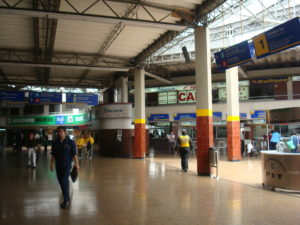 It was a slow sleepless eight hours as I watched the daylight slowly chase the darkness away and crowds gather for the various buses pulling into the bays. The bus to Ipiales was packed and I was behind a family with three young kids. My fingers were crossed for a peaceful journey. I quickly visited the bus toilet, as I was intent on saving another thousand pesos by avoiding the services in the terminal, and then settled in my seat hoping I wouldn’t need to go again looking at the state of it.
It was a slow sleepless eight hours as I watched the daylight slowly chase the darkness away and crowds gather for the various buses pulling into the bays. The bus to Ipiales was packed and I was behind a family with three young kids. My fingers were crossed for a peaceful journey. I quickly visited the bus toilet, as I was intent on saving another thousand pesos by avoiding the services in the terminal, and then settled in my seat hoping I wouldn’t need to go again looking at the state of it.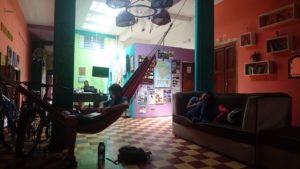 I’ve been out of the company of good friends for a while so feel like some camaraderie. I like solitude but it can get too much sometimes. “Don’t go for comfort,” Ayahuasca told me. Solitude is often comfortable for me but not long term.
I’ve been out of the company of good friends for a while so feel like some camaraderie. I like solitude but it can get too much sometimes. “Don’t go for comfort,” Ayahuasca told me. Solitude is often comfortable for me but not long term.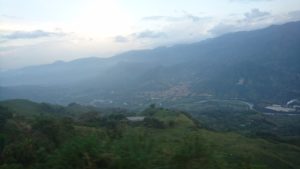 I awoke with my head resting on my shoulder, dribble on my jacket and a neck pain that warned me not to straighten up too quickly. It was daylight and I recognised the valley from the trip before. 7Am, we were just North of Bucaramanga. Gisela lived here, I should have checked whether she was back here or still at La Finca Nuevos Horizantes near San Gil. We get on well despite the language barrier, neither of us speak each other’s language. An opportunity for accelerated learning, perhaps.
I awoke with my head resting on my shoulder, dribble on my jacket and a neck pain that warned me not to straighten up too quickly. It was daylight and I recognised the valley from the trip before. 7Am, we were just North of Bucaramanga. Gisela lived here, I should have checked whether she was back here or still at La Finca Nuevos Horizantes near San Gil. We get on well despite the language barrier, neither of us speak each other’s language. An opportunity for accelerated learning, perhaps.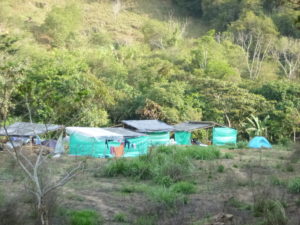 Walking down the track from the entrance, I could see the guys had been busy. there were a number of new structures and the tents were now under cover since the ultraviolet rays cause them to leak after a time in the sun.
Walking down the track from the entrance, I could see the guys had been busy. there were a number of new structures and the tents were now under cover since the ultraviolet rays cause them to leak after a time in the sun.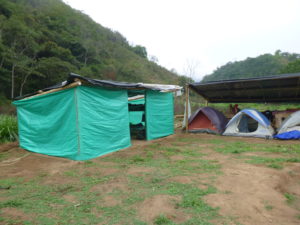 There was steady activity in one of the new structures with new bamboo uprights being erected under a plastic roof. I helped Mitch with some cross members and retired to the Maloka after lunch while it rained. At the end of the day, there were 2 new sturdy bunk beds assembled and ready for guests, not realising that this was for me and Mike.
There was steady activity in one of the new structures with new bamboo uprights being erected under a plastic roof. I helped Mitch with some cross members and retired to the Maloka after lunch while it rained. At the end of the day, there were 2 new sturdy bunk beds assembled and ready for guests, not realising that this was for me and Mike.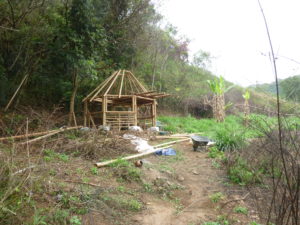 Over in the trees, I noticed a bamboo framework of a new structure. This was going to be a permanent cabana for guests. This looked like an interesting project and I decided to commit myself to help with the construction while I was here. After all, it would only be three or four days work before I have to leave for Peru…
Over in the trees, I noticed a bamboo framework of a new structure. This was going to be a permanent cabana for guests. This looked like an interesting project and I decided to commit myself to help with the construction while I was here. After all, it would only be three or four days work before I have to leave for Peru…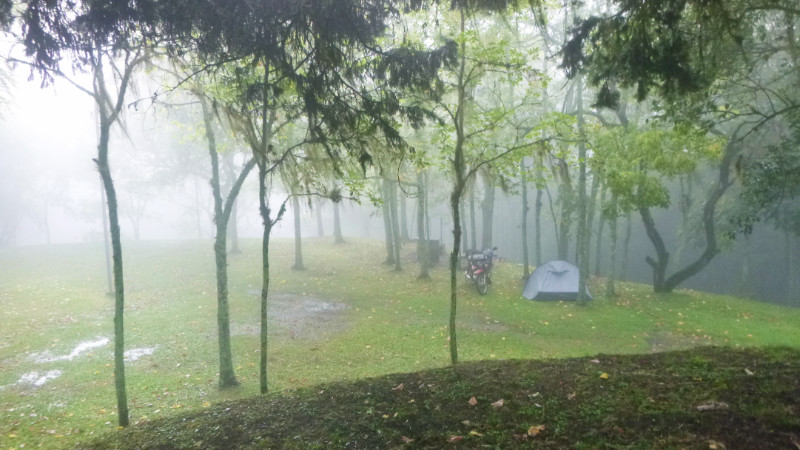
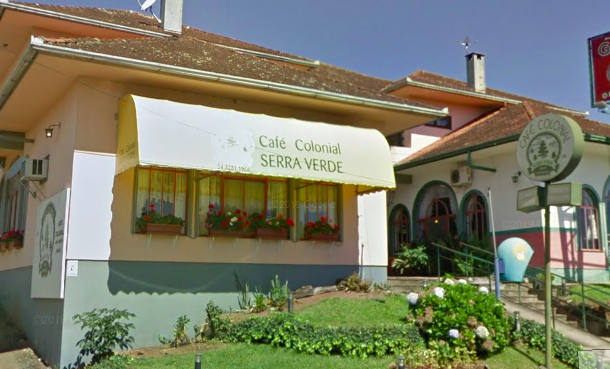
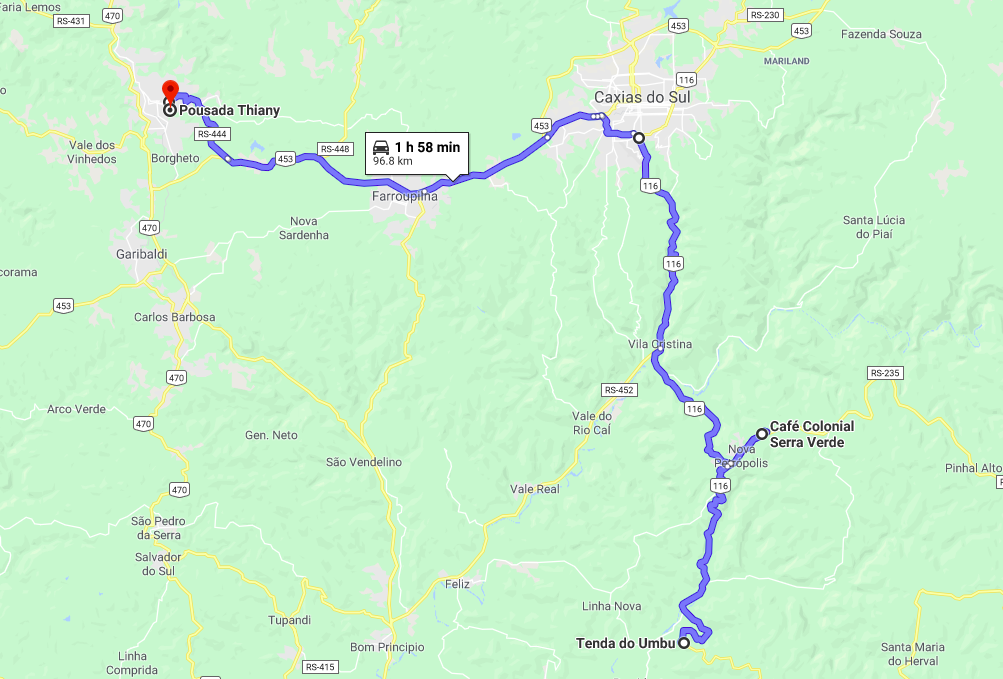
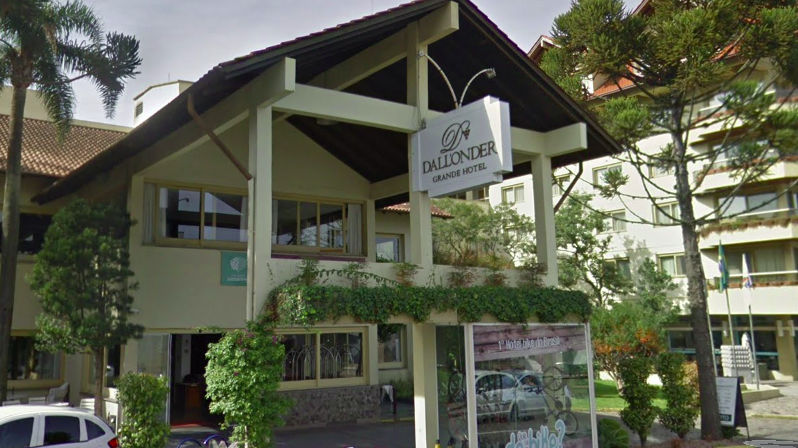
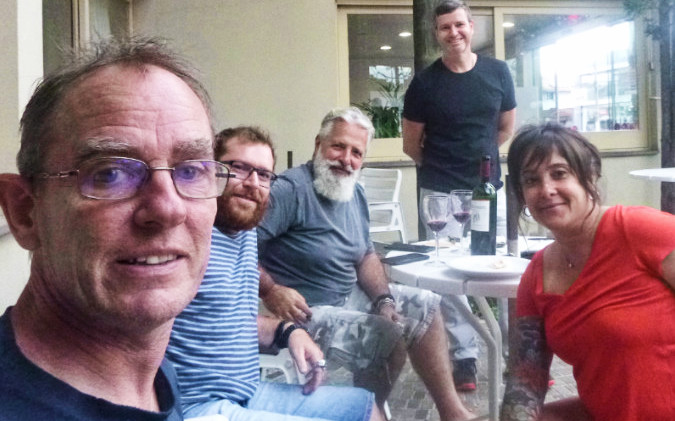
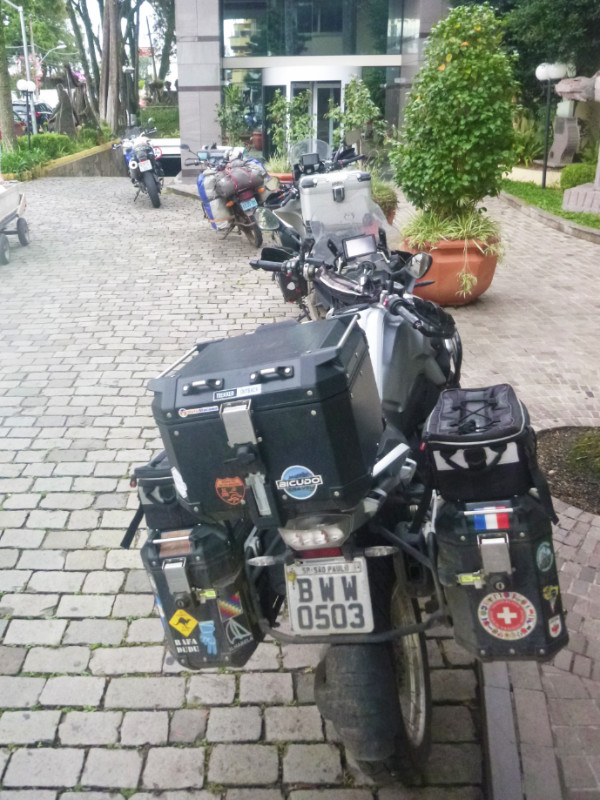
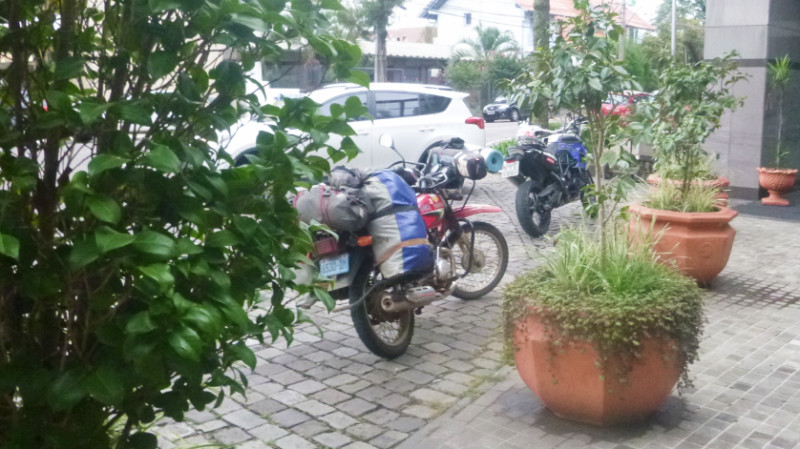
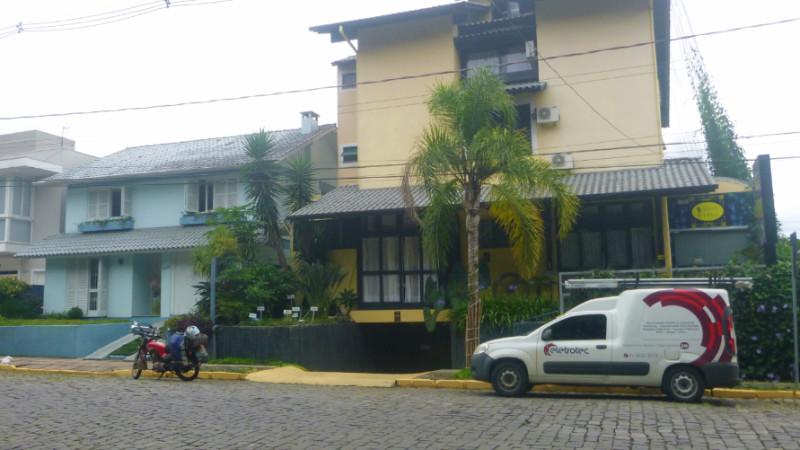



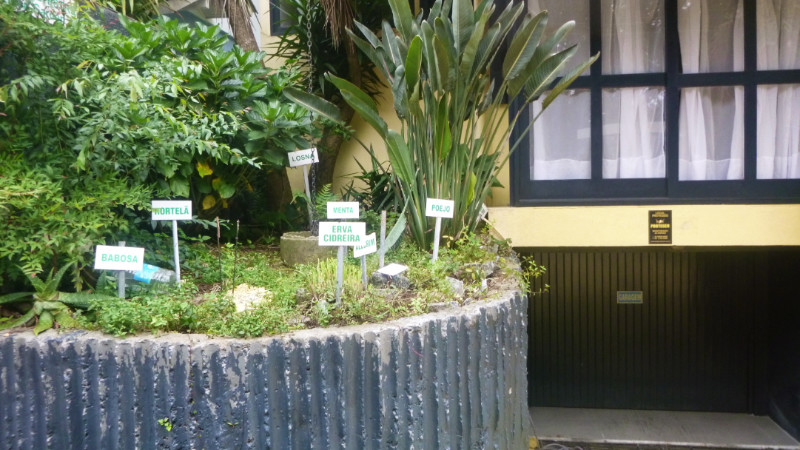
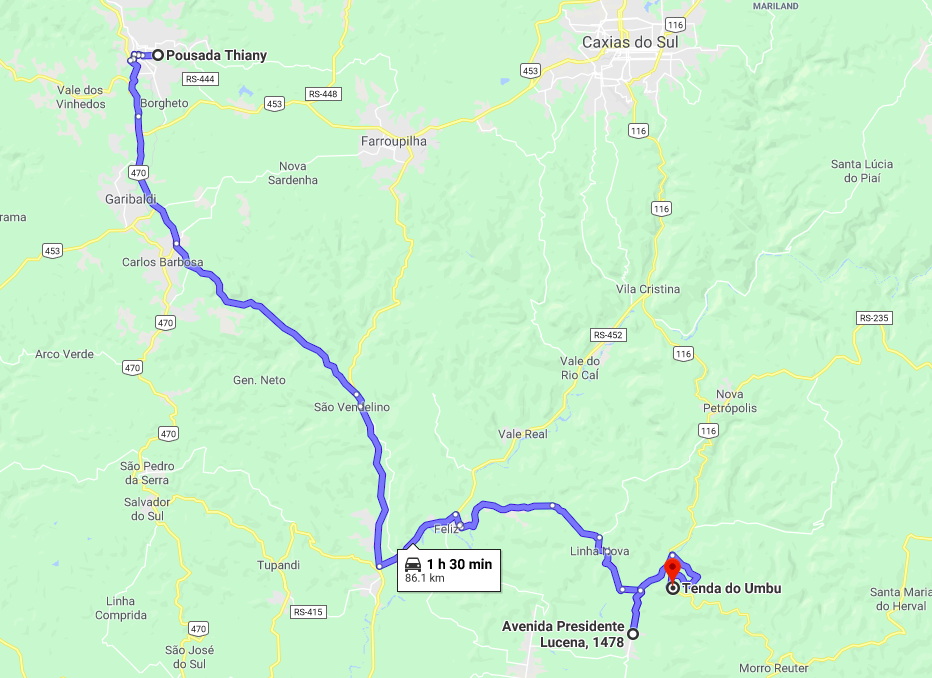
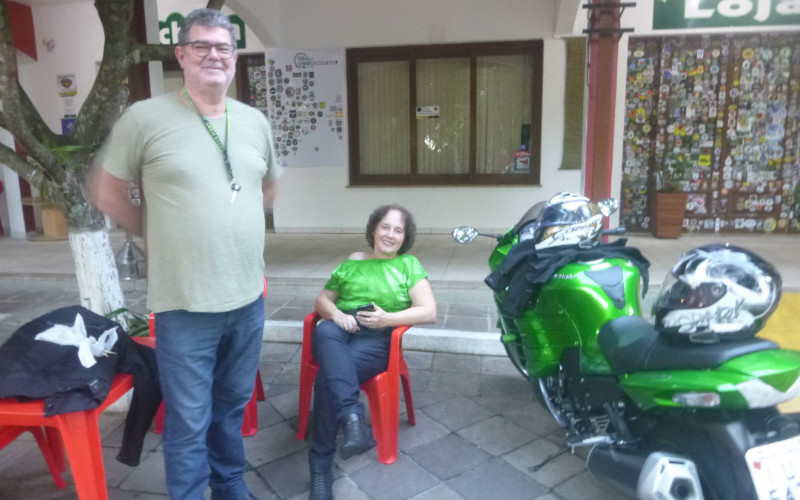
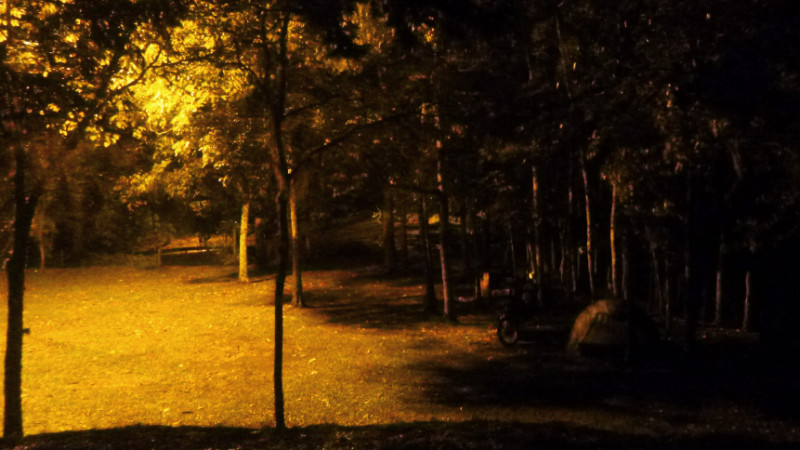
 After the third day of rehydration, I felt strong enough to get moving although the headache was still with me. I ate an early breakfast but then made the mistake of going back to bed. It was approaching 11 when I awoke again. I had made up my mind to go to Medellin.
After the third day of rehydration, I felt strong enough to get moving although the headache was still with me. I ate an early breakfast but then made the mistake of going back to bed. It was approaching 11 when I awoke again. I had made up my mind to go to Medellin.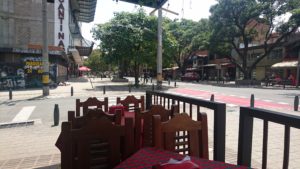 Awaking with the sun shining more insistently through the curtains, I quietly packed my bag and left my slumbering companions with a quiet click of the door latch. The morning was like a perfect Spring day in England, warm and bright with the dappled shade from the trees lining the Colombian avenues and I soon settled on a corner table on the patio of a street cafe a block away.
Awaking with the sun shining more insistently through the curtains, I quietly packed my bag and left my slumbering companions with a quiet click of the door latch. The morning was like a perfect Spring day in England, warm and bright with the dappled shade from the trees lining the Colombian avenues and I soon settled on a corner table on the patio of a street cafe a block away.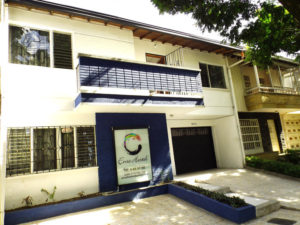 After a short walk, I was at Enso hostel, cheap but roomy with a large common area. It looked like a party hostel but didn’t seem too noisy. Mike was the gregarious proprietor, an ex-construction worker from Britain who had been here 9 years and taken over Enso in the last few months. He pointed to the Metro map painted on the wall and told me about the cable cars and Comuna 13, the site of the bloody “Operation Orion” drug offensive of 2002, basically a two-day war on the streets.
After a short walk, I was at Enso hostel, cheap but roomy with a large common area. It looked like a party hostel but didn’t seem too noisy. Mike was the gregarious proprietor, an ex-construction worker from Britain who had been here 9 years and taken over Enso in the last few months. He pointed to the Metro map painted on the wall and told me about the cable cars and Comuna 13, the site of the bloody “Operation Orion” drug offensive of 2002, basically a two-day war on the streets.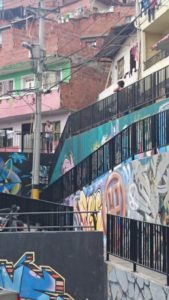 Enso was cheap, in a good location with a free breakfast. The communal area was a bright covered patio area ideal for catching up on my online work.
Enso was cheap, in a good location with a free breakfast. The communal area was a bright covered patio area ideal for catching up on my online work.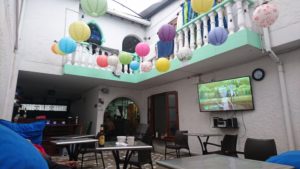 It doesn’t matter, I would have done the voyage anyway.
It doesn’t matter, I would have done the voyage anyway.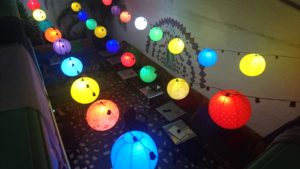 Enso hostel was proving to be annoyingly noisy. Not volume wise but quantity. How can anyone watch a movie and listen to rap at the same time? Hence the move to Samarian.
Enso hostel was proving to be annoyingly noisy. Not volume wise but quantity. How can anyone watch a movie and listen to rap at the same time? Hence the move to Samarian.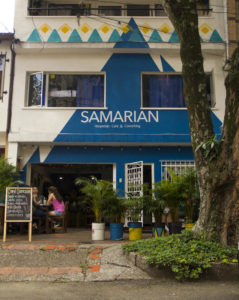 Tanya, an attractive, petite and competent Colombian receptionist welcomed me with a smile and functional English. She ran the place almost single-handed every morning, cooked a nice breakfast and made really thick Mango juices. I ate eggs and avocado with Mango juice every morning.
Tanya, an attractive, petite and competent Colombian receptionist welcomed me with a smile and functional English. She ran the place almost single-handed every morning, cooked a nice breakfast and made really thick Mango juices. I ate eggs and avocado with Mango juice every morning.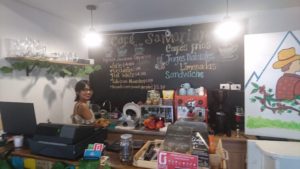 Looking at the Metro map, Caribe station was right next to the bus terminal and Floresta was a short walk from Samarian Hostel. Trip advisor indicated the bus at 20:30 but I thought I’d get there early.
Looking at the Metro map, Caribe station was right next to the bus terminal and Floresta was a short walk from Samarian Hostel. Trip advisor indicated the bus at 20:30 but I thought I’d get there early.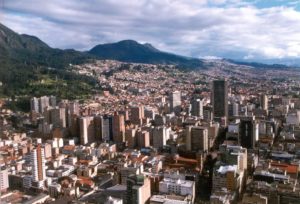 Six days later I check out of El Dorado under £30 for 6 days. If Wiltshire Council hadn’t changed the rules in their favour and started charging Council Tax on empty properties then I could afford to live here almost solely on the income of my flat. As it is, I’m paying off the banks and the government and then bleeding away my savings in order to survive. After a Mango smoothy at the market, £0.65, I flip-flop my way up to the bus terminal and board the luxurious Berlinas bus to Bogota. Power and WiFi means I can liaise with my AirBnB host along the way.
Six days later I check out of El Dorado under £30 for 6 days. If Wiltshire Council hadn’t changed the rules in their favour and started charging Council Tax on empty properties then I could afford to live here almost solely on the income of my flat. As it is, I’m paying off the banks and the government and then bleeding away my savings in order to survive. After a Mango smoothy at the market, £0.65, I flip-flop my way up to the bus terminal and board the luxurious Berlinas bus to Bogota. Power and WiFi means I can liaise with my AirBnB host along the way.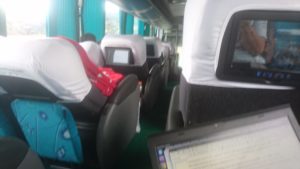 The bus stops at Vado Real, rocking across the shale covered car park leaving a dust cloud in our wake. The passengers start to disembark after the driver says something in Spanish but I stay behind. Later, he beckons for me to move. It seems he is on a break and I absorb some of the sun’s warmth to take back into the airconditioning when we board later.
The bus stops at Vado Real, rocking across the shale covered car park leaving a dust cloud in our wake. The passengers start to disembark after the driver says something in Spanish but I stay behind. Later, he beckons for me to move. It seems he is on a break and I absorb some of the sun’s warmth to take back into the airconditioning when we board later. In the cafe, I spot Mike and Melissa. They are on their way back to San Gil. The small world feels smaller with each chance meeting.
In the cafe, I spot Mike and Melissa. They are on their way back to San Gil. The small world feels smaller with each chance meeting.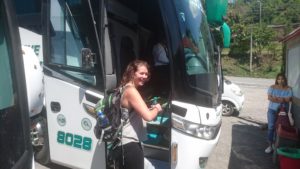 5pm arriving on the outskirts of Bogota, the traffic is slow and the grey clouds low in the sky threatening rain. Only the clouds are not so much low as the city is high, eight and a half thousand feet above sea level.
5pm arriving on the outskirts of Bogota, the traffic is slow and the grey clouds low in the sky threatening rain. Only the clouds are not so much low as the city is high, eight and a half thousand feet above sea level.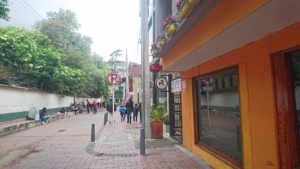 Rua 116 is in a quiet back street and I sign in at reception: top bunk in a dorm on the top floor. If I have altitude sickness, this won’t help. The stairs are an effort to climb and I pile everything on the bunk and take advantage of my current mobility to go back downstairs and wander around the block. I find a coffee bar on the corner of the main road. This could be a ‘Costa’ or ‘Starbucks’ in any city in the world. I could be in London. I’m cold: the only person wearing shorts and flip-flops. It’s 13C. Normal for Bogota, and I take my Latte upstairs to work out my game plan. I have no energy for shopping or sightseeing. I want to get warm and get some energy but I don’t feel hungry.
Rua 116 is in a quiet back street and I sign in at reception: top bunk in a dorm on the top floor. If I have altitude sickness, this won’t help. The stairs are an effort to climb and I pile everything on the bunk and take advantage of my current mobility to go back downstairs and wander around the block. I find a coffee bar on the corner of the main road. This could be a ‘Costa’ or ‘Starbucks’ in any city in the world. I could be in London. I’m cold: the only person wearing shorts and flip-flops. It’s 13C. Normal for Bogota, and I take my Latte upstairs to work out my game plan. I have no energy for shopping or sightseeing. I want to get warm and get some energy but I don’t feel hungry.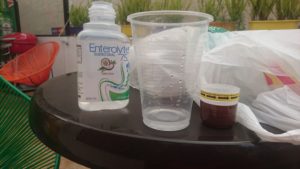 I had severe and extreme dehydration plus signs of an early throat infection. Heart and blood pressure were good. I was prescribed some concentrated electrolyte-rich coconut water for three days and a concentrated antiseptic gargle. I was to sip small amounts of this special coconut water every 5 minutes in order to absorb the nutrients. A three-day mission. Each day I poured 10 or 15ml amounts into a small cup and downed them one by one and set a 5 minute timer between each. The bottle was 400ml so it was a three to four hour task. I felt good about that as it kept me focussed and felt I was optimistically on the road to recovery.
I had severe and extreme dehydration plus signs of an early throat infection. Heart and blood pressure were good. I was prescribed some concentrated electrolyte-rich coconut water for three days and a concentrated antiseptic gargle. I was to sip small amounts of this special coconut water every 5 minutes in order to absorb the nutrients. A three-day mission. Each day I poured 10 or 15ml amounts into a small cup and downed them one by one and set a 5 minute timer between each. The bottle was 400ml so it was a three to four hour task. I felt good about that as it kept me focussed and felt I was optimistically on the road to recovery.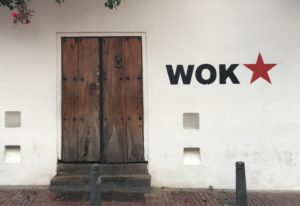 Day by day, I felt a little better and strength returned to my limbs. I had to remember to drink water too. The tap water in Bogota is clean enough if a little over chlorinated. By the second night, I felt well enough to go out to dinner but could only manage half the Thai Green Curry. Not cheap by Colombian standards. Still, it was some nutrition and fluids all in one.
Day by day, I felt a little better and strength returned to my limbs. I had to remember to drink water too. The tap water in Bogota is clean enough if a little over chlorinated. By the second night, I felt well enough to go out to dinner but could only manage half the Thai Green Curry. Not cheap by Colombian standards. Still, it was some nutrition and fluids all in one. Feb 14 Wednesday
Feb 14 Wednesday Steve asked how it went and I said it was good, better than my first time although I nearly passed out. Ryan said “Actually, you did. You were gone for a couple of minutes.” I had no recollection of that but it made sense of what Greg had told me: “I saw you die, man.” Nothing in my memory, dreams or otherwise. It was like two minutes had been cut away and life seamlessly spliced back together so all I experienced was a blink.
Steve asked how it went and I said it was good, better than my first time although I nearly passed out. Ryan said “Actually, you did. You were gone for a couple of minutes.” I had no recollection of that but it made sense of what Greg had told me: “I saw you die, man.” Nothing in my memory, dreams or otherwise. It was like two minutes had been cut away and life seamlessly spliced back together so all I experienced was a blink.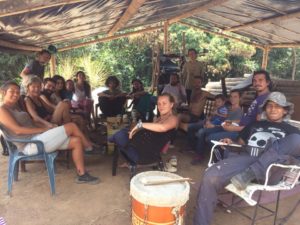 After breakfast, we sat around the table in the new Maloka for a final gathering as there were so many of us leaving. Greg gave me a gift of tourmaline quartz, as he was so moved by my Kambo session. I was honoured.
After breakfast, we sat around the table in the new Maloka for a final gathering as there were so many of us leaving. Greg gave me a gift of tourmaline quartz, as he was so moved by my Kambo session. I was honoured.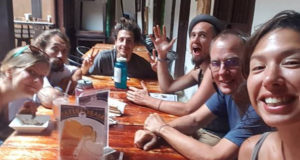 Living simply out in the countryside with wonderful fresh food is beautiful but eventually, small things become luxuries, like chocolate, cookies and even dry crackers and it’s easy to overdo it landing back into so-called civilisation. And so:, onion rings, veggie burger, fries, frappe and 70% chocolate brownie was scoffed to the point of nausea.
Living simply out in the countryside with wonderful fresh food is beautiful but eventually, small things become luxuries, like chocolate, cookies and even dry crackers and it’s easy to overdo it landing back into so-called civilisation. And so:, onion rings, veggie burger, fries, frappe and 70% chocolate brownie was scoffed to the point of nausea.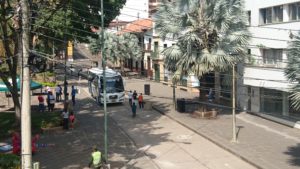 Out in the park, families mingle and children play. Police are on the streets but they are there quietly watching their community rather than for issuing fines and penalties and generally milking the public. there’s a safer feeling here than back in the UK. The people appearing more friendly and generally happier.
Out in the park, families mingle and children play. Police are on the streets but they are there quietly watching their community rather than for issuing fines and penalties and generally milking the public. there’s a safer feeling here than back in the UK. The people appearing more friendly and generally happier.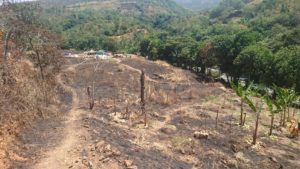 Feb 11th Sunday.
Feb 11th Sunday.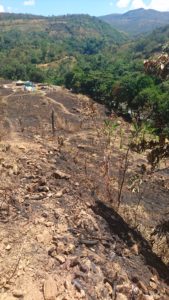 My foot slipped and my left flip flop broke. I was bare-foot with pickaxe and water container. The charred floor was cool underfoot except where the sun penetrated the canopy. My built-in sensors for detecting underground fire. We spotted a few small plumes on top of the ridge and doused them with water. As small as they were, the heat was intense and the charred roots and branches hissed and steamed a long time during their dousing taking surprising amounts of water. The bigger plumes were down the steep sides of the mountain. Peter had already set off down the side to find the source of the biggest plume and various people went to help.
My foot slipped and my left flip flop broke. I was bare-foot with pickaxe and water container. The charred floor was cool underfoot except where the sun penetrated the canopy. My built-in sensors for detecting underground fire. We spotted a few small plumes on top of the ridge and doused them with water. As small as they were, the heat was intense and the charred roots and branches hissed and steamed a long time during their dousing taking surprising amounts of water. The bigger plumes were down the steep sides of the mountain. Peter had already set off down the side to find the source of the biggest plume and various people went to help. Peter had turned the original charcoal pit into a pond by putting a spring water hose into it and we gathered some of the smouldering logs around the orchard and dumped them hissing into the pool.
Peter had turned the original charcoal pit into a pond by putting a spring water hose into it and we gathered some of the smouldering logs around the orchard and dumped them hissing into the pool.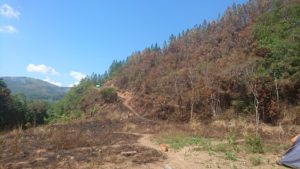 Feb 12th Mon At breakfast, there was no more evidence of smoke or fire but half the hillside looked like it was now entering Autumn with the leaves turning brown. It looked as if some of the trees were not going to survive the blaze. I didn’t really know if they would or not.
Feb 12th Mon At breakfast, there was no more evidence of smoke or fire but half the hillside looked like it was now entering Autumn with the leaves turning brown. It looked as if some of the trees were not going to survive the blaze. I didn’t really know if they would or not.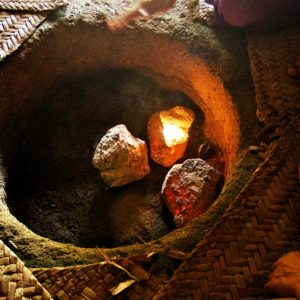 Feb 10th Saturday
Feb 10th Saturday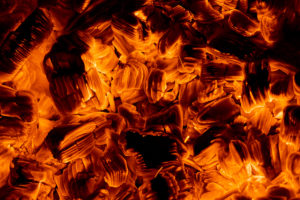 His charcoal burning was the source of the blaze which caught the tinder-dry grass not far from the charcoal pit. There had been no rain for over a month; this was the dry season. Luis lit a cigar and prayed for rain to come before the cigar was finished. I was Skeptical, as usual, even after all the spiritual ceremonies I had immersed myself in. Before the cigar was finished, it started to rain. Coincidence? The timing was immaculate but admittedly the rainfall wasn’t heavy enough to douse the fires. We went to bed trusting all would be OK. Although the power of Peter’s remorse kept him up and checking the mountains in the night.
His charcoal burning was the source of the blaze which caught the tinder-dry grass not far from the charcoal pit. There had been no rain for over a month; this was the dry season. Luis lit a cigar and prayed for rain to come before the cigar was finished. I was Skeptical, as usual, even after all the spiritual ceremonies I had immersed myself in. Before the cigar was finished, it started to rain. Coincidence? The timing was immaculate but admittedly the rainfall wasn’t heavy enough to douse the fires. We went to bed trusting all would be OK. Although the power of Peter’s remorse kept him up and checking the mountains in the night.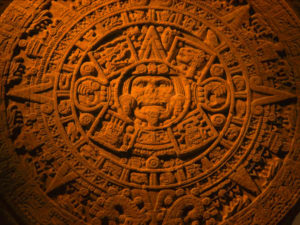 Feb 8th Ayahuasca 3
Feb 8th Ayahuasca 3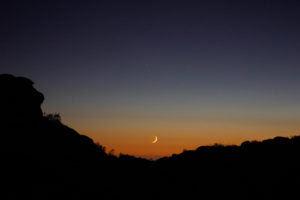 Feb 9th Ayahuasca 4
Feb 9th Ayahuasca 4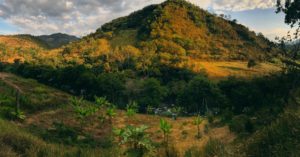 Saturday 3rd Feb,
Saturday 3rd Feb,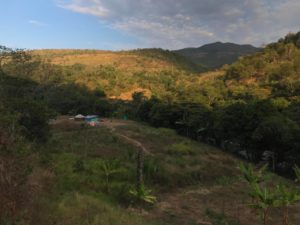 Apart from the compost toilet, the kitchen is the only structure yet established on the land: a bamboo shelter with a black polythene roof with two tents one side and a yurt and tent the other. Crystal clear mountain spring water flows constantly from a pipe resting on the river bank and is extended to irrigate the bananas, Oranges and papaya. Facilities are basic but it’s all we really need. Nothing else is required. The water needs no filter and tastes cool and sweet straight out of the ground. The flow is persistent and the unfamiliarity of watching the flow looks wasteful but is the epitome of abundance. Nature provides all we need and the water never stops flowing.
Apart from the compost toilet, the kitchen is the only structure yet established on the land: a bamboo shelter with a black polythene roof with two tents one side and a yurt and tent the other. Crystal clear mountain spring water flows constantly from a pipe resting on the river bank and is extended to irrigate the bananas, Oranges and papaya. Facilities are basic but it’s all we really need. Nothing else is required. The water needs no filter and tastes cool and sweet straight out of the ground. The flow is persistent and the unfamiliarity of watching the flow looks wasteful but is the epitome of abundance. Nature provides all we need and the water never stops flowing.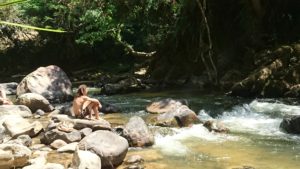 After lunch, it’s “river time.” The land levels out under some trees near some rapids. The water here is fresh and cool spilling over time-worn boulders singing its song of relaxation to the people lounging in the hammocks in the trees on the bank. It’s a long break after a delicious lunch and I grab an extra 20 guilty minutes sleep in the hammock when everyone resumes work. It was much needed and I took a little more energy to my tasks.
After lunch, it’s “river time.” The land levels out under some trees near some rapids. The water here is fresh and cool spilling over time-worn boulders singing its song of relaxation to the people lounging in the hammocks in the trees on the bank. It’s a long break after a delicious lunch and I grab an extra 20 guilty minutes sleep in the hammock when everyone resumes work. It was much needed and I took a little more energy to my tasks. half my age and twice as energetic. Steve and Mitchell are from the UK. Steve, an ironman enthusiast and Mitchell both attending regular CrossFit sessions in San Gil, as well as physical labour. There are some people from Bucaramanga here too that don’t speak English but we all work together happily
half my age and twice as energetic. Steve and Mitchell are from the UK. Steve, an ironman enthusiast and Mitchell both attending regular CrossFit sessions in San Gil, as well as physical labour. There are some people from Bucaramanga here too that don’t speak English but we all work together happily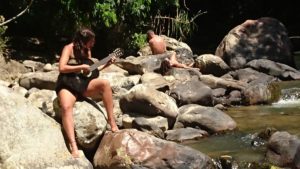 After lunch, it is river time and no more work is done for the rest of the afternoon. We pack up and load up the Jeep to go back to La Palmita. It’s only 12 Km but it takes half an hour as the track is so rough. My right ankle is swollen and painful and I duck out of going back to Nuevos Horizontes the next day.
After lunch, it is river time and no more work is done for the rest of the afternoon. We pack up and load up the Jeep to go back to La Palmita. It’s only 12 Km but it takes half an hour as the track is so rough. My right ankle is swollen and painful and I duck out of going back to Nuevos Horizontes the next day. My swollen ankle is painful to stand on and needs some respite from the sandflies. I keep it elevated for most of the day.
My swollen ankle is painful to stand on and needs some respite from the sandflies. I keep it elevated for most of the day.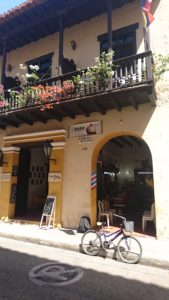 e before dawn in the sweaty Cartegena air and lay still in Pantelisa’s cockpit watching the sky slowly brighten behind the lights on the dockside cranes.
e before dawn in the sweaty Cartegena air and lay still in Pantelisa’s cockpit watching the sky slowly brighten behind the lights on the dockside cranes.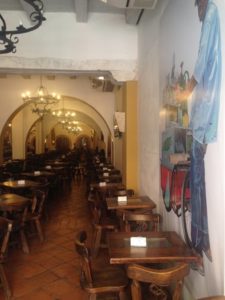 Espiritu Santu is a cafeteria in the heart of the old town. It’s a wide and deep hall reminiscent of a school refectory although it is waiter service. Fillet of fish with fries and coconut rice with a salad and two juices for £5.50. Not as cheap as outside the city but still a great deal. The hall is busy and reverberates with boisterous latino chatter, too much for concentrating on writing so I browse the internet on my phone instead.
Espiritu Santu is a cafeteria in the heart of the old town. It’s a wide and deep hall reminiscent of a school refectory although it is waiter service. Fillet of fish with fries and coconut rice with a salad and two juices for £5.50. Not as cheap as outside the city but still a great deal. The hall is busy and reverberates with boisterous latino chatter, too much for concentrating on writing so I browse the internet on my phone instead.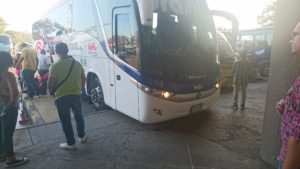 The Expreso Brasilia bus is modern with the most comfortable chairs that recline well back. National Express in the UK could learn a lot here. The air conditioning was set for maximum cooling which is not so bad sitting with the sun coming through the window but with the onset of nightfall, arctic conditions ensued. Outside the city, the fun started, horn blaring and trucks being overtaken in the dark along highway 90. It reminded me of the journey along the Sinai from Sharm el Sheik to Cairo. I turn my focus to updating my blog until my battery dips into the red at 5%.
The Expreso Brasilia bus is modern with the most comfortable chairs that recline well back. National Express in the UK could learn a lot here. The air conditioning was set for maximum cooling which is not so bad sitting with the sun coming through the window but with the onset of nightfall, arctic conditions ensued. Outside the city, the fun started, horn blaring and trucks being overtaken in the dark along highway 90. It reminded me of the journey along the Sinai from Sharm el Sheik to Cairo. I turn my focus to updating my blog until my battery dips into the red at 5%.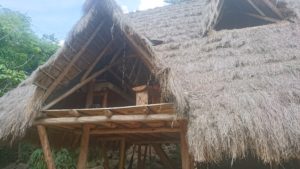 At the foot of the garden is the river, cool enough to be refreshing but warm enough to bath in. It has none of that fertilizer smell that runs off the land into British rivers. I strip off to cleanse myself in the pure cool water and stay well below the surface while a whitewater raft drifts by full of whooping adventure seekers. I wait until they are flushed away before shaking off the water, getting dressed and settling in at La Palmita.
At the foot of the garden is the river, cool enough to be refreshing but warm enough to bath in. It has none of that fertilizer smell that runs off the land into British rivers. I strip off to cleanse myself in the pure cool water and stay well below the surface while a whitewater raft drifts by full of whooping adventure seekers. I wait until they are flushed away before shaking off the water, getting dressed and settling in at La Palmita.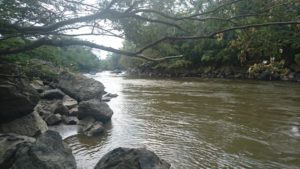
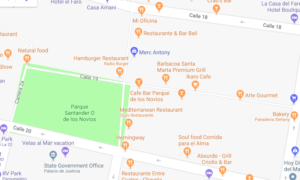 Santa Marta is a grid system of streets: Calle x by Carrera y so it’s easy to guess a route to roughly where you want to go. Ikaro is in a pedestrian precinct near Parque de Los Novios on Calle 19. I leave the bike at the side of Calle 18 and walk around to Ikaro and up to the counter. I spot Helmut and Inka out the back of the kitchen and stroll around and treated to a nice cup of Mate Green Tea. No sign of Jason. I book into the hotel across the road and flick on the air conditioning and spend a cool couple of hours online.
Santa Marta is a grid system of streets: Calle x by Carrera y so it’s easy to guess a route to roughly where you want to go. Ikaro is in a pedestrian precinct near Parque de Los Novios on Calle 19. I leave the bike at the side of Calle 18 and walk around to Ikaro and up to the counter. I spot Helmut and Inka out the back of the kitchen and stroll around and treated to a nice cup of Mate Green Tea. No sign of Jason. I book into the hotel across the road and flick on the air conditioning and spend a cool couple of hours online.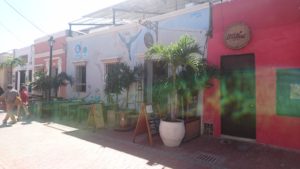 When night descends I emerge into the street to buzzing activity, music and crowds. This place is busy. I fetch the bike off the street and push it along the precinct and park it in the well lit Plaza next to a cleaner looking bike and go for dinner at Ikaro. It was good catching up with Inka and Helmut. They had been upstairs in the double suite above my dorm at Aloha but our paths never really crossed.
When night descends I emerge into the street to buzzing activity, music and crowds. This place is busy. I fetch the bike off the street and push it along the precinct and park it in the well lit Plaza next to a cleaner looking bike and go for dinner at Ikaro. It was good catching up with Inka and Helmut. They had been upstairs in the double suite above my dorm at Aloha but our paths never really crossed.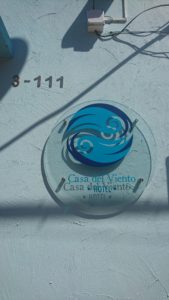 I awoke early and continued updating the blog to the point of arriving in Colombia about 2 weeks back. I was living my life faster than I could write about it. I went for breakfast at Ikaro before the 10.30 cut off and checked out of the hotel before the noon deadline then hit the road to Cartegena. Carrera 4 led me south straight onto highway 90 along the isthmus that had been visible from Aloha. The Cienaga outskirts are depressingly run down and polluted. A contrast to the beautiful sunsets seen from way up in the mountains.
I awoke early and continued updating the blog to the point of arriving in Colombia about 2 weeks back. I was living my life faster than I could write about it. I went for breakfast at Ikaro before the 10.30 cut off and checked out of the hotel before the noon deadline then hit the road to Cartegena. Carrera 4 led me south straight onto highway 90 along the isthmus that had been visible from Aloha. The Cienaga outskirts are depressingly run down and polluted. A contrast to the beautiful sunsets seen from way up in the mountains.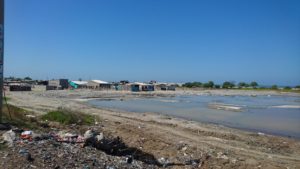 straights and sometimes along the generous hard-shoulders when the oncoming traffic was busy.
straights and sometimes along the generous hard-shoulders when the oncoming traffic was busy.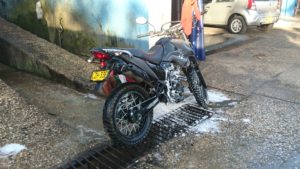 The Cartegena rush hour is frantic, tight and noisy, elbow to elbow with motorcycles, taxis and buses. The licencing laws ignore motorcycles under a certain size which results in swarms of 180cc and below bikes. As soon as the dock cranes become visible, I know I’m home. I see Mike and Toni on the way to the bike wash so they get to see Minca mud rather than a pristine bike.
The Cartegena rush hour is frantic, tight and noisy, elbow to elbow with motorcycles, taxis and buses. The licencing laws ignore motorcycles under a certain size which results in swarms of 180cc and below bikes. As soon as the dock cranes become visible, I know I’m home. I see Mike and Toni on the way to the bike wash so they get to see Minca mud rather than a pristine bike.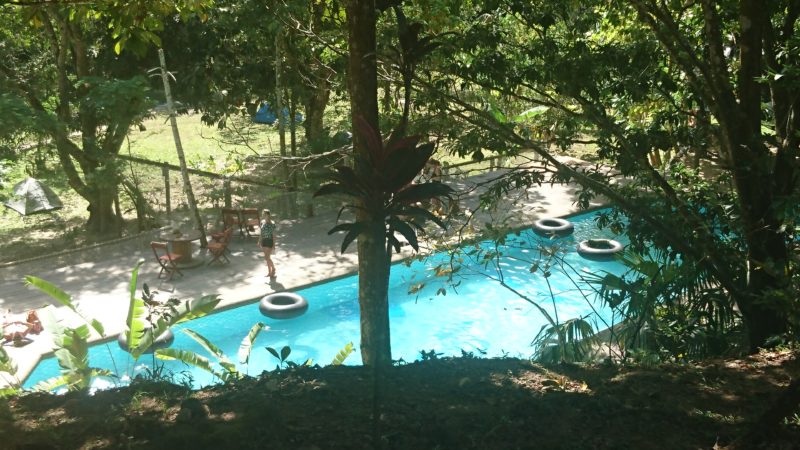 I awoke before lunch, hungry but with a feeling of profound contentedness. That ‘never again’ feeling was now a distant memory and I was looking forward to tonight’s second ceremony. It was to be lighter, focussed on celebration with a later start.
I awoke before lunch, hungry but with a feeling of profound contentedness. That ‘never again’ feeling was now a distant memory and I was looking forward to tonight’s second ceremony. It was to be lighter, focussed on celebration with a later start.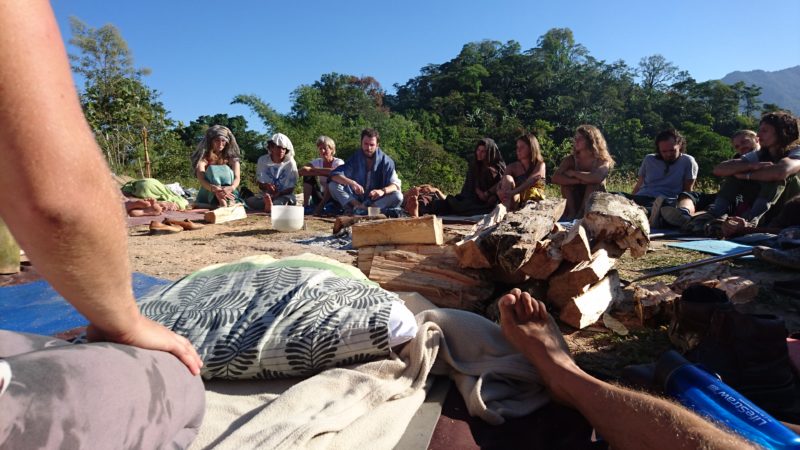 In the morning, I awoke just before dawn and people gathered around the greying embers of the fire to close the retreat and share experiences one by one. I didn’t know what to say but the right words seemed to come out on their own without thinking about them. A deep feeling of gratitude, not just for the Ayahuasca but all the processes leading up to it and beyond. Every part of the retreat was like a jigsaw piece that interlocked with the next to build a larger picture of part of the universe and my part in it.
In the morning, I awoke just before dawn and people gathered around the greying embers of the fire to close the retreat and share experiences one by one. I didn’t know what to say but the right words seemed to come out on their own without thinking about them. A deep feeling of gratitude, not just for the Ayahuasca but all the processes leading up to it and beyond. Every part of the retreat was like a jigsaw piece that interlocked with the next to build a larger picture of part of the universe and my part in it. I rode the opposite direction to the way I came and followed the loop around via Los Pinos and Pozo Azul. It was an easier route with far more paving and probably took the same amount of time even though the distance was further. I spotted Sam in a juice bar and went to offer her the cup of tea that I’d promised the day before. Herbert and Alle were there too so the offer was quickly forgotten as greetings were exchanged. The juices were nectar to my taste buds. Greg, Adam, Sheryl and Jason joined us and so we had a mini-reunion tagged straight onto the Aloha departure.
I rode the opposite direction to the way I came and followed the loop around via Los Pinos and Pozo Azul. It was an easier route with far more paving and probably took the same amount of time even though the distance was further. I spotted Sam in a juice bar and went to offer her the cup of tea that I’d promised the day before. Herbert and Alle were there too so the offer was quickly forgotten as greetings were exchanged. The juices were nectar to my taste buds. Greg, Adam, Sheryl and Jason joined us and so we had a mini-reunion tagged straight onto the Aloha departure.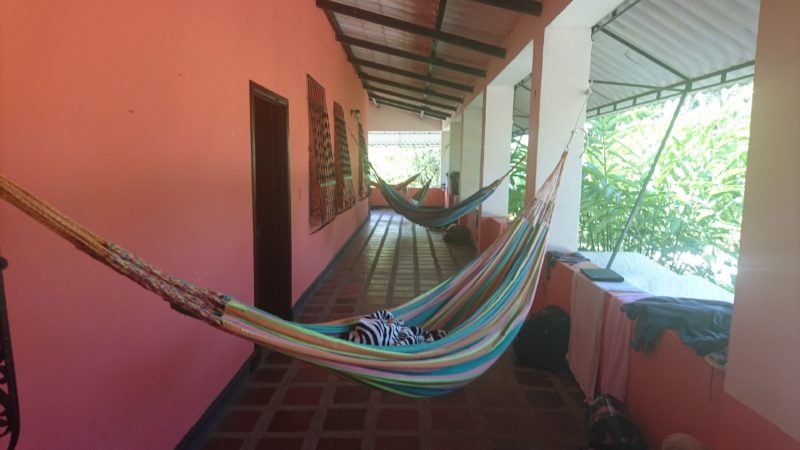 There were four hammocks in the corridor and it looked as if I was last to turn in. I kicked off my flip-flops and settled down wearing my shorts and t-shirt with a blanket over me and drifted off to a fitful sleep. I woke at dawn slightly chilled. It was a cold night and I got up for an early breakfast. Greg, Rosalie and I went down to the river for a swim. Bracing mountain water got the blood flowing.
There were four hammocks in the corridor and it looked as if I was last to turn in. I kicked off my flip-flops and settled down wearing my shorts and t-shirt with a blanket over me and drifted off to a fitful sleep. I woke at dawn slightly chilled. It was a cold night and I got up for an early breakfast. Greg, Rosalie and I went down to the river for a swim. Bracing mountain water got the blood flowing. Thursday felt like a rest day. I needed it, not because of the Kambo but because of the Men’s Circle and Purpose Spark process cracking open my psychological shell.
Thursday felt like a rest day. I needed it, not because of the Kambo but because of the Men’s Circle and Purpose Spark process cracking open my psychological shell.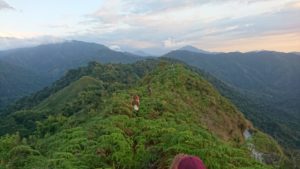 Shortly after five, we headed down the mountain ridge for the sunset hike. It wasn’t far to a small plateau on the peak at the end of the ridge below Aloha and we watched the sun descend over Cartegena and beyond.
Shortly after five, we headed down the mountain ridge for the sunset hike. It wasn’t far to a small plateau on the peak at the end of the ridge below Aloha and we watched the sun descend over Cartegena and beyond.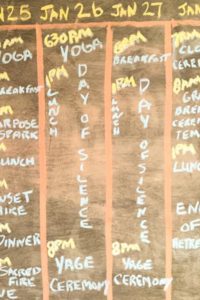 Friday morning, I was beginning to feel flashes of doubt. It could be apprehension or fear of the unknown, but both are a disease of thinking and I let those thoughts go. I felt fulfilled and at peace with all the processes that led up to today and I felt I didn’t really need the ayahuasca but Miguel and Luis had reassured me that it is good for opening us up to the spirit world, where consciousness lives… and for me, where consciousness lives is worth exploring.
Friday morning, I was beginning to feel flashes of doubt. It could be apprehension or fear of the unknown, but both are a disease of thinking and I let those thoughts go. I felt fulfilled and at peace with all the processes that led up to today and I felt I didn’t really need the ayahuasca but Miguel and Luis had reassured me that it is good for opening us up to the spirit world, where consciousness lives… and for me, where consciousness lives is worth exploring.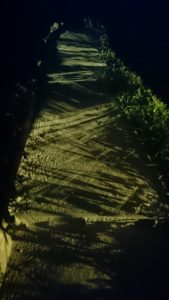
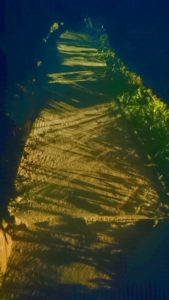 I wanted to purge but I felt empty and moved slowly toward Miguel and Luis for some water. Copious amounts of water stimulates the purge. Standing up on shaking legs, I downed a glass of water. I didn’t want another… “Never again,” I thought as I staggered back to the ridge and laid in the grass.
I wanted to purge but I felt empty and moved slowly toward Miguel and Luis for some water. Copious amounts of water stimulates the purge. Standing up on shaking legs, I downed a glass of water. I didn’t want another… “Never again,” I thought as I staggered back to the ridge and laid in the grass.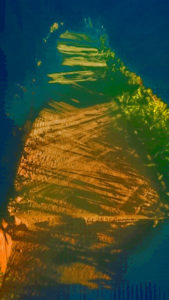 The room was intense orange and green with shadows taking on geometric patterns. It was blissful sitting there letting everything go both in body and mind but I was aware that others would need it too so didn’t stay too long. The benefit of the trip to the toilet was that I was led back to my bed. I’m thankful for the help I received and remembered the message from the Kambo: “Allow others to help you…” Thank you, Miguel and Bryan.
The room was intense orange and green with shadows taking on geometric patterns. It was blissful sitting there letting everything go both in body and mind but I was aware that others would need it too so didn’t stay too long. The benefit of the trip to the toilet was that I was led back to my bed. I’m thankful for the help I received and remembered the message from the Kambo: “Allow others to help you…” Thank you, Miguel and Bryan.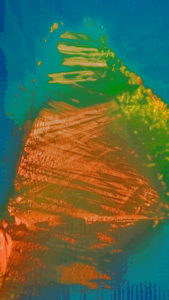 ame to me, his silhouette vivid out of the night sky and asked: “How you doing, Okay?” I said I thought I was resisting. He replied “Good, keep going.” laughed and disappeared. I smiled and relaxed into the experience
ame to me, his silhouette vivid out of the night sky and asked: “How you doing, Okay?” I said I thought I was resisting. He replied “Good, keep going.” laughed and disappeared. I smiled and relaxed into the experience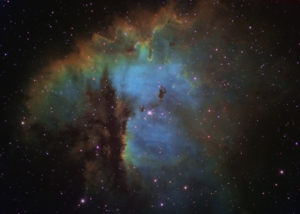 My feet were cold but I could feel they were under the blanket. The tree to my right was violet and turquoise and stood out against the sky. I wished I could photograph it all, it was so beautiful.
My feet were cold but I could feel they were under the blanket. The tree to my right was violet and turquoise and stood out against the sky. I wished I could photograph it all, it was so beautiful. Wednesday morning dawned and I was still nursing fatigue from some sort of stomach bug and didn’t feel like getting up for yoga but I went anyway. Sam was leading this session and she turned out a real joy. Less of a workout than Rike’s session on the first morning after I arrived at the retreat. I was beginning to feel better. Just in time for the Kambo ceremony.
Wednesday morning dawned and I was still nursing fatigue from some sort of stomach bug and didn’t feel like getting up for yoga but I went anyway. Sam was leading this session and she turned out a real joy. Less of a workout than Rike’s session on the first morning after I arrived at the retreat. I was beginning to feel better. Just in time for the Kambo ceremony.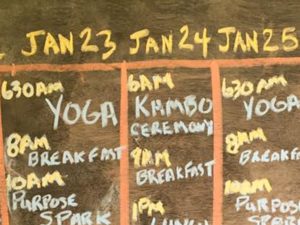 Edward, an 18-year-old from England was feeling ill and came to say he wasn’t going to do the Kambo as he felt so ill. We said “Kambo is a medicine, you’re closer to the Kambo than we are since it makes you purge anyway. He turned and his illness caused him to turn and projectile vomit into the weeds before returning to bed.”
Edward, an 18-year-old from England was feeling ill and came to say he wasn’t going to do the Kambo as he felt so ill. We said “Kambo is a medicine, you’re closer to the Kambo than we are since it makes you purge anyway. He turned and his illness caused him to turn and projectile vomit into the weeds before returning to bed.”
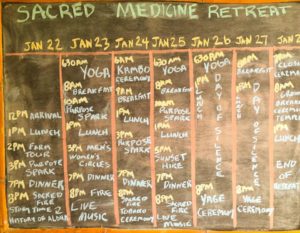 ning and there was no wifi or signal at Aloha so I fired up the bike to explore Minca, get some more offroad practice and maybe catch up on some writing. I do like multiple reasons. In a way, going downhill is harder than coming up. It’s easier to come off under braking especially locking the front wheel. Best not touch the front brake if possible.
ning and there was no wifi or signal at Aloha so I fired up the bike to explore Minca, get some more offroad practice and maybe catch up on some writing. I do like multiple reasons. In a way, going downhill is harder than coming up. It’s easier to come off under braking especially locking the front wheel. Best not touch the front brake if possible.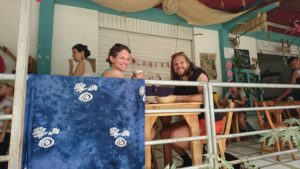 I crossed the small bamboo bridge across the river and made my way back toward where I parked the bike and heard someone call “Paul!” It was Herbert and Alle in a cafe and I went to join them for a while. They had hiked up to Pozo Azul waterfall and recommended I go since I had transport. Taking this as another omen, I took the bike up and swam in one of the upper pools where there were no people. The water was cold, straight off the mountains so I was less than a minute, enough for a wash and cool off before riding back down to Minca. the ride was better than the swim.
I crossed the small bamboo bridge across the river and made my way back toward where I parked the bike and heard someone call “Paul!” It was Herbert and Alle in a cafe and I went to join them for a while. They had hiked up to Pozo Azul waterfall and recommended I go since I had transport. Taking this as another omen, I took the bike up and swam in one of the upper pools where there were no people. The water was cold, straight off the mountains so I was less than a minute, enough for a wash and cool off before riding back down to Minca. the ride was better than the swim.


Recent Comments